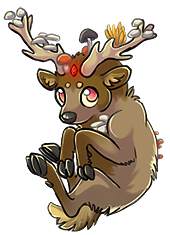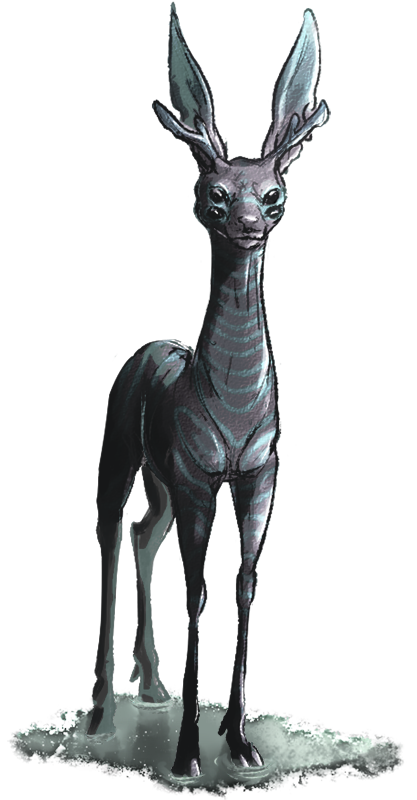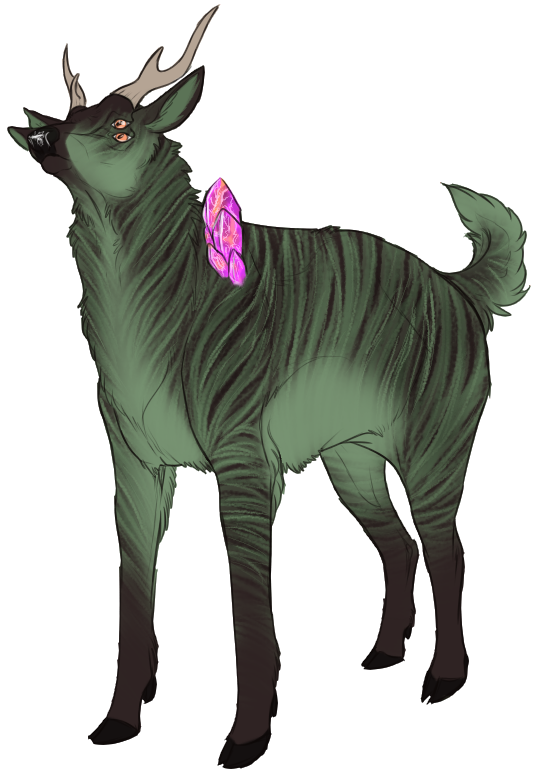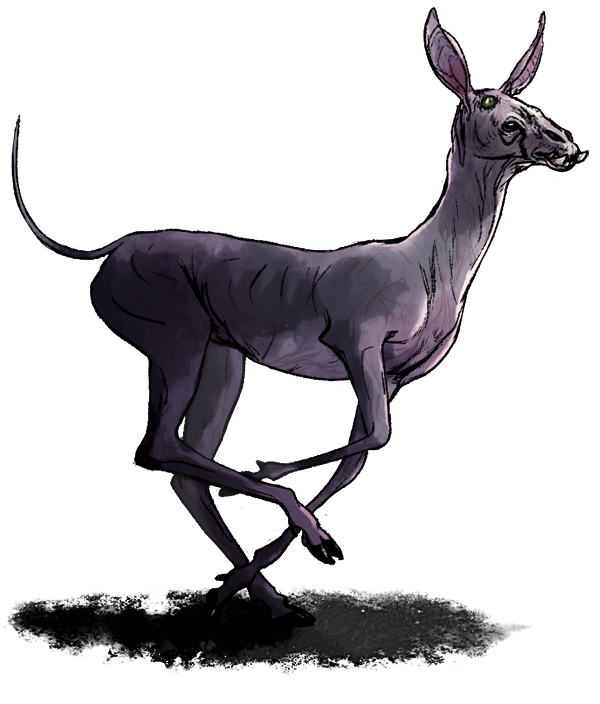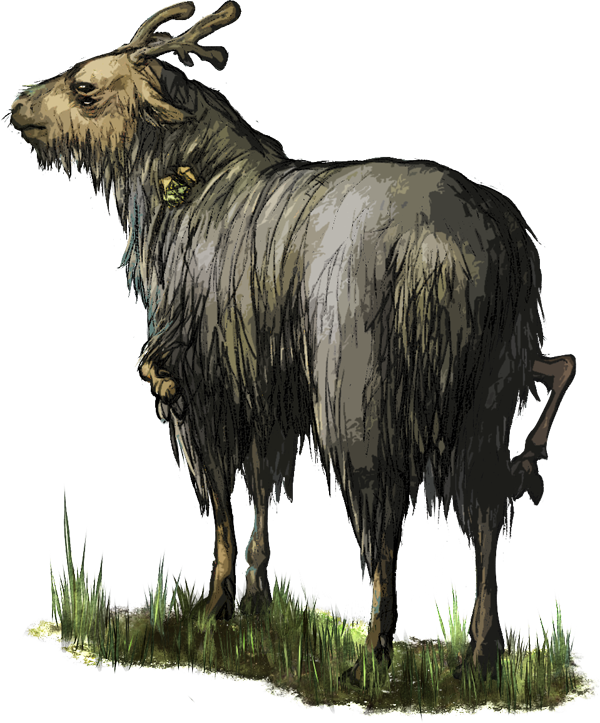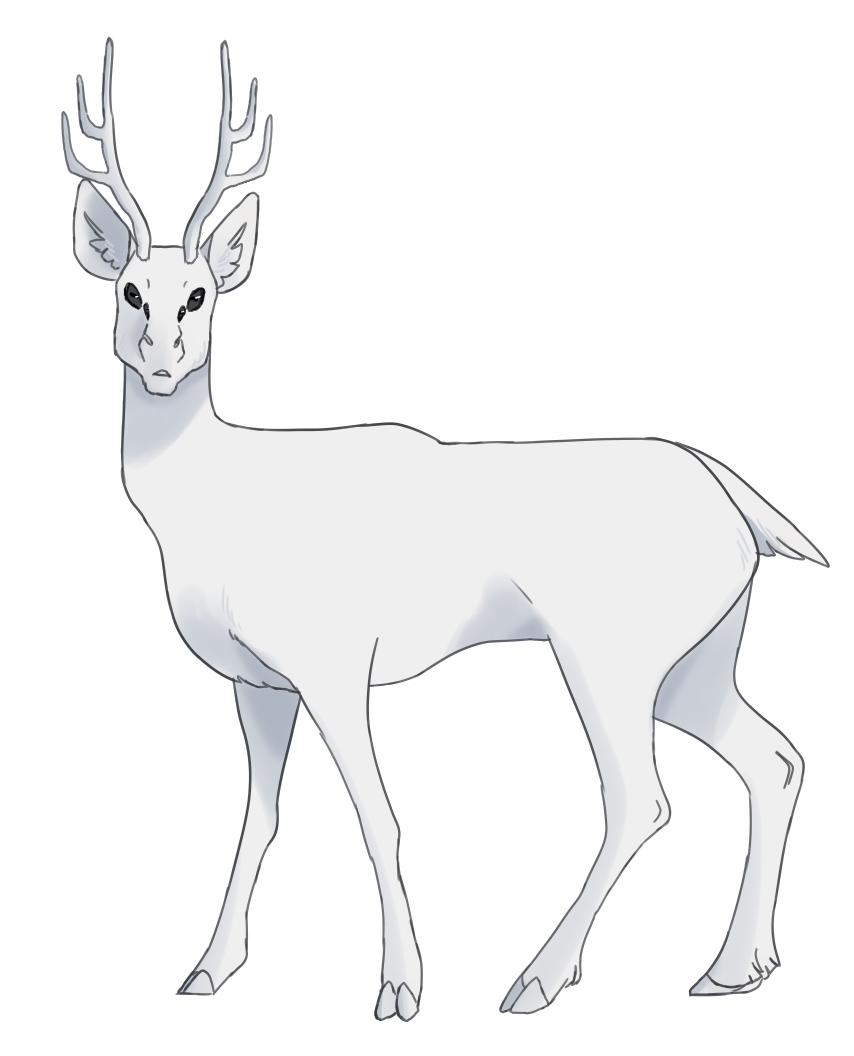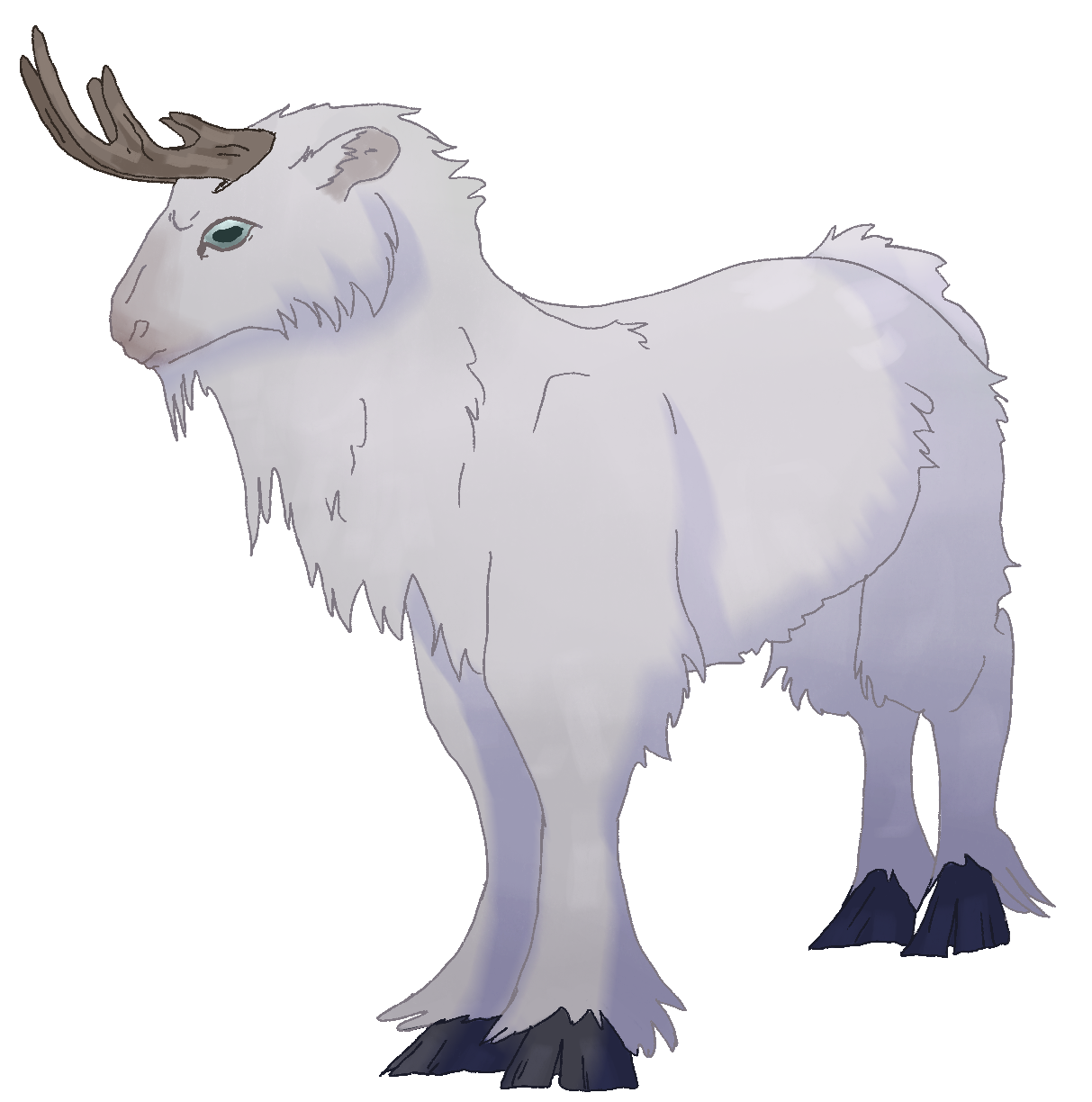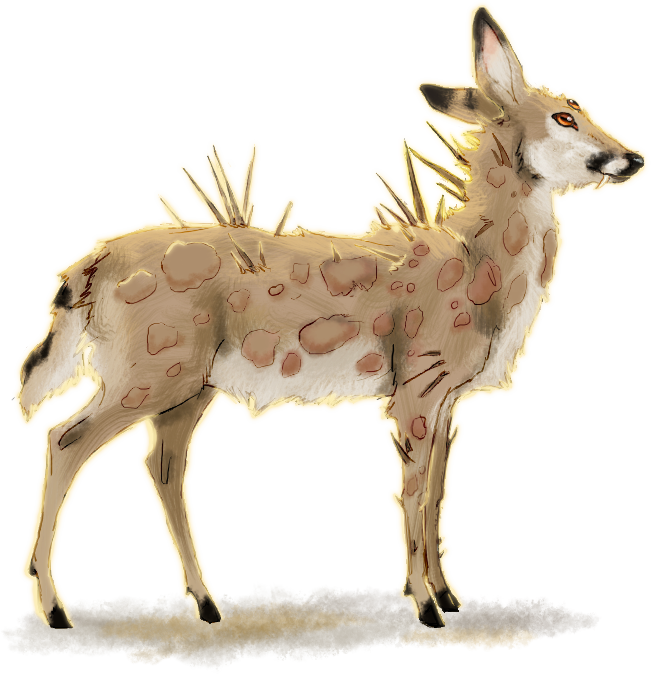CYCLE 120 — Current time: Apr 03 2025, 03:17 AM
| Character Portal |
| For threads pertaining to the general subject of characters on Origin, feel free to post them in this general thread. Otherwise, more specific subjects should go in their designated threads. |
|
Lesser Gembound Guide
|
||||||||||||||||||||||||||||||||||||||||||||||||||||||||||||||||||||||||||||||||||||||||||||||||||||||||||||||||||||||||||||||||||||||||||||||||||||||||||||||||||||||||||||||||||||||||||||||||||||||||||||||||||||||||||||||||||||||||||||||||||||||||||||||||||||||||||||||||||||||||||||||||||||||||||||||||||||||||||||||||||||||||
Huge and wretched, Cave Rats have an inclination to form large packs that can be incredibly dangerous to any Gembound caught in their way, Greater or not. They're just as viable a food source as Cave Deer, particularly in less populated caves, but are far more dangerous. Bites and scratches sustained are prone to becoming infected or bleeding out if left untreated. | ||||||||||||||||||||||||||||||||||||||||||||||||||||||||||||||||||||||||||||||||||||||||||||||||||||||||||||||||||||||||||||||||||||||||||||||||||||||||||||||||||||||||||||||||||||||||||||||||||||||||||||||||||||||||||||||||||||||||||||||||||||||||||||||||||||||||||||||||||||||||||||||||||||||||||||||||||||||||||||||||||||||||
 | Red Rat Location(s): Everywhere Danger Level: Docile, but flighty Diet: Omnivorous scavenger Length: ~ 2 ft (3 ft with tail) Quirk(s): Form large groups Not quite so aggressive as their cousins, Red Rats tend to form larger groups than usual and keep to themselves. Seldom will you find a healthy individual by themselves. They're more likely to scatter than attack when disturbed, but will fight back if cornered. Like the other subspecies, though, they tend to carry disease in their wild, filthy fur and crooked teeth. On the off-chance an individual isn't completely covered in grime, Red Rats have sandy to russet fur—as is their namesake. |
 | Pitch Rat Location(s): Everywhere Danger Level: Aggressive Diet: Obligate carnivores Length: ~ 2 ft (3 ft with tail) Quirk(s): Skilled climbers, hunts in packs Heavier and far meaner than Reds, Pitch Rats cluster into fairly large hunting parties and fight tooth-and-claw over food. They tend to be solitary and wander around until they spot viable prey. A single call is enough to summon every other Pitch Rat in the vicinity and put them all on the uncoordinated attack. Their pelts are dark-colored and almost always have beady red or yellow eyes peering out. The sharpness of an individual's teeth often determines their standing in a hunting party and whether or not they eat first. Some can be seen gnashing their teeth on bark and mineral deposits to sharpen them. |
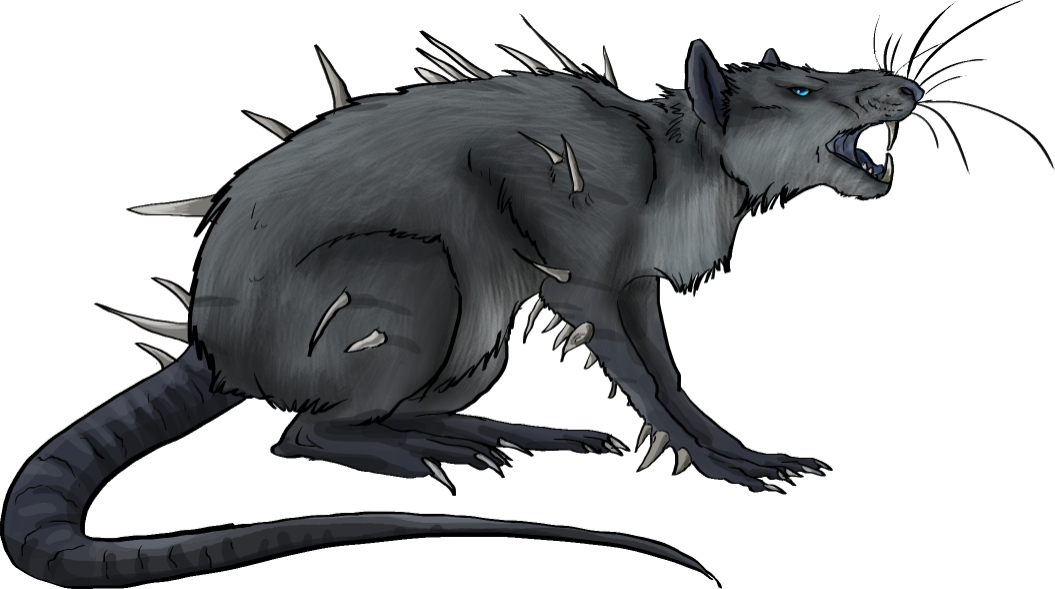 | Echoing Gray Location(s): Everywhere Danger Level: Dangerously manipulative Diet: Carnivorous Length: ~ 1 ft (2 ft with tail) Quirk(s): Mimics, relatively intelligent, form large packs Echoing Grays are the smallest of the subspecies, but perhaps the most dangerous when in great numbers. They have a highly developed hippocampus relative to other Lessers and utilize this to memorize any sound heard perfectly. An individual utilizes this eidetic sound memory to mimic sounds with complete accuracy. This ability is usually used to deter large predators, but may also be used to lure prey when assembled into large packs. They possess a dangerous understanding of vitals, and coordinate their attacks to target them. Echoing Grays are, as their name suggests, usually gray or white in color. |
 | Lava Rat Location(s): Leo, Tunnel C, sometimes Tunnel D Danger Level: Dangerous Diet: Omnivorous Height: ~2 ft Quirk(s): Extremely hot body temperaturue; collect metal These rats are a strange species: large, long, but thin. They're solitary, unlike the other rats of Origin Cave, and restricted to the hottest subzones available: mostly Leo and its connecting tunnel. Their fur is a scraggly, rich, dark red-brown, their bodies thin to the point of appearing starving, and studded with patches of hard, black keratin. This allows them to blend in perfectly with cracked lava and magma-formed stone, and they use this to ambush smaller prey, though they'll usually flee from anything larger. They seem highly heat-resistant, though not immune; a searingly-high body temperature of nearly boiling point makes them difficult to hunt and their rail-thin bodies provide little meat. Their eyes glint a flaming red-orange. Lava rats rely both on sharp instincts and cunning intelligence to avoid the hottest, most deadly parts of the tunnel and cave. They also have a strange habit of collecting any metal that they find--particularly iron--and using it to line their nests; therefore, finding a Lava Rat nest can provide an impressive source of material to work with. |
Cave Rabbits
Cave rabbits are, perhaps surprisingly for Origin wildlife, relatively harmless. About the same size as cave rats, or a little smaller, they come in a wide variety of colors and markings and are actually rather normal-looking. Though clean creatures, with their bites unlikely to cause infection, a bite from a Cave Rabbit will still leave a nasty mark--as will getting a kick from those large hind legs.
Cave rabbits are, perhaps surprisingly for Origin wildlife, relatively harmless. About the same size as cave rats, or a little smaller, they come in a wide variety of colors and markings and are actually rather normal-looking. Though clean creatures, with their bites unlikely to cause infection, a bite from a Cave Rabbit will still leave a nasty mark--as will getting a kick from those large hind legs.
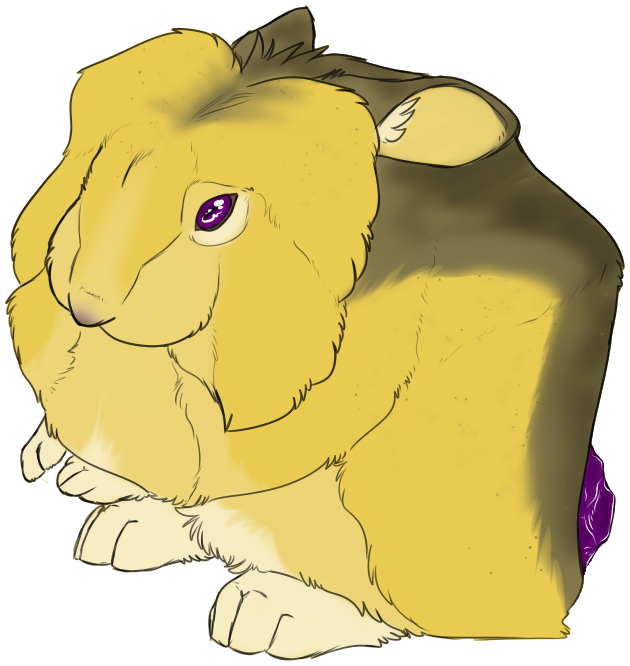 | Bush Rabbit Location(s): All Tunnels Danger Level: Harmless, but flighty Diet: Herbivorous, prefers roots Length: 1-2 ft Quirk(s): Long-furred, burrows under bushes Small- to medium-sized, these rabbits have very long fur that can be harvested for many uses, either through skinning or clipping the fur. It is reminiscent of angora fur, thick and soft, and is very good for insulation. They usually live in the tunnels of Origin, hiding themselves off in holes, crevices or any burrows they can manage to dig. Given the thickness of their pelt, cold weather presents little problem for Bush Rabbits, who despite their name often linger in cooler tunnels which features less traffic (and thus, less danger). Their fur is usually gray or brown but sometimes comes in brighter oranges and tones of yellow. Populations that have lived in cold tunnels tend to evolve toward paler, even white, coats in order to better blend in. |
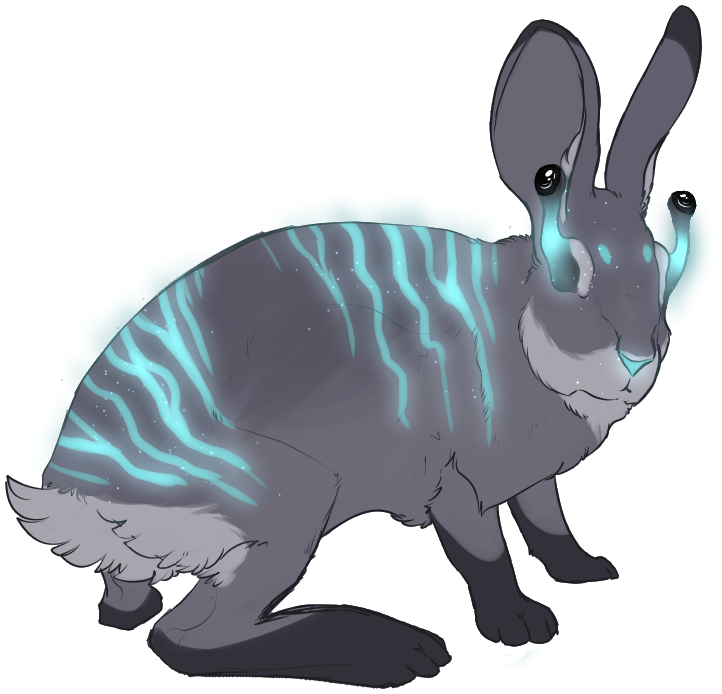 | Walleye Rabbit Location(s): Everywhere Danger Level: Harmless, but flighty Diet: Herbivorous Length: 1-2 ft Quirk(s): Eye-stalks, oversized hind feet, variable diet Generally a little larger than the Bush Rabbit, with a steely gray pelt and occasional blue (sometimes bioluminescent) markings, the Walleye Rabbit is easily-spotted throughout the caves and tunnels. They are more difficult to catch than some, however, given their eyes: these sit atop stalks on their heads and give them an immense range of vision. They have enormous hind feet, enabling them to kick aggressors or run very quickly away from any danger. Walleye Rabbits are herbivorous, and are extremely adaptable, eating almost anything that resembles plants: from leaves and grass to dead foliage and even sticks. They can often be found happily chewing away thorned or sharp-edged plants that other Lessers might leave behind. |
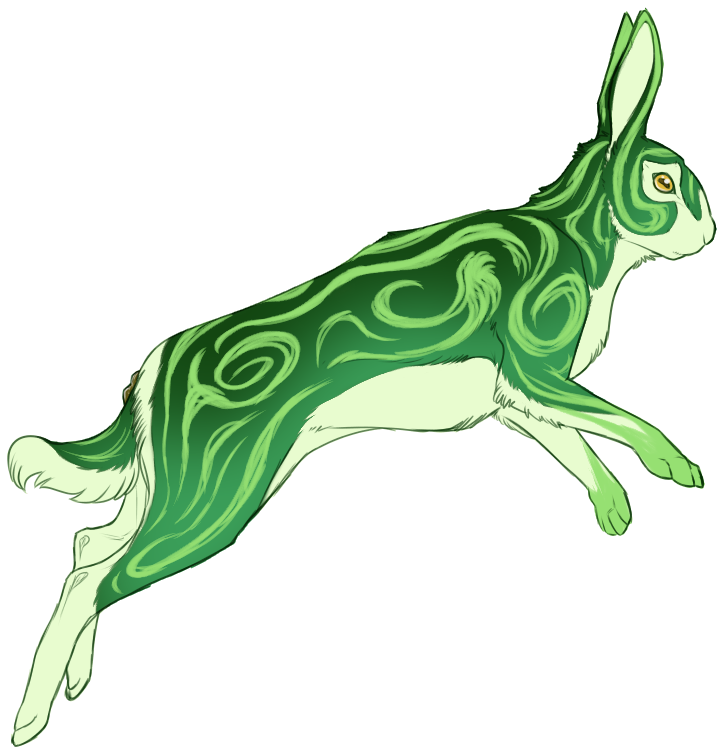 | Wind Hopper Location(s): Anywhere with plentiful greenery, Monoceros Danger Level: Harmless, but flighty Diet: Herbivorous, prefers browse Length: 1-2 ft Quirk(s): Slender, highly-social, brightly-colored These rabbits are more lithe and swift than the others, with a slender, athletic body. Unlike the other, more solitary species, Wind Hoppers live in large and social colonies, helping to care communally for their young. They tend to dig large burrow systems, or to live hidden beneath mats of overhanging, thick foliage, allowing them to stay mostly hidden when at rest. When feeding, they graze in groups, taking turns to eat and to keep watch for danger. Wind Hoppers are easily-recognizable by not only their slim appearance but their coloration: swirling markings of vibrant colors color their coats, perhaps serving some form of social function between them. |
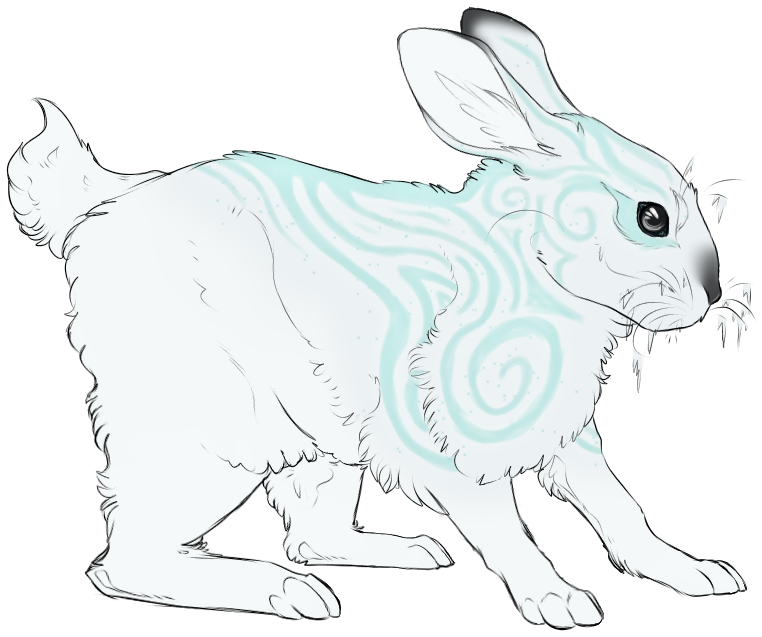 | Snowwhisker Location(s): Ursa Danger Level: Harmless Diet: Omnivorous Height: ~1 ft Quirk(s): Will scavenge meat, bioluminescent Snowwhiskers are a cold-adapted form of the Wind Hopper. Compact but lean, they are pure white in color, though often appear to have swirling patterns of silvery bioluminescence reflecting the aurora above. A Snowwhisker in danger will stifle this bioluminescence to appear camouflaged; but when relaxed, their displays to one another across the mountain peaks can look like the distant glittering of stars. Their ears are somewhat short, their fur quite thick to insulate against the cold, and very often, moisture leaves tiny icicles dangling from their whiskers. Their harsh existence in the cold of Ursa leaves them opportunistic, and all will unflinchingly consume meat if it is provided--but they do not hunt or kill on their own. Snowwhiskers are sometimes solitary, but will also form warrens beneath crusts of snow where they cluster together for warmth. |
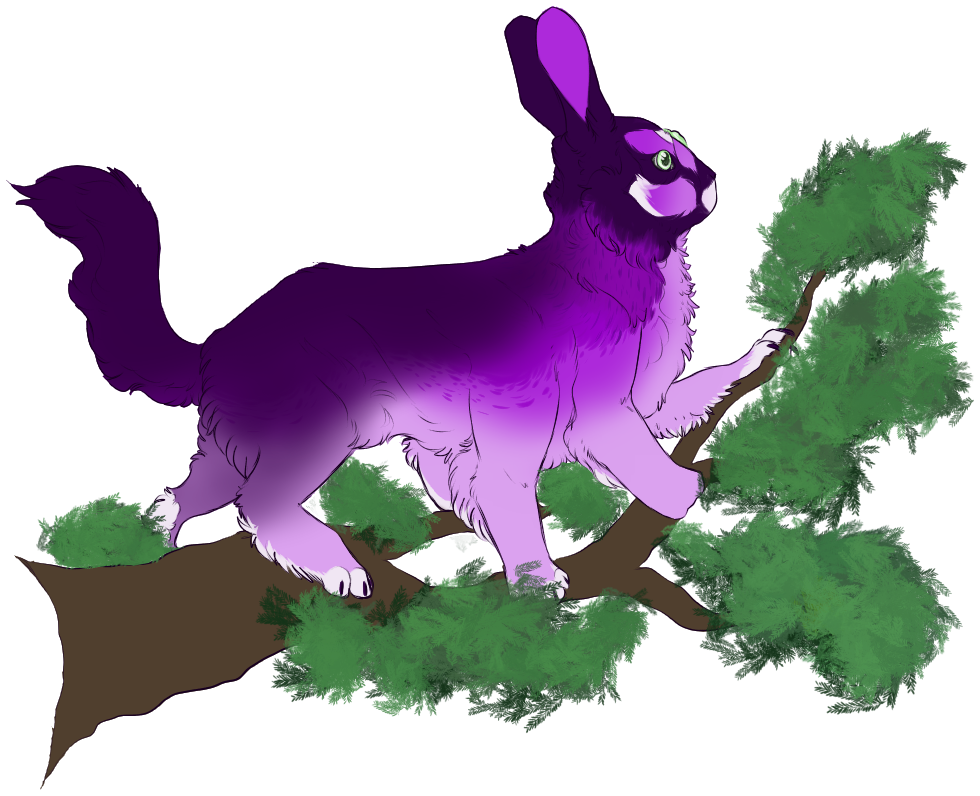 | Tree Rabbit Location(s): Pegasus Danger Level: Harmless Diet: Herbivorous Height: ~1 ft Quirk(s): Highly social, arboreal Tree Rabbits are adapted, as their name suggests, for life in the highest of Pegasus' trees. They bear six limbs instead of the usual four, with the first two pairs adapted for gripping and climbing, and the hind for leaping from tree to tree. Their tail is a little longer than usual, about a quarter of their total body length, and very fluffy. They are highly-social, and more intelligent and less fearful than most of the cave's rabbits, living in large colonies and communicating in chirps and squeaks not unlike loud birdsong. At times, they descend into the meadows when the feeding is particularly good, and when all appears safe below. They seem to be the Pegasus equivalent of Catsquirrels, and the few Catsquirrels found in Pegasus compete (mostly unsuccessfully) with Tree Rabbits for territory and food. |
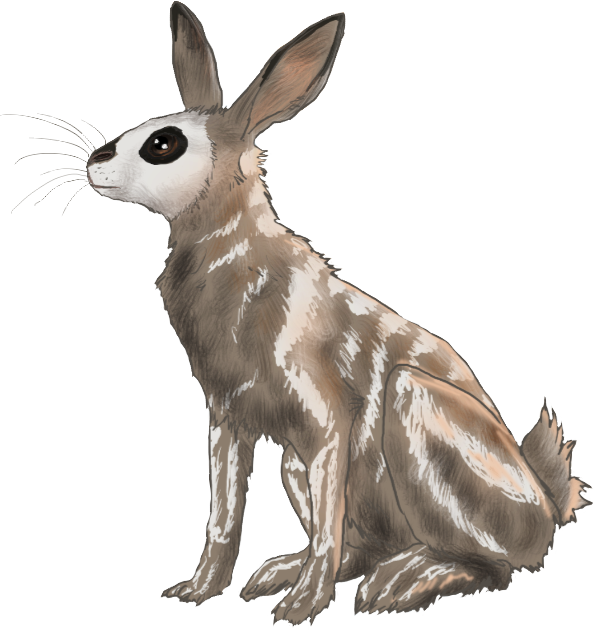 Bone Hare | Location(s): Hydra Danger Level: Harmless, but flighty Diet: Herbivorous, opportunistic Length: 2-3 ft Quirk(s): Large, with bone-like markings Bone Hares are a large hare species found only in Hydra, generally sticking to the Crucible. Gentle, shy herbivores, they weigh up to fifteen pounds. Lean and exceedingly swift, they tend to feed upon scrub brush and other foliage tough enough to withstand Hydra’s heat. Extremely sharp hearing and eyesight and a strong sense of smell warn them of danger well in advance. A Bone Hare’s first defense is to camouflage itself: its agouti, tawny coat is marked with pale markings resembling bones. The Bone Hare will lie flat or fall limp, eyes closed and ears flattened back, thus appearing at a distance to simply be another pile of Hydra’s bones. This tends to work well against the higher, circling Eyehook Vultures. The Bone Hare’s scent is nearly nonexistent, aiding it in avoiding or escaping tracking Cave Spiders, though they still fall prey to all of Hydra’s predators. As a last resort, the Bone Hare’s exceptional speed and agility can carry them away and into tight crevices to hide. However, the main survival mechanism of the Bone Hare as a group is simply through fast, frequent reproduction: the more Bone Hares there are, the more difficult they are to wipe out. |
Cave Mice
Cave mice are very tiny Lessers that scuttle around throughout the caves, hiding and travelling through any narrow space they can access. They’re at the bottom of the food chain, and they know it, presenting no threat to larger Gembound and serving as an easy meal for new hatchlings. They resemble Cave Rats, though are smaller, with more slender tails and sleeker fur, larger ears, and an overall less-threatening appearance. They are timid and patient, with quick reflexes, and hide or flee rather than fight. Though not as social as Cave Rats, they do not fight over territory, and dozens may be found in a single hiding place.
Cave mice are very tiny Lessers that scuttle around throughout the caves, hiding and travelling through any narrow space they can access. They’re at the bottom of the food chain, and they know it, presenting no threat to larger Gembound and serving as an easy meal for new hatchlings. They resemble Cave Rats, though are smaller, with more slender tails and sleeker fur, larger ears, and an overall less-threatening appearance. They are timid and patient, with quick reflexes, and hide or flee rather than fight. Though not as social as Cave Rats, they do not fight over territory, and dozens may be found in a single hiding place.
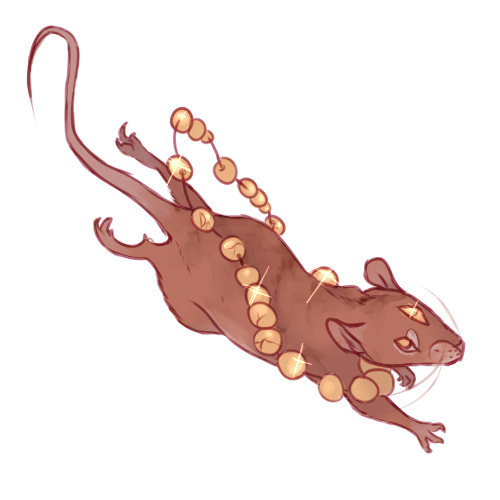 | Red Mouse Location(s): Everywhere Danger Level: Harmless Diet: Herbivorous Length: 7 inches Quirk(s): Silent, timid, hoarders The Red Mouse is a sandy to russet color, living everywhere in the caves and yet very rarely seen. They are very secretive, hiding in vegetation and making use of any abandoned burrows or dens that they find. The Red Mouse has only one quirk, and that is that it tends to be very attracted to shiny objects. They will approach and take any reflective or shiny items that they can carry, and hide them away in whatever den they might be using. They may use this to impress potential mates, or just out of some strange and misplaced instinct. Whatever the case, it’s not uncommon to find an abandoned hole full of small and shiny objects, and potential treasure hunters might do well in following Red Mice to their holes. |
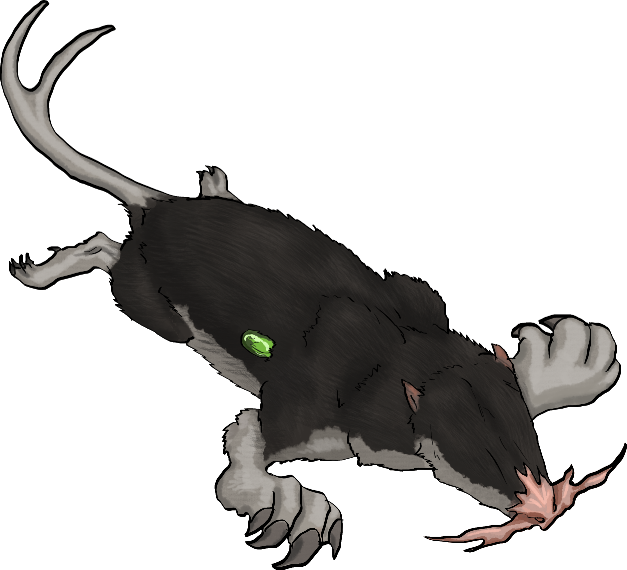 | Molemouse Location(s): Anywhere with dirt Danger Level: Harmless Diet: Herbivorous Length: 5 inches Quirk(s): Primarily subterranean, noisy Molemice have large, spade-like claws and bristling many-pointed feelers on their noses. They are eyeless, and thus blind, relying on their other senses while burrowing. They are hardly ever seen above-ground and thus must be dug out by predators, but they aren’t as difficult to find as one might imagine: they are rather noisy, communicating and claiming territory with many types of squeaks, grunts and squeals, giving carnivores with patience and good hearing a fairly easy source of food. They are the smallest of the cave mice and come in a variety of earthy tones, generally brown or grey, though a few have a greenish hue. |
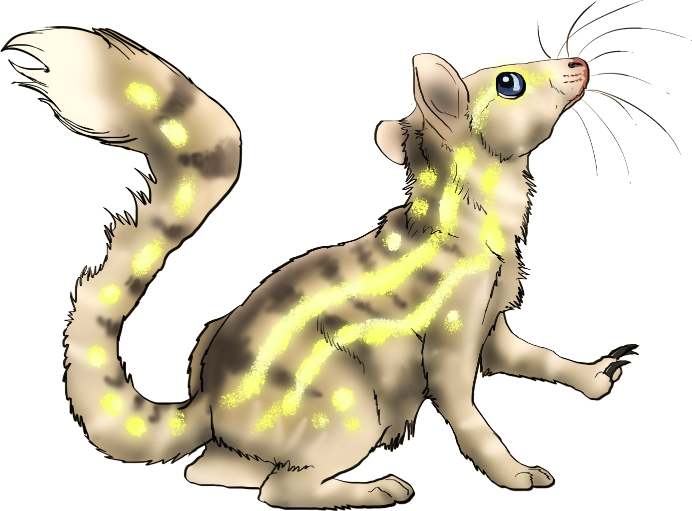 Jungle Mouse | Location(s): Anywhere with trees Danger Level: Harmless Diet: Omnivorous Length: 10 inches Quirk(s): Climbers, bioluminescent, retractable claws The Jungle Mouse is a little bolder than the other species, and a little larger, too. Longer and more muscled, with retractable claws, they are well-adapted for their lifestyle: an arboreal existence climbing among the higher trees. They do often come to the ground to forage among vegetation, though they are generally out-competed here by other Lesser species. The Jungle Mouse comes in a variety of colors, and usually features bright bioluminescent marking with which it communicates with others of its kind. They also use shrill, bird-like chirps and songs to keep track of one another and to claim territory or attract mates. Jungle Mice are generally herbivorous, but will also take insects and eggs if and when they can find them. They are too shy, however, to bite even helpless prey. |
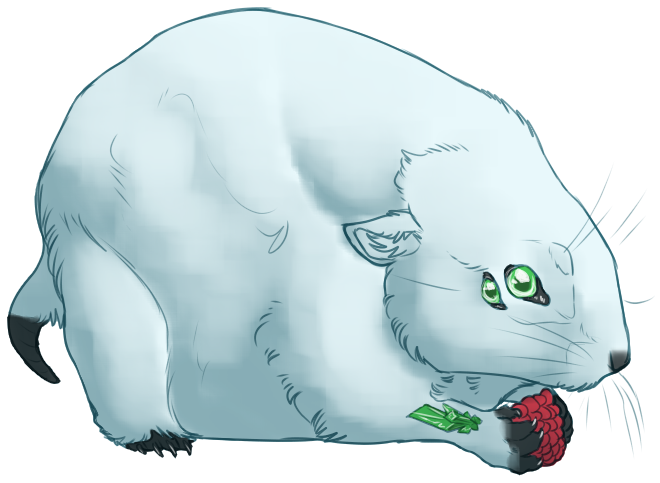 | Ice Mouse / Ice Mice Location(s): Ursa, anywhere with snow or ice Danger Level: Harmless Diet: Herbivorous Height: ~3 inches Quirk(s): Cold-adapted, loud singers Ice Mice are very small mice adapted to Ursa's cold, though they can occasionally be found anywhere particularly cold. Like most of Ursa's creatures, they're pure white in color, and tend to create intricate burrows and tunnel systems through the snow. Their sense of smell is incredible, leading them to even old, buried or frozen plants for food, and they particularly favor the white blooms of the ice flowers that can sprout around the glacier tunnels. Their waterproof fur allows them to safely dive in the Drowned Forest to feed, and return without freezing solid. While quick and difficult to catch, Ice Mice are an abundant and tasty morsel to stave off a carnivore's hunger in the cold. |
 Quill Mouse | Location(s): Hydra Danger Level: Nonaggressive, but toxic-spined Diet: Herbivorous/opportunistic Length: 6 inches (+ tail) Quirk(s): Hydra-only, dangerous spines, toxin-resistant The Quill Mouse is a very small rodent perhaps double the size of a chicken's egg. It is very common throughout Hydra, though it lives primarily in the Crucible. While the Quill Mouse is primarily herbivorous, it is also opportunistic, eating anything it can come across--insects, carrion, and bones. Its main defense is a thick bed of long spines along its back, which the Quill Mouse coats with toxin: Quill Mice each periodically travel to the Dead Marsh, or use dead Scorpions and Spiders that they might find, and instinctively find and groom the venom into their fur. Quill Mice are also highly resistant to all forms of toxin and poison. A careless predator can easily find themselves badly wounded, infected, poisoned, or even dead--but all the same, the Quill Mouse is frequent prey for the more experienced carnivores of Hydra. |
Cave Bats
These creatures often appear much like cave rats with large wings. They generally bear large fangs and dirty fur, though they vary widely in appearance by type. Some are larger and more violent, others smaller and far more docile. Some survive by sound alone, and are blind, where others have powerful eyesight. Being familiar with the type of Cave Bat native to one’s cave might be the difference between an easy meal and becoming one.
These creatures often appear much like cave rats with large wings. They generally bear large fangs and dirty fur, though they vary widely in appearance by type. Some are larger and more violent, others smaller and far more docile. Some survive by sound alone, and are blind, where others have powerful eyesight. Being familiar with the type of Cave Bat native to one’s cave might be the difference between an easy meal and becoming one.
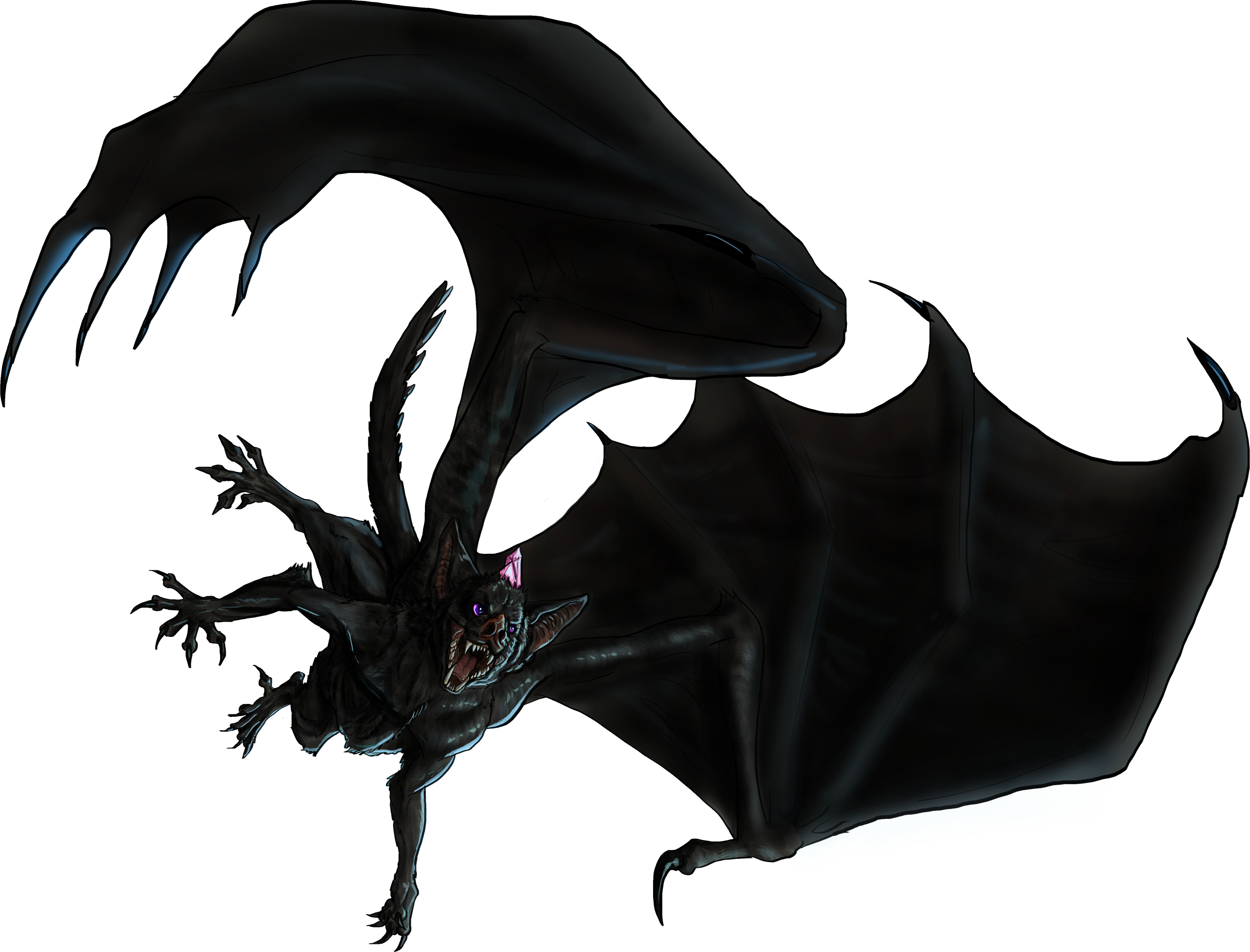 | Dragonbat Location(s): Dark Areas Danger Level: Aggressive and Dangerous Diet: Carnivorous Length: ~ 4 ft Quirk(s): Social, aggressive, predatory Named because of their large size and fearsome appearance, the Dragonbat is the most dangerous of the bat species. They are, luckily, far more uncommon in the caves than many Lesser Gembound types, restricted to small colonies which often quarrel viciously among themselves. They can be found in high, dark crevices or small, unlit rooms in caves, sometimes choosing to nest in abandoned structures or ruins. Wicked spikes protrude from their spine, all the way down their backs, and they have huge, crooked fangs adapted to their carnivorous diet (usually smaller vertebrates, large insects, and fish). Four legs feature sticky toes and wicked claws for grasping stalagmites and catching fish. Dragonbats are highly-territorial and do not like being disturbed while roosting, so a Gembound finding a hanging colony would be well-advised to leave them alone. They will viciously fight to defend their territory, swarming intruders with laceration, hit-and-run swoops, and they will target smaller Greaters, especially newly-hatched, as prey. |
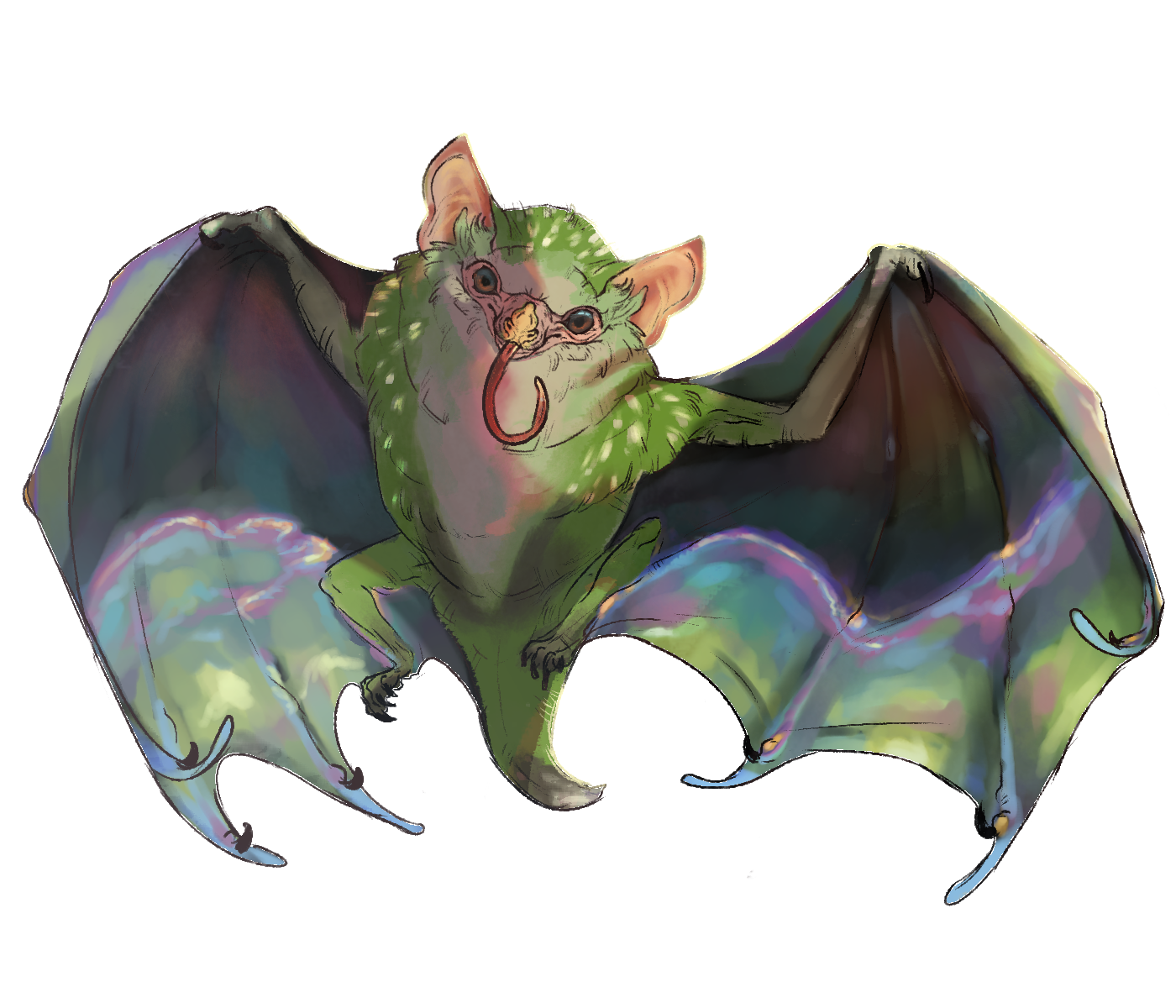 | Pixie Bat Location(s): Eridanus, Pisces, Pegasus, sometimes Cetus Danger Level: Harmless Diet: Nectar Length: 5 inches Quirk(s): Tiny, Colorful The Pixie Bat is easy to mistake for a large, glittering insect. Reaching a maximum of five inches long, they are quite tiny, with vibrant colors, and feed purely on the nectar of flowers. As a result of their diet they are generally restricted to Eridanus, though a few bright flashes of color can be found around Pisces and Cetus, as well. Their wings are beautifully-iridescent, and their fur is very soft. They have large ears and snub noses, but long tongues capable of dipping into flowers; they tend to use their senses of hearing and smell to navigate, though their vision is decent (and capable of seeing in the ultraviolet range). |
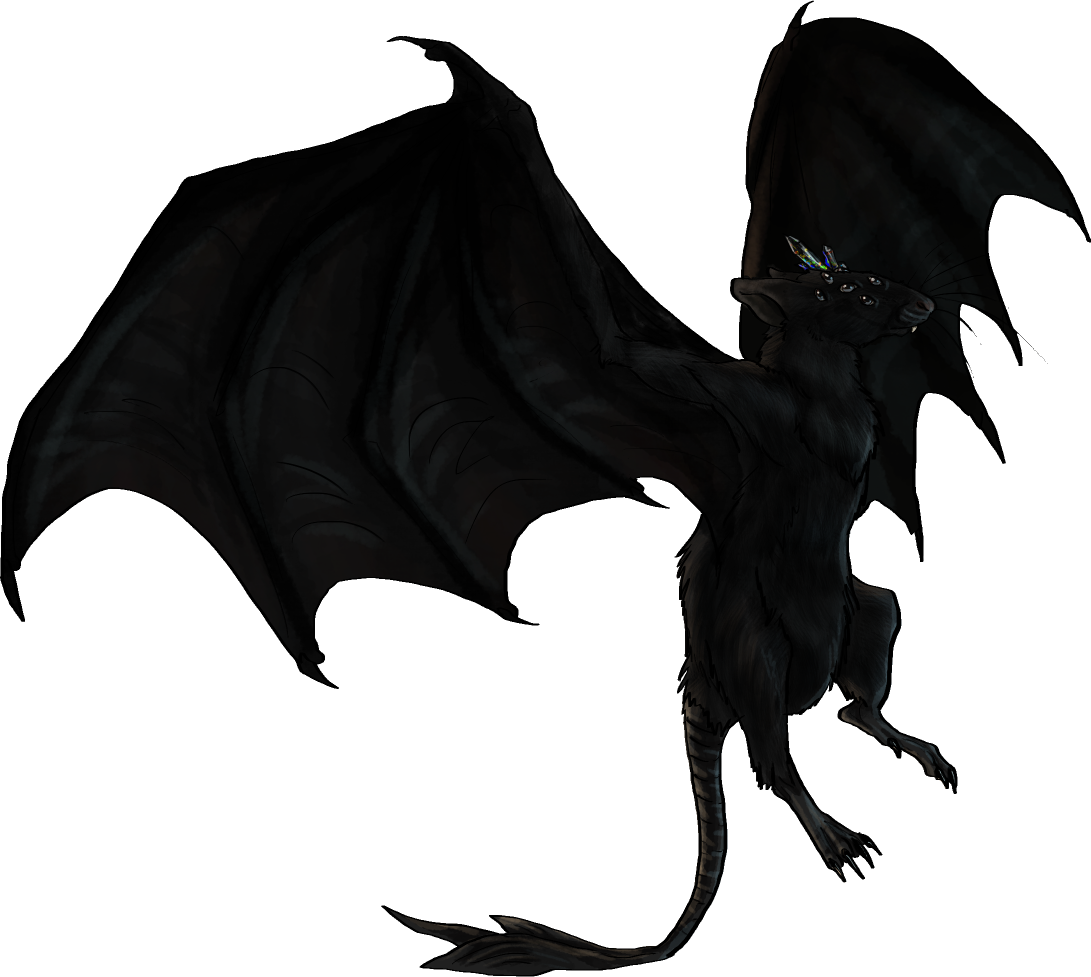 | Flying Pitch Rat Location(s): Everywhere Danger Level: Shy Diet: Omnivorous Length: ~ 2 ft Quirk(s): Oddly-Similar to Pitch Rats, Many-Eyed Flying Pitch Rats, as per their namesake, look quite similar to Pitch Rats--but with wings. They are large, with crooked fangs, but they lack the terrifying eyes of Pitch Rats and are not particularly aggressive. A Flying Pitch Rat is more likely to flee rather than engage in combat. They tend to roost and live in small social groups, and a sick or wounded Flying Pitch Rat will find itself cared for by its colony-mates. They are easily-identified, compared to other bat species, by their six small, black eyes, situated in a haphazard pattern across the face. These patterns are unique to each individual, and can be used to identify them. |
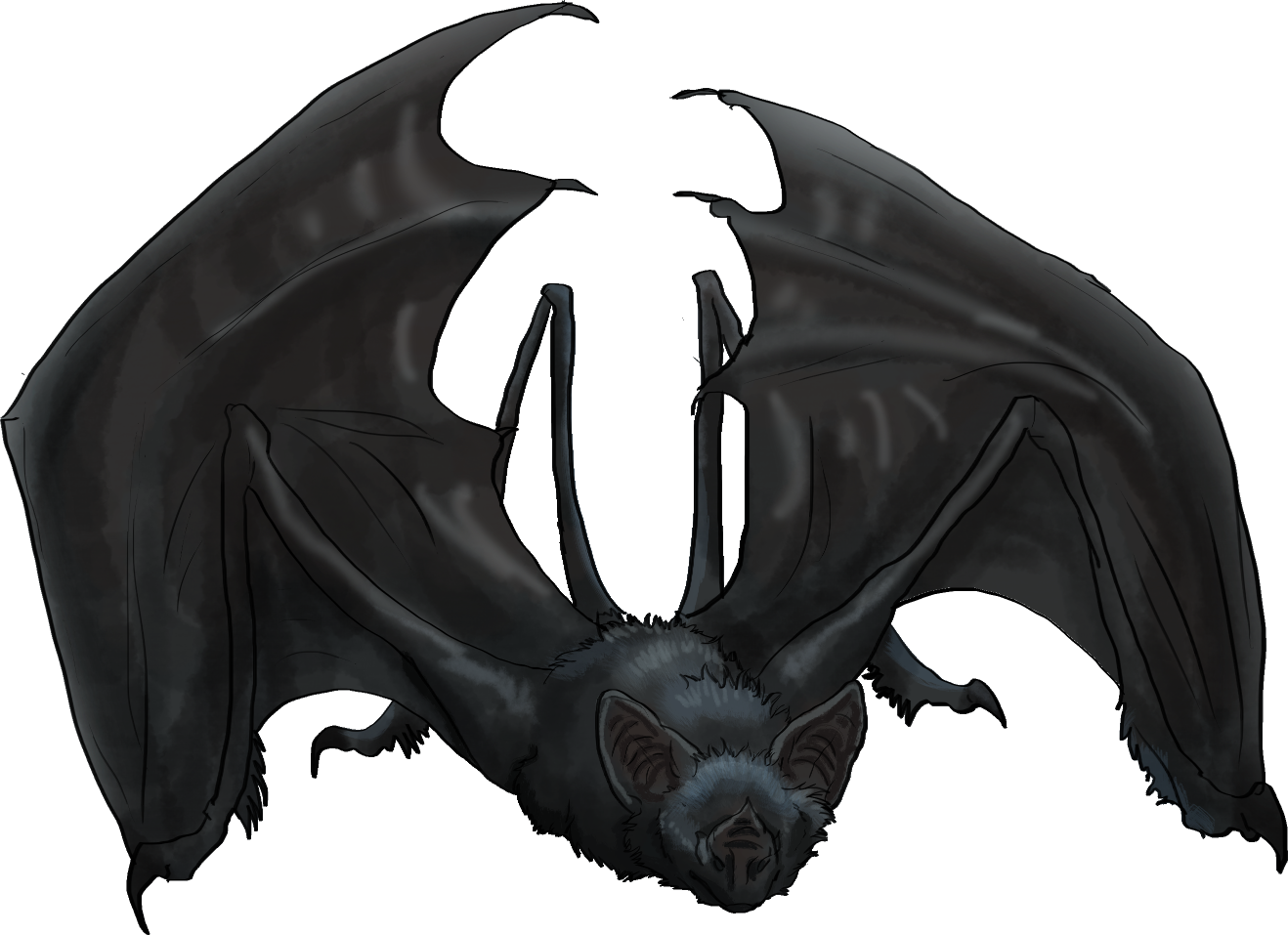 | Crawler Bat Location(s): Cetus, Polaris, Orion, anywhere dark Danger Level: Aggressive, but Mostly Harmless Diet: Omnivorous Length: ~ 1 ft Quirk(s): Blind, Noisy, Invasive The Crawler Bat is a small bat, larger only than the Pixie Bat in terms of Cave Bat size. It is uniformly dark grey, with plush, short but thick fur covering its torso. Its ears are large and leaf-shaped, and it has a complicated, similarly-leaf-shaped nose. It has no eyes, and rather than true limbs, it has strange, two-jointed, claw-like limbs not unlike long spider legs. These grant the Crawler Bat its name: it tends to seek out small spaces to hide, and can often be found in unexpected (perhaps unwanted) small niches and holes, crawling with its oversized and slender limbs. Generally, it roosts high in trees or on cave ceilings among stalactites, often in colonies of a dozen or so. Crawler Bats hunt mostly flying insects, but will eat almost anything they find, including carrion, fruit, and fish. They do not, however, hunt prey for themselves, only scavenging. When hunting, they navigate through noisy echolocation and seek prey with a highly-sensitive nose. During flight they emit constant, high-pitched squeaks and clicks audible only to those who can hear such tones--Cetus can sometimes seem full of their calls. When roosting, the colonies are often noisy, shrieking and squawking while jostling one another for physical and social position. |
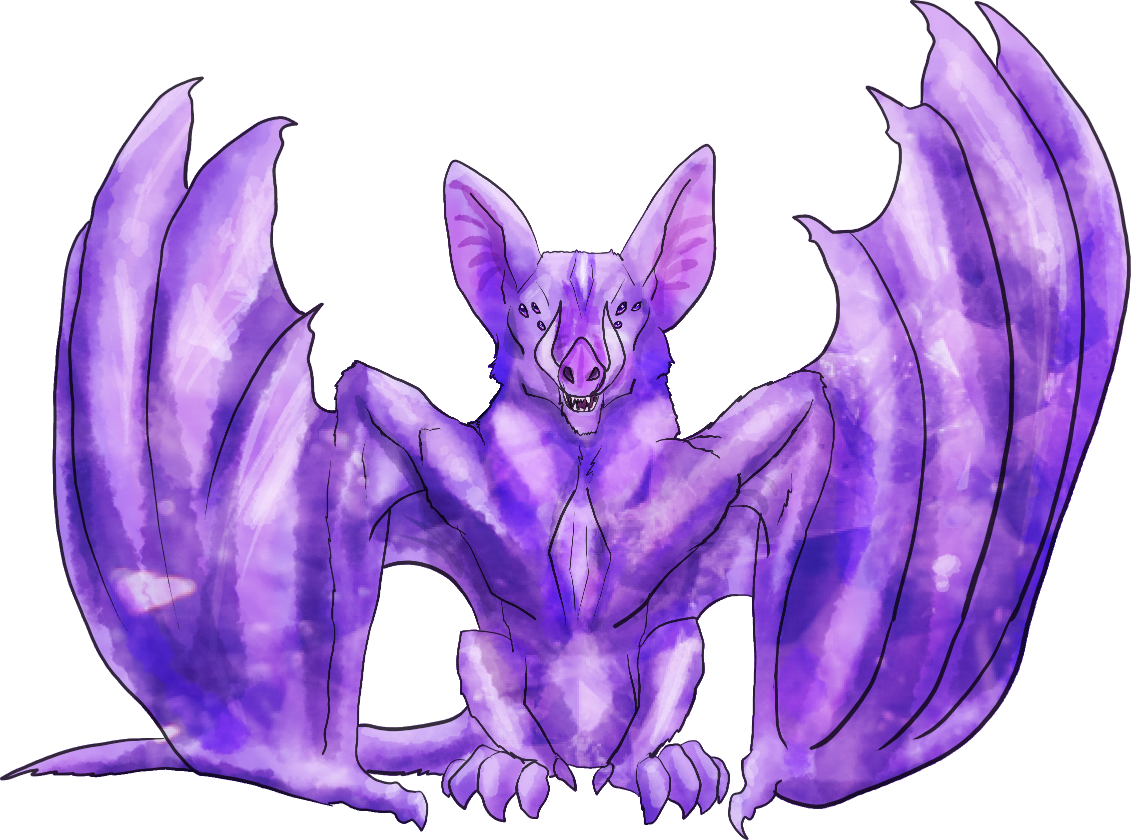 | Crystalwing Location(s): Mostly Gemini; any location with crystals Danger Level: Dangerous to smaller creatures Diet: Omnivorous Length: ~2 feet Quirk(s): Appear crystalline until they move Crystalwings are perhaps best likened to gargoyles of mythological lore, but far more beautiful to look upon. Native to Gemini, they can nevertheless be found migrating to any tunnel with crystals, including Draco, Polaris, and Orion. Solitary creatures, they spend their time still and silent perched among these outcrops, blending in perfectly: their hides are formed of a translucent, iridescent keratin structure that strongly resembles gemstone, and which can slightly, subtly shift color to match their surroundings. They often appear to be outcrops of crystal themselves, or carved bats formed from them; large ears, six small eyes and upward-jutting tusks complete a strange image. Crystalwings use their camouflage both to hide themselves when idle, and to hunt; they will eat fruit, insects and any particularly small creatures that they come across, often carrying it high and dropping it to let gravity do their work for them. They also occasionally eat actual gemstone, using the minerals to synthesize the crystalline structure of their keratin skin; their droppings, too, can hold bits of precious gems for those willing to pick through them. |
Cave Birds
Cave birds come in an enormous variety of colors and shapes, sometimes within the same species. They generally share the features of feathers, and of having a single eye at the center of their foreheads, though birds with two or more eyes are not uncommon. Cave Birds often have teeth in their beaks.
Cave birds come in an enormous variety of colors and shapes, sometimes within the same species. They generally share the features of feathers, and of having a single eye at the center of their foreheads, though birds with two or more eyes are not uncommon. Cave Birds often have teeth in their beaks.
 | Hallowed Caller Location(s): Cetus Danger Level: Shy Diet: Omnivorous Length: ~ 1.5 - 2.5 ft Quirk(s): Spooky The Hallowed Caller is surprisingly noisy for its size. Its appearance is definitely on the spooky side, with pitch-black feathers and a single blood-red eye. They also appear to prefer foggy areas, often those with dead trees, and usually can be found in Cetus. As if designed merely for atmospheric reasons, they even make eerie noises: a cacophony of pained screams, wails and calls that sound mournful at best, and hellish at worst. They are somewhat variable in size, ranging from about a foot and a half long to two and a half feet long, but otherwise are generally uniform in appearance. The exception is albino birds: purely white-feathered, with the single red eye very noticable. The Hallowed Caller is omnivorous, scavenging abandoned fish, carrion and fruit, or seeking out its own small prey, including insects and smaller vertebrates. |
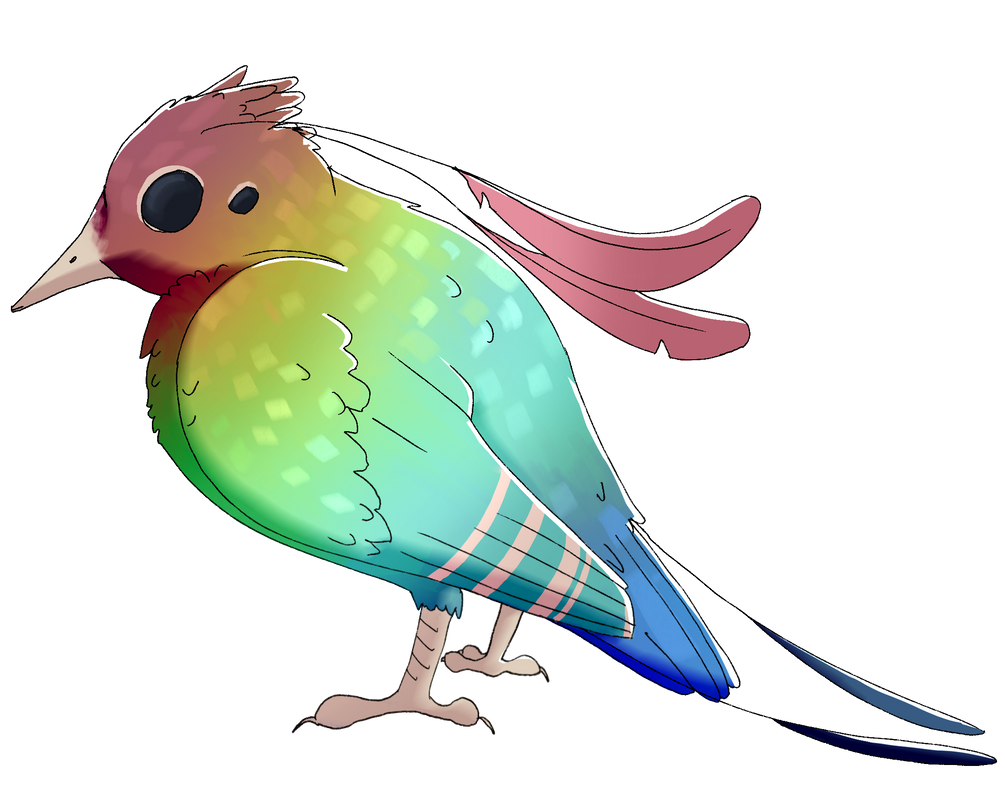 | Rainbow Spinner Location(s): Eridanus, Monoceros, Pegasus, Tunnel F, Cepheus Danger Level: Harmless Diet: Herbivorous Length: 3-6 inches Quirk(s): Vibrant colors, tame nature The Rainbow Spinners are tiny creatures with beautiful feathers that gleam with every color of the rainbow. When these feathers are plucked or fall loose they seem to spiral toward the ground rather than simply falling. Rainbow Spinners have brightly cheerful calls, and tend to fly in small groups of two or three; they roost in trees, and feed off fruits and nectar, and sometimes seeds. They are also surprisingly tame, often drawing closer to any larger creature that doesn’t act in a predatory fashion, displaying curiosity and friendly behavior. Though they rarely come close enough to touch, they can be welcome company for those who wish it. |
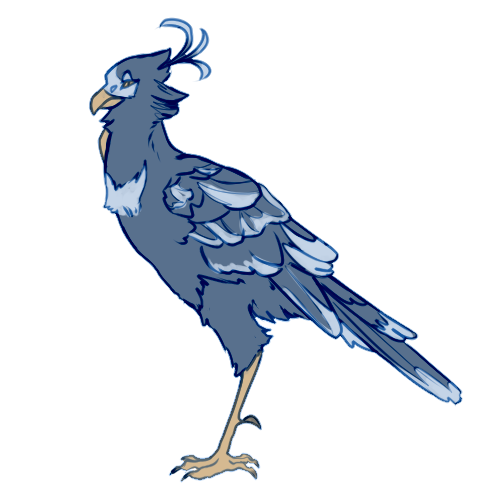 | Caroller Location(s): Everywhere Danger Level: None Diet: Herbivorous Length: 4-9 inches, doubled with the tail Quirk(s): Vocal, two-eyed Carollers are birds with a single set of two eyes. Their size varies from quite small to medium-sized, with a long tail making up much of that size, but their plumage is generally identical: bright blue coloring with white barring across the wings. They sport only a single leg featuring six claws adapted for gripping tree limbs, and they sometimes hang upside-down when displaying to fellow Carollers--often waving their wings broadly. Their calls are quite distinctive, with long, gorgeous songs. Each Caroller has its own unique song, sometimes extremely complex, and yet together they will weave them into a coherent, melodic tune. Their bright chirping and constant singing can be heard throughout the caves, excepting only the most inhospitable locations. |
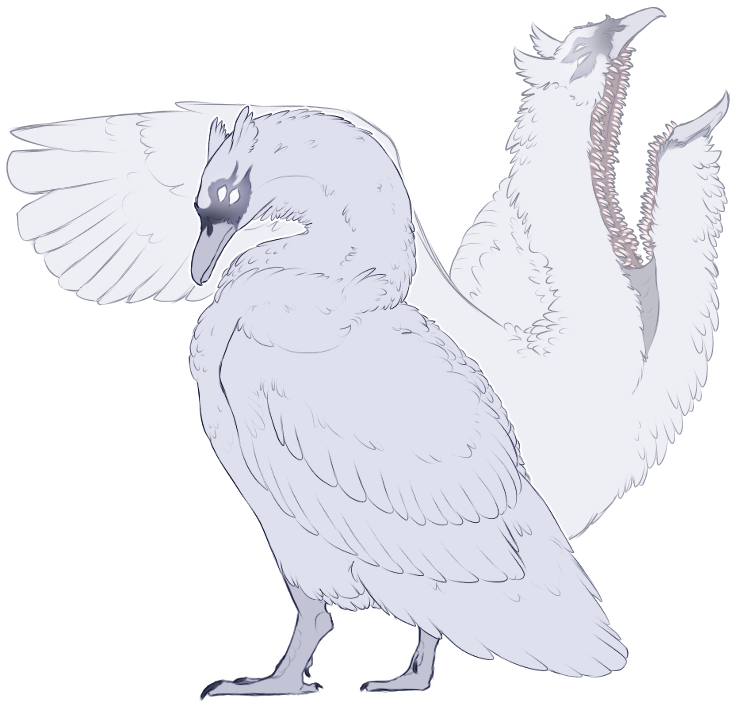 | Hellswan Location(s): Cepheus Danger Level: Extremely deadly Diet: Omnivorous Height: 4 feet Quirk(s): Ambush predators Hellswans are, at first glance, gorgeous creatures. They appear very much like normal swans in that they are pure white, elegantly graceful waterfowl with long, curved necks and thick plumage. There are, of course, differences: the neck is thickly ruffled with feathers, the legs pure white, and the eyes are four in number, glowing pale. Ear-tufts and a gently-hooked white beak give them a somewhat griffin-like appearance. Most of the time, they simply float around Cepheus' water features, looking like ornaments and trimming away dead plant matter and excess insects; however, anyone thrown into their pond, bleeding close by or presenting a threat (including damaging nearby garden plants) is met with a terrifying surprise. The swan's jaw actually extends down its neck, so that its face down to the chest will split into a horrifically large maw, full of razor-teeth. The swans will attack as a flock to rend their victims to pieces. Their flocks number around ten, and so a Hellswan attack can make quick work of even larger Gembound who misstep. |
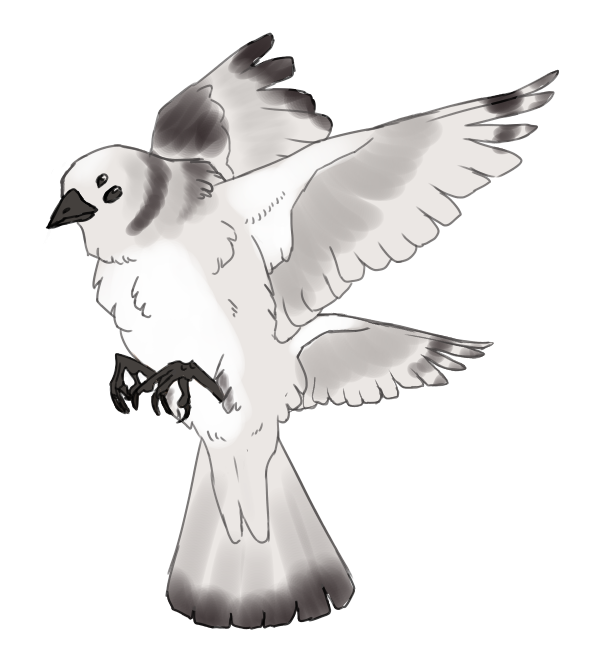 | Mountain Sparrow Location(s): Ursa, nearby tunnels Danger Level: Harmless Diet: Herbivorous Height: 6 inches Quirk(s): Highly curious and friendly Mountain Sparrows vary in color from pure white to gray, and are sometimes streaked with black as if to imitate rocky striations. They feed purely on foliage and seeds, which they often dig out from the snow and ice of Ursa and its surrounding tunnels. These birds are quite small and very fluffy, round with insulating feathers, with a very small black beak and four bright black eyes. They can often be found in small flocks, roosting high along the mountain ridges or along the skeletal remains of the trees in the Drowned Forest. Their song is eerie: an almost metallic, very quiet keening and chirping that can be mistaken for raindrops or falling crystals, were it not for its melody. These birds are also very friendly and curious, lacking any instinctive fear, and will often approach or accompany visitors and even perch on them unless frightened off. Each bird has two pairs of wings: one primary, and one very small at the rear, which act as an additional rudder against the harsh winds of the higher mountain peak. |
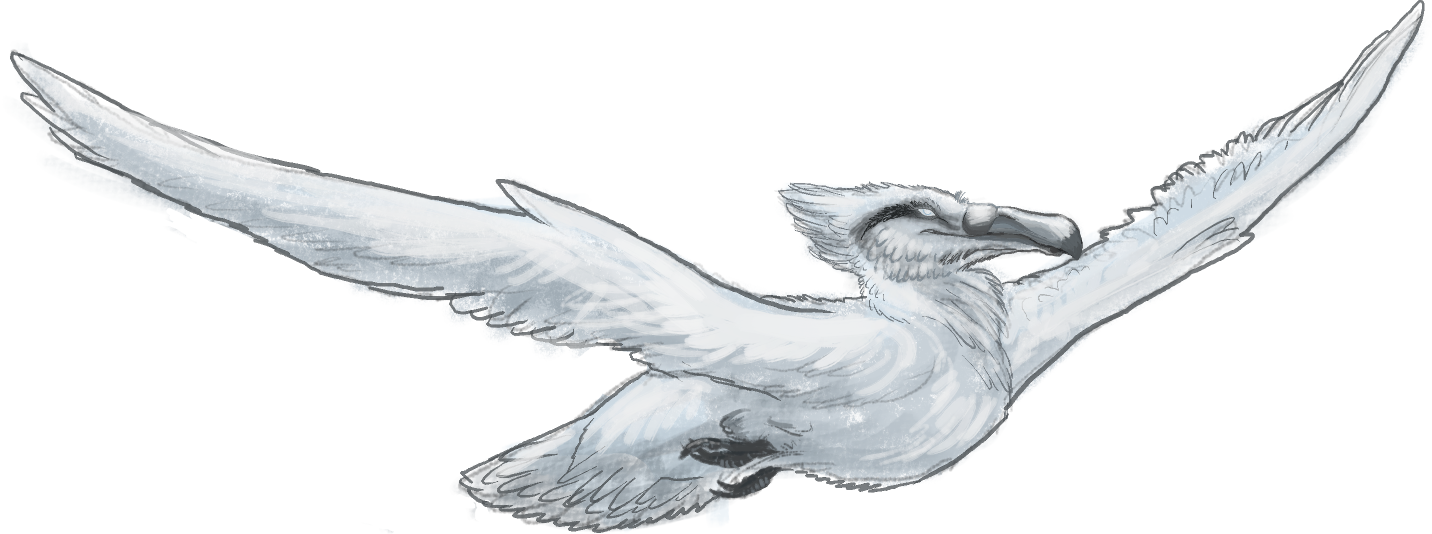 | Ghostbird Location(s): Ursa Danger Level: Mostly Harmless Diet: Omnivorous Height: 4 feet Quirk(s): Soaring birds; rarely land Ghostbirds are mysterious creatures found only in the highest parts of Ursa. While only three to four feet tall, weighing about thirty pounds, these birds have a massive wingspan of twelve feet, and use it to soar nonstop through the fog and snow at the top of the mountain cave. They rarely land, even to roost, and are generally difficult for all but the keenest eyes (or highest flyers) to spot. White or light gray in color, they blend in perfectly with the snow and mist. In build they're heavy-bodied but broad- and long-winged, with a long, slender, back-curved neck like a crane's and a slim, gently-hooked, long gray beak. Dark lines on some stretch back to encompass the eyes, which are a silver that often shine with reflections of the aurora-like light. Ghostbirds land only to reproduce, and then only on the highest portions of the mountains, sometimes in shallow caves; the rest of the time they feed by sweeping low and snagging prey or foliage that they deem possibly edible. This is often the only point at which they're spotted by ground-dwellers, giving them their name: they are like ghosts passing only briefly through the world below. |
 | Skycaller Location(s): Anywhere with water Danger Level: Mostly harmless Diet: Omnivorous Length: ~2 ft Quirk(s): Beak, eyes and feet matching metallic gold or silver A bird-like creature about two feet long, with a four to five foot wingspan, these Lessers live in and around the cave's larger water sources. They prefer the crashing waves of Leo and, since Leo's reopening, have settled back into Fornax as well. Some can also be found in other locations, such as rivers or Pisces' lagoon. Skycallers have three feet--two with hooked talons for snatching fish from the water, and one set horizontally which waves back and forth as a rudder when swimming or diving. Generally pale in color, with countershaded grey upperparts, they're covered in a coat of sleek, waterproof feathers and have a long beak of metallic silver or gold. This beak is ridged with small, back-facing teeth. The bird's six eyes (one at the throat, one at the back of the head, and a pair to either side) always match the color of the beak and are often damaged or missing from fights with others of their kind. Skycallers are highly gregarious, usually roosting and flying in colonies, and will fish for their own food; but they also serve as a sort of garbage disposal, eating literally any meat, fish or detritus that they can find. They're also very vocal, with constant loud and high-pitched cries that visitors may find melodic or irritating. Skycallers will try to eat anything smaller than themselves, but that's a rather small list; they will otherwise flee, though they'll mob (with sharp strikes of their beaks) anything that tries to plunder an active nest. |
 | Frogbeak Location(s): Larger water sources Danger Level: Harmless Diet: Filter feeding, small fish Length: 8 inches Quirk(s): Extremely agile on the wing A feathered but reptilian Gembound, small and white, with a long, forked tail and four wings. About eight inches long, with a two foot wingspan at the most, they're extremely agile in the air; the long, slender wings with their single "finger" bone can retract and adjust to allow for very rapid changes in both speed and trajectory. They have hard, beak-like mouths but these are very broad, almost frog-like; they're used to snatch up big gulps of water which is strained out through the sieve-like corners of the beak, leaving only very small prey to be swallowed whole. The Frogbeak has two large eyes, one to either side of the head, and a third beneath the throat to help it search for prey while airborne; often several of them will accompany a Skycaller or two, with the smaller Frogbeaks seeking schools of fish and the Skycaller taking any larger fish while keeping watch for danger. While totally harmless to almost all Gembound, Frogbeaks, like Skycallers, will mob any creatures that get too close to an active nest; these nests might contain little chrysalises, or the leathery eggs that the gemless Frogbeaks lay. These eggs are tiny, but highly nutritious, and as even a flog of mobbing Frogbeaks can inflict very little damage, the eggs are sometimes sought out by hungry Cave Rats capable of scaling the cliffs on which Frogbeaks nest. |
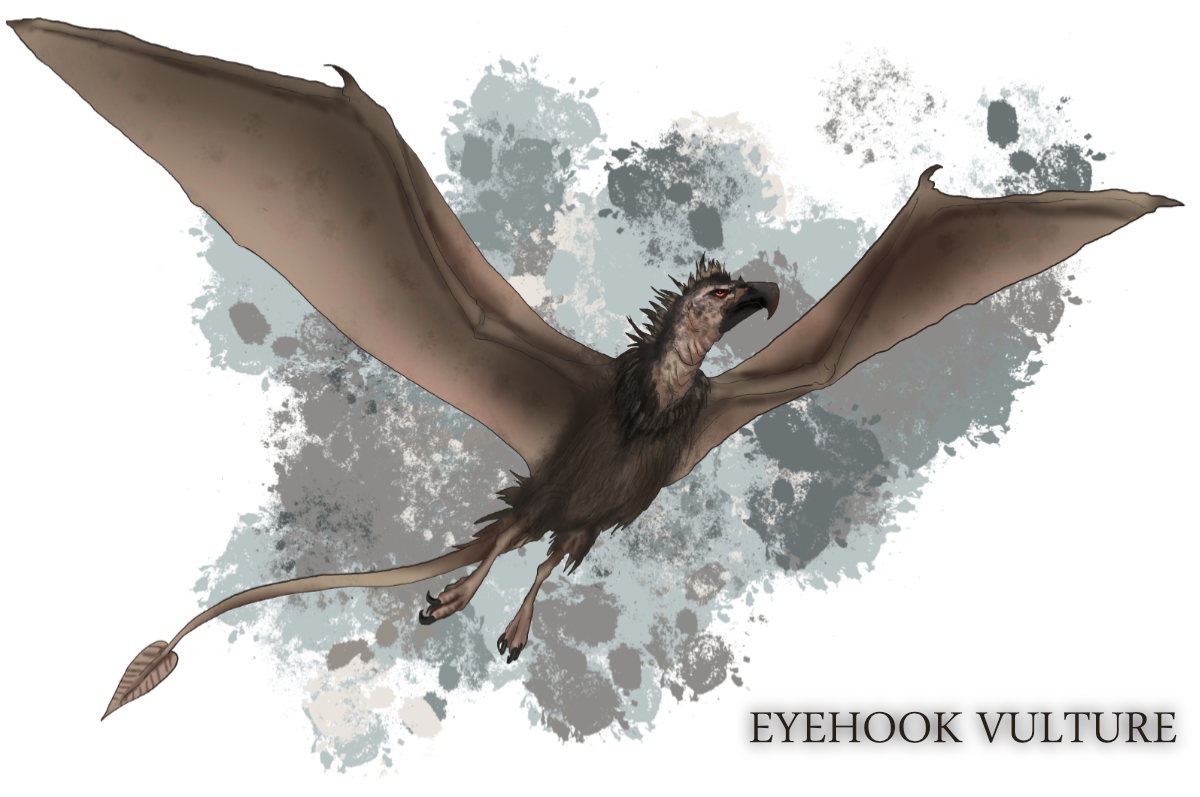 | Eyehook Vulture Location(s): Hydra Danger Level: Deadly Diet: Carnivore Length: 20+ foot wingspan Quirk(s): Hydra-only, huge, deadly, aggressive The Eyehook Vulture is a scavenger and predator whose range covers all of Hydra's treacherous reaches. With a wingspan of nearly twenty feet (and even larger for some individuals, such as Matriarchs), it can carry off even deer-sized prey. The Eyehook Vulture is known for being extremely aggressive, and extremely dangerous--and for good reason; it's named for its propensity for gouging at the eyes of potential victims. These vultures vary widely in appearance. Some are fully-feathered, some with leathery wings; some have short, fan-feathered tails, others long and whiplike. Many are dusty brown in color, but others are red, pale buff, or even black, or combinations of the above. These birds roost in large colonies in the highest plateaus of the Crucible, but circle the Dead Marsh, the Dunes and the Salt Flats in search of food. Even they, however, must often rest in the shade through the worst heat of the day, and cannot circle for long at midday. |
Cave Snakes
Cave Snakes vary widely in appearance, but share long, usually limbless, scaled bodies and a carnivorous nature. Though most avoid Greater Gembound or anything larger than themselves, some species are more aggressive. Cave Snakes seem to serve to manage the population of prey-type Lesser Gembound. Though spread throughout the caves, they are never numerous, and an encounter with a Cave Snake in the open is fairly uncommon.
Cave Snakes vary widely in appearance, but share long, usually limbless, scaled bodies and a carnivorous nature. Though most avoid Greater Gembound or anything larger than themselves, some species are more aggressive. Cave Snakes seem to serve to manage the population of prey-type Lesser Gembound. Though spread throughout the caves, they are never numerous, and an encounter with a Cave Snake in the open is fairly uncommon.
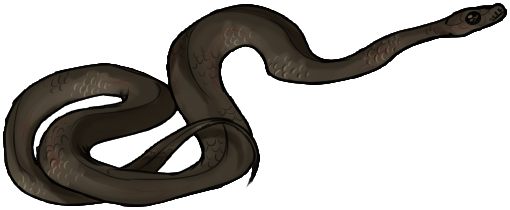 | Fleasnake Location(s): Dark, moist areas, or anywhere with foliage Danger Level: Parasitic Diet: Blood Length: 5 inches Quirk(s): Blood Parasite, Tiny Size A tiny, flat-bodied serpent up to five inches long with a small head. They are eyeless and a translucent dark brown (with blood meals visible within), with heat-sensing pits and a sensitivity to passing vibrations. These creatures remain in a torpor, coiled like a spring, until prey passes by. They are capable of surprising leaps to attach themselves to a host, where they burrow under any available scales or fur and live off of the host's blood. They produce a mild venom that numbs the region of the bite, and remain attached until removed or ready to part ways with their host to reproduce elsewhere. A heavy Fleasnake infestation can weaken a host through blood loss, and cause itching and degrade the fur, scale or skin quality. It can mostly be found in Cetus, Eridanus and any other cave with moist, loose substrate. |
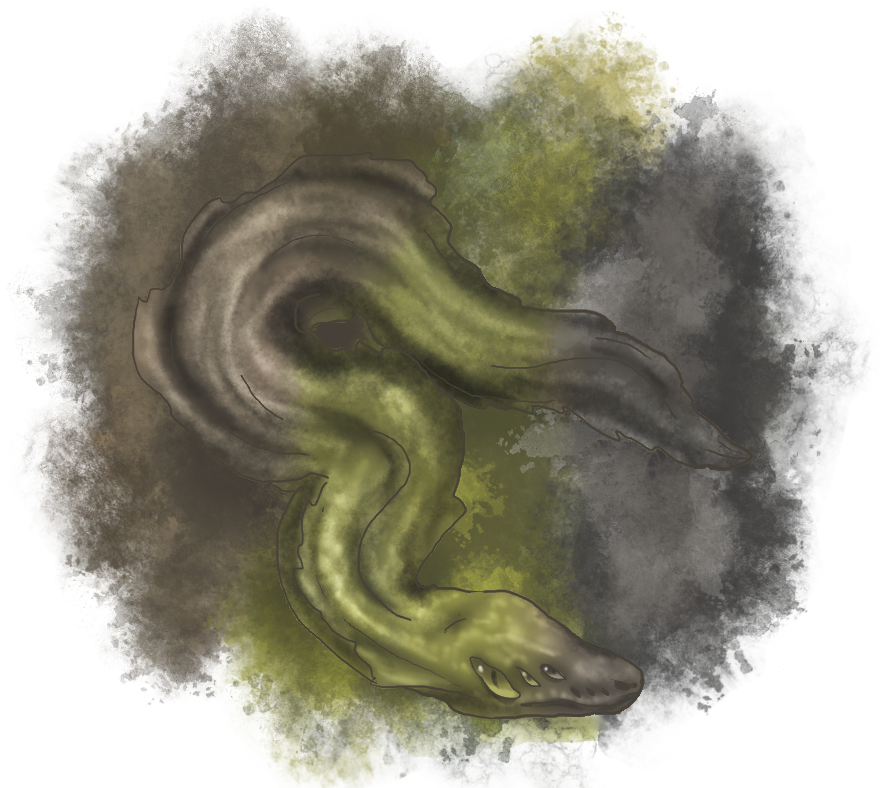 | Lurker Location(s): Darker, Damper Regions Danger Level: Dangerous to smaller creatures Diet: Carnivorous--whole prey Length: 10 ft Quirk(s): Camouflage, fins A heavy-bodied constrictor that can reach up to ten feet long. It is primarily found in darker, damper patches within the caves, sometimes swimming in water, though it does sun itself sometimes. Fornax, Cetus and Polaris often have a few of them present. The Lurker is capable of camouflage, its body shifting color to near-perfectly match its surroundings. It strikes powerfully when prey passes by, coiling its powerful body to squeeze the air and consciousness from its victim, which is then swallowed whole. The snake can take prey up to the size of, for example, a wolf or goat. When seen without camouflage, this snake is dusty brown and bears two sets of two eyes along the side of its head, and a fifth eye at the center of its forehead. Rather than perfectly smooth, its sides are ridged by fin-like protrusions running the length of its body on either side, helping it to maneuver and climb. |
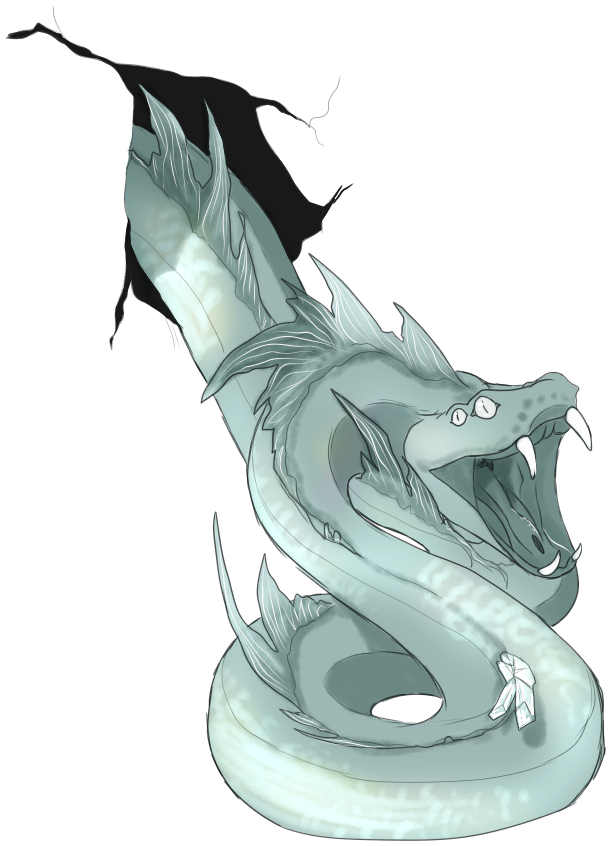 | Frostbiter Location(s): Dark, Cold Areas, ex. Pisces or Ursa Danger Level: Dangerous to smaller creatures Diet: Carnivorous--whole prey Length: 10 ft Quirk(s): Cold-weather adapted, venomous A very slender, thick-cheeked viper-like creature with two pairs of eyes and long, fishlike fins, which are often ragged from fighting. It is translucent, with a pearly blue sheen, matching it well to the cold crevices in which it makes its home: Tunnel M, Pisces, and Tunnel H. It thrives in the cold, and is both solitary and extremely territorial, making it very unusual to find more than a few in any of its home caves. Its venom induces localized paralysis and weakness in the limbs, like a sensation of frostbite. At around ten feet long, it (like the Lurker) can take prey up to the size of a dog. |
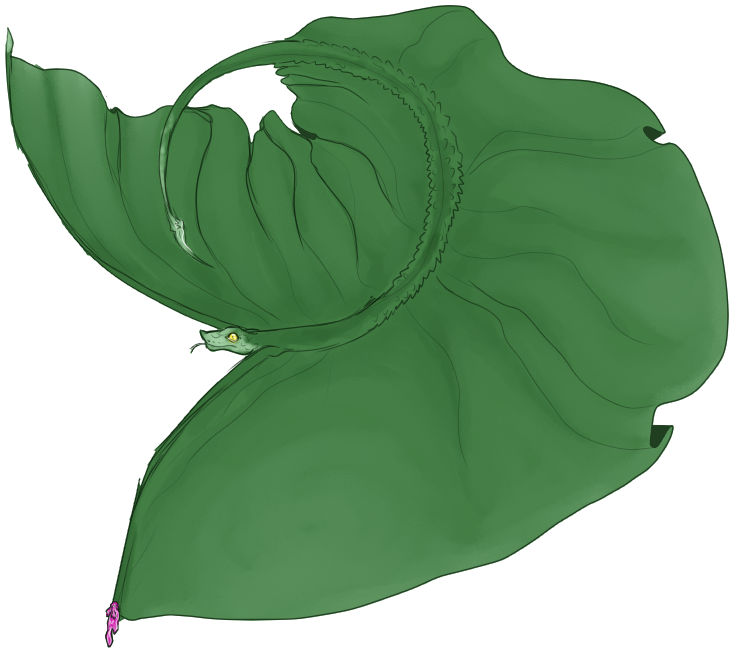 | Whipleaf Location(s): Anywhere with trees Danger Level: Dangerous to smaller creatures Diet: Carnivorous--whole prey Length: 2 - 5 ft Quirk(s): Arboreal, somewhat social A small, thin, tree-dwelling viper up to a few feet long. It is found in any cave with trees, and subpopulations tend to match their home cave, generally in shades of green or brown. The scales are small and smooth, running out from the spine rather than parallel to it, and it sports a large fan running the length of its body and beyond the tail, which ends in a long, hard point of keratin. This fan and spike camouflages the snake as a leaf, or (when flattened to the body) it can imitate vines, hanging loosely from branches. The spike can also be wielded as a powerful slashing tool in self-defense, inflicting deep cuts in attackers and causing heavy blood loss. The snake can jump great distances and spread its fan to glide quite far between trees. Its venom is mildly itchy, but it is less aggressive than other snakes, preferring to eat small prey, like mice and insects. They sometimes live in small colonies. |
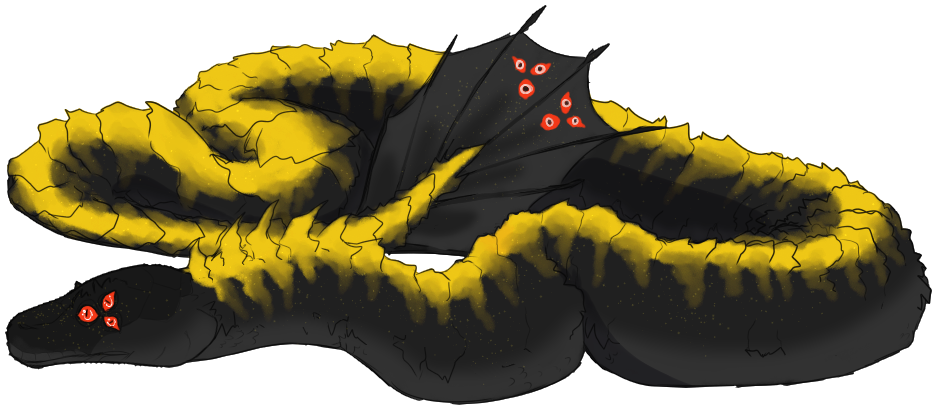 | Golden Charger Location(s): Anywhere with trees Danger Level: Dangerous Diet: Carnivorous Length: 3 - 4 ft Quirk(s): Armored, “Stonerot” venom, can segment larger prey A squat, three-to-four-foot-long snake with a heavy, muscled body and rough, thick scales that act as armor; the belly and the sensitive face are unarmored. In color it is a striking coal-black with a line of glittering gold along the spine and golden freckles along its body. These snakes are typically quite territorial and remain in a fixed area around their home dens, only charging out to attack intruders. They have a circle of three eyes on each side of their heads, bright and gem-like, which can come in various colors; these eyes are falsely-mirrored on the flared tip of their tail, which they flick about to attract prey. This tail can be regrown if bitten off. Their bite carries venom which inflicts a dangerous condition called "Stonerot," rapidly calcifying the surrounding tissue. Small prey quickly succumb to organ or respiratory failure, and larger prey can be seriously maimed by the bite. The calcification can never be wholly reversed. Most stonerot-afflicted prey animals are difficult to consume as meat, but the snakes use their serrated teeth to slice chunks to swallow, and compress this, for digestion, with their powerful muscles. Golden Chargers, given their venom and ability to cut prey into manageable chunks, will take prey of any size: larger Gembound are not safe from attack. |
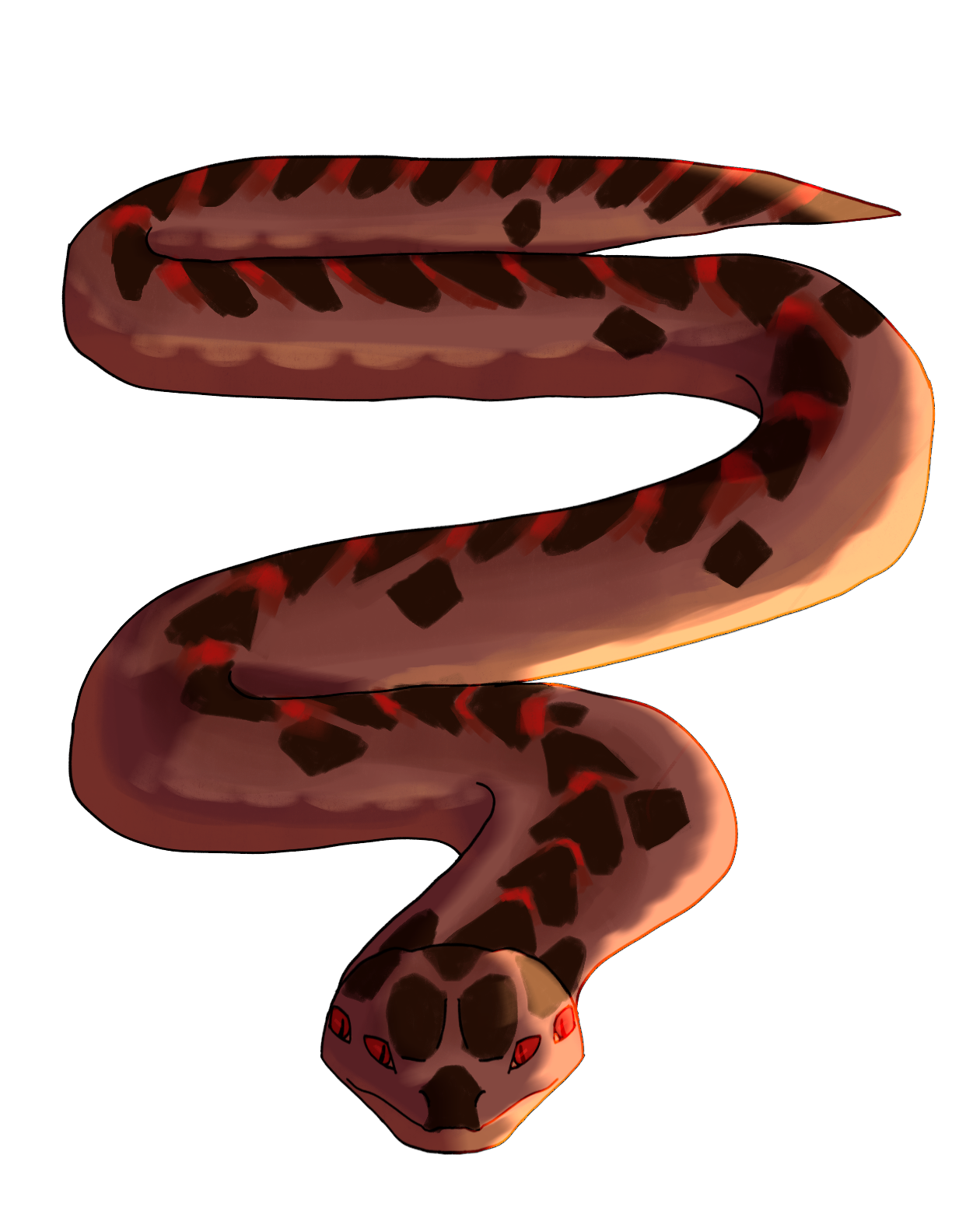 | Basilisk Location(s): Lower Leo, anywhere very hot Danger Level: Dangerous if provoked Diet: Carnivorous Height: 4-5 feet Quirk(s): Searing venom, red camouflage These snakes are solitary, feeding mostly on Red Mice and the occasional Lava Rat, along with anything else they can catch and eat. Found only in very hot regions, they're generally a bright red-brown, like clay, though can be variously patterned with lava-red and black. Their scales are rough and diamond-like, so that when basking in the heat of Leo's forge, they can be easy to mistake for rock. They tend to ignore larger Gembound, but if provoked, their bite can deliver an agonizing venom: a searing-hot toxin that make the victim feel as though they are burning alive. It likely has some chemical similarities to capsaicin, and is generally completely debilitating to even the largest Gembound for hours. The very careful and very knowledgable can harvest this venom: either as a poison, having similar effects when consumed, or as a watered-down poultice that aids greatly in preventing infection and promoting new growth in wounds. |
Cave Lizards
Cave Lizards are quite small, growing up to only one foot in length (not including the tail). They range in color from earth grays and browns to blues or pale yellows depending on species, but generally share a lithe, reptilian build and rows of sandpapery teeth. They prefer warm, dry locations over cool, damp ones.
Cave Lizards are quite small, growing up to only one foot in length (not including the tail). They range in color from earth grays and browns to blues or pale yellows depending on species, but generally share a lithe, reptilian build and rows of sandpapery teeth. They prefer warm, dry locations over cool, damp ones.
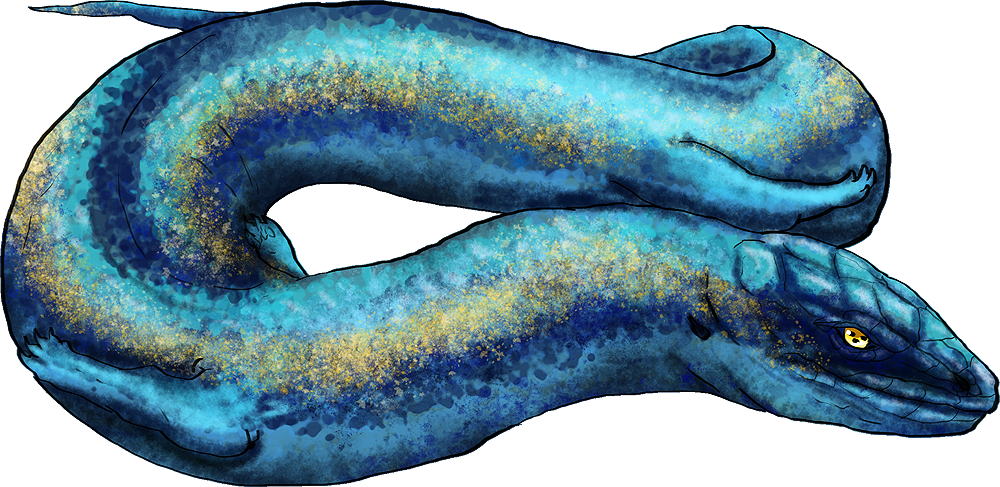 Lesser Snake | Location(s): Anywhere warm and dry Danger Level: Harmless Diet: Insects, tiny prey Length: 8-10 inches Quirk(s): Docile nature, vestigial limbs Though called a snake in name, the Lesser Snake is distinguished from true Cave Snakes by the vestigial limbs that hang tiny at their sides. These creatures are quite docile and fairly shy, avoiding conflict and confrontation. They prefer instead to hide entirely until they grow hungry and need to search out prey. Their scales are usually blue or yellow. They serve as predators of the tiniest Lessers, and food for the rest. |
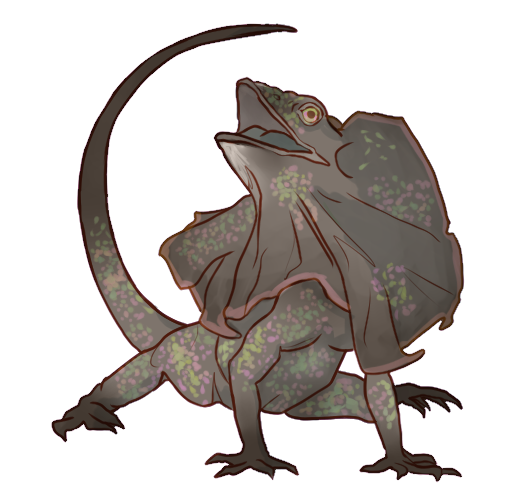 | Frilled Chaser Location(s): Anywhere warm and dry Danger Level: Territorial, but not dangerous Diet: Omnivorous Length: 10-12 inches Quirk(s): Large frills, colorful spots, bipedal threat displays Frilled Chasers earn their name through two features: their enormous, extendible neck frills (not unlike umbrellas around the throat’s circumference) and their extremely territorial nature. Regardless of the size of the intruder, a Frilled Chaser will extend its skin frill and stand on its hind legs, mouth agape and usually hissing; they can look far larger than their size like this, and will usually charge and even bite their opponents. A frilled chaser might latch onto an enemy and refuse to let go, but for the most part, their bites are quite harmless. They feed on insects, foliage, fruit, and more rarely carrion, and sometimes seek out nuts or seeds. In appearance they are usually grey, from sandy to steel to grey-green, and universally share brightly-colored spots that cover their bodies. The spots are different in pattern and color for each individual, and some rare Frilled Chasers have spots of a variety of colors. |
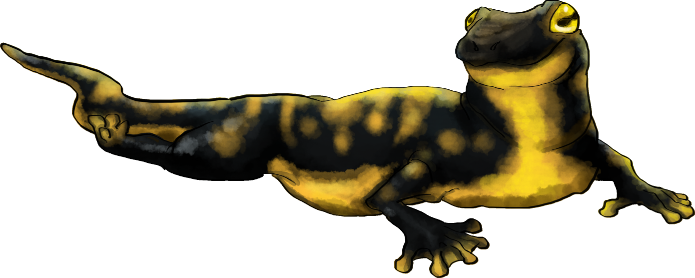 | Slime Belly Location(s): Everywhere Danger Level: Harmless Diet: Insectivorous Length: 4-8 inches Quirk(s): Thick slime, insectivorous, bright colors Slime Bellies are more amphibious in appearance than reptilian, featuring a soft, slick body coated in slime. The bright colors and patterns on the scales beneath serve the same purpose as the slime: deterring predators. The slime is toxic, and if ingested without cleaning it off can induce extreme illness (vomitting, headache, stomach cramps) for a few days, though it isn’t fatal. They are generally brown or grey, with a few blue exceptions, but the stripes and spots along their bodies can be of any vibrant hue--and in darker caves, are often bioluminescent. They, unlike the other lizard species, do sometimes live in damper or darker locations. They feed almost entirely on insects, which they catch with a long and sticky tongue, though they do sometimes feed on fallen fruit. |
 | Firetongue Location(s): Lower Leo, anywhere very hot Danger Level: Harmless. Adorable. They won't hurt you... Diet: Carnivorous Length: 2 ft Quirk(s) Completely not dangerous at all. Friendly. Firetongues are very cute lizards. They |
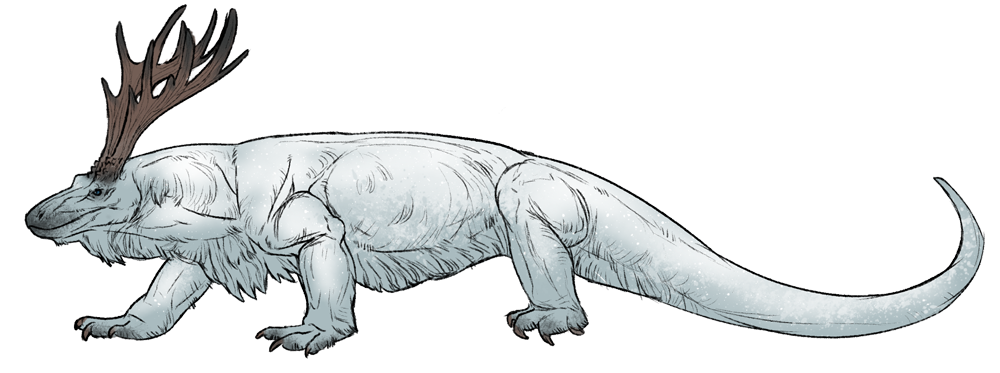 | Icebeast Location(s): Ursa Danger Level: Deadly Diet: Carnivorous Length: 6-12 feet Quirk(s): Very rare; very large Icebeasts are cold-adapted to an extreme. Based on a reptilian design, they look almost like a komodo dragon in basic form: long-bodied and squat, with a downward-hanging, massive head and long tail. However, they're an icy white, their scales adapted into a feather-like insulating structure that gives them an almost fluffy appearance. Icebeasts are very rare, with only a dozen or so full-sized specimens found throughout Ursa, and a number of younger ones competing for survival. They eat anything they can find, with the smallest subsisting mostly on Ice Mice and the largest struggling to hunt Snow Deer. Horns resembling antlers branch back from their heads, providing a method of signalling to others: only the largest, most mature specimens will have a large set of horns and only the strongest hunters will have a healthy rack. A blue-tipped white tongue often flicks out to taste the snowy air, and these creatures often burrow beneath the snow to sleep. They are at least partially warm-blooded, though can survive being frozen nearly solid. |
Cave Aquatics
There are many, many different types of fish and other water-adapted creatures in the underwater ecosystems of Origin. Some are small, some blind, some are colorful, some dull. A few of the common species are listed here for reference. Note: all species of fish (even the shark-like ones) are slimy, but taste good if a carnivore can get past that texture.
There are many, many different types of fish and other water-adapted creatures in the underwater ecosystems of Origin. Some are small, some blind, some are colorful, some dull. A few of the common species are listed here for reference. Note: all species of fish (even the shark-like ones) are slimy, but taste good if a carnivore can get past that texture.
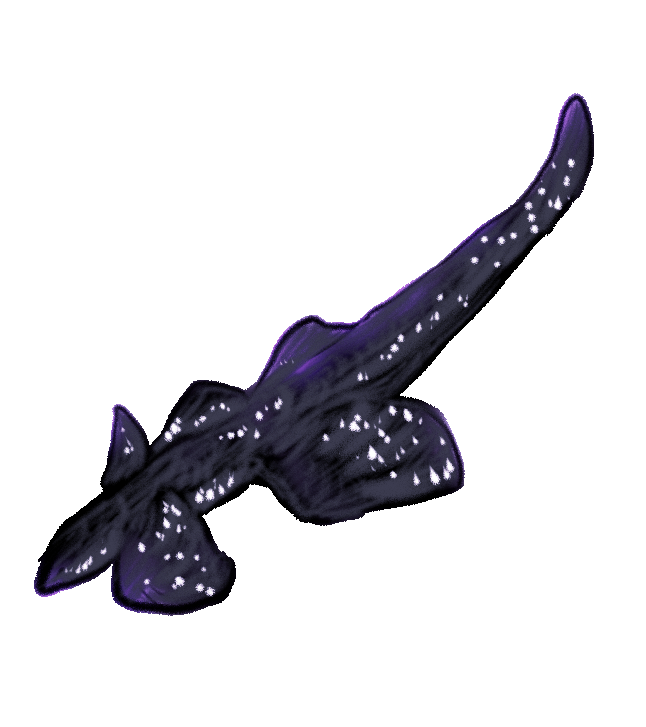 | Orion’s Scale Location(s): Everywhere Danger Level: Harmless Diet: Herbivorous, Insectivorous Length: 6-12 inches Quirk(s): Glittering scales, blind These beautiful fish have dark scales with little pinpoints of mirror-like shine that reflect light brightly, rendering them not unlike the ceiling of Orion. They are no exception to the rule of Origin’s fish being slimy, though their coating is thinner than many. They are obviously blind, lacking any eyes, and generally browse algae and foliage just beneath the surface, though will also take any insects whose vibrations they sense above them. |
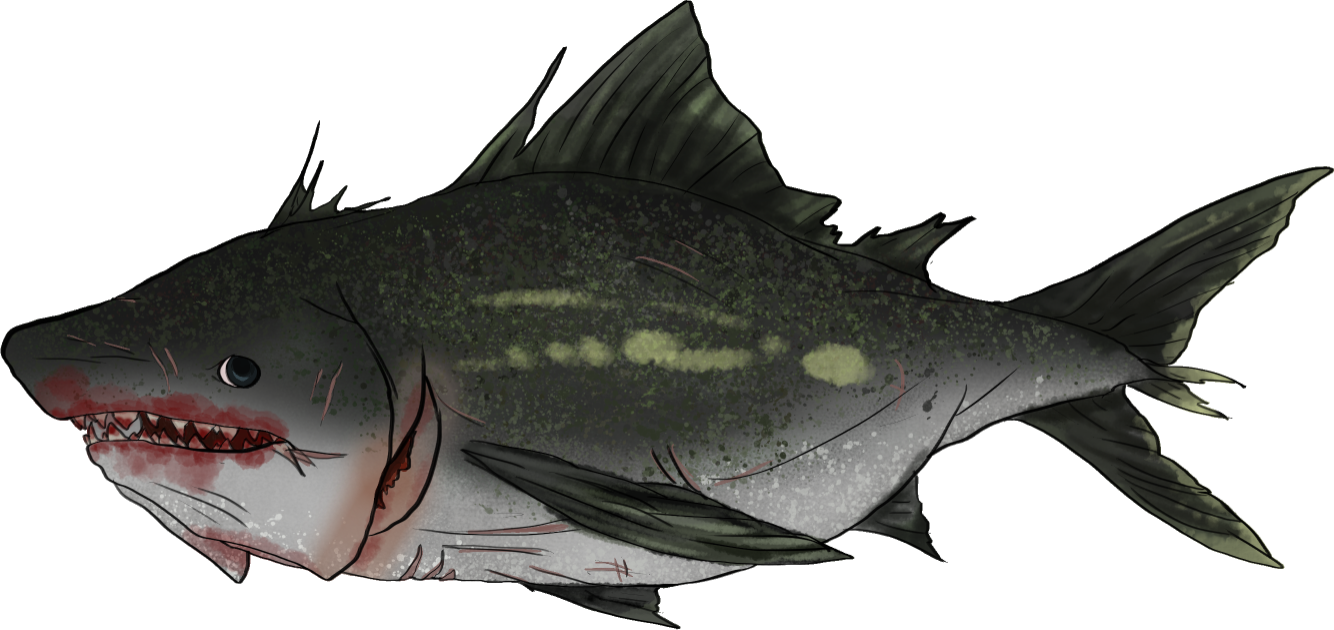 | Redfang Location(s): Everywhere Danger Level: Deadly Diet: Carnivorous Length: 4-5 ft Quirk(s): Enormous, dangerous The Redfang is easily Origin’s largest Lesser Gembound fish species, tipping the scales at around a hundred pounds on average, though there are outliers. Their fangs and the area around their mouths is usually a reddish color--whether naturally, or stained with previous blood, is unknown. They are violent creatures and very strong, going into a frenzy at the scent of blood, and while usually solitary, several of them can turn up when large, struggling prey bleeds into the water. At these times they may also turn on one another. However, if a Redfang can be subdued, they yield a great deal of meat with a very good flavor. Their skin is a rough, slimy dark grey with a pointed dorsal fin that can sometimes be seen as they swim near the surface, hunting. Thankfully, Redfangs are never very commonplace, with usually only a few for any given cave. In Fornax, they tend to swim lower, hugging the warm vents deeper down. |
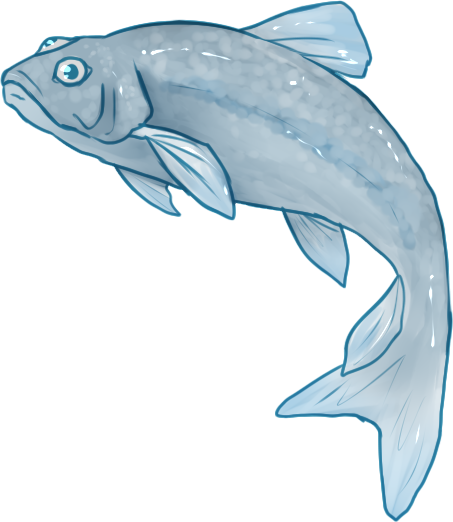 | Silverling Location(s): Everywhere Danger Level: Harmless Diet: Carnivorous Length: 4-12 inches Quirk(s): Schooling fish, many-eyed Silverlings are fairly small, silver fish, the most common in the caves, often with hundreds in any given body of water. Generally they are smaller, six or so inches long, but older or unusual fish can grow to about double that. They swim in large schools, moving and turning together with the light flashing off their scales. They generally swim nearer the surface, feeding off smaller organisms and insects, and are therefore usually easy to catch. Silverlings each keep watch for danger with three silver eyes: one to each side, and one in their forehead. |
 | Whiteling Location(s): Darker, cooler caves Danger Level: Harmless Diet: Omnivorous Length: 6-15 inches Quirk(s): Blind, pigment-less, very slimy Whiteling are primarily found in Cetus, though some swim deep in Pisces, Polaris, or the connecting underground waterways. They are pure white, their scales without pigment, but rather than attractively gleaming they are dull with the extra-thick slime that coats them. They are usually a slow-swimming species, their sightless pink eyes useless but their underwater sense of smell strong; they use this to patrol marshy channels or still waters, seeking anything they can eat. This can be the detritus of dead foliage, live plants, smaller fish, insects, carrion, fallen fruit and more. If the slime can be scraped away, and especially if the fish can be roasted, its meat is nutritious and very flavorful. |
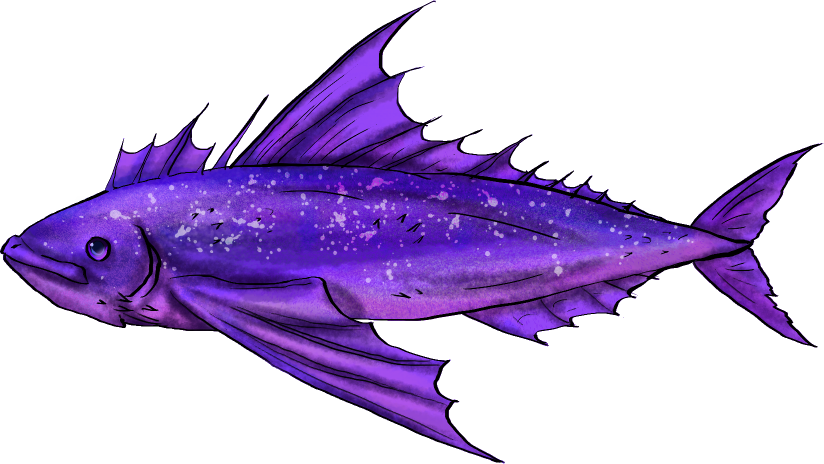 | Purple Starscale Location(s): Shallow Pools Danger Level: Harmless Diet: Omnivorous Length: 1-3 feet Quirk(s): Very fast, bright purple Purple Starscales are medium-sized fish with colors ranging from pale lilac to bright magenta to a rich, dark purple. They prefer shallow pools, but can be found throughout the caves, usually in low numbers and small groups. Females breeding naturally move to larger bodies of water to lay their eggs. These fish feed off of algae and other small organisms, but are opportunistic in nature, generally eating anything they can get in their mouths. They are slender fish, generally darting away from danger with surprising speed and agility, making them difficult to catch. In addition, their long fins allow them surprising leaps over the water's surface, through the air. |
 | Decorator Crab Location(s): Everywhere Danger Level: Harmless Diet: Omnivorous scavengers Height: 1-12 inches Quirk(s): Appearance varies widely by cave These shy, generally harmless crabs are capable of living either on land or in the water, and though a single species, come in a wide variety of colors and sizes. Their only real defining characteristic, aside from a similar body shape, is their reuse of objects and shells discarded by other creatures for use as their own new shell. They can be found in Skullcrab or Luckbite shells, suitably-shaped gemstones, and more. They are also known for their habit of gathering up any objects nearby and using a long-drying paste saliva to affix it to their shells. These objects help them blend in, and are defined by the caves in which they live: land-dwelling crabs in Canis or Eridanus use bones or plants, for example, while water crabs might use fragments of Luckbite shell or bits of seaweed. In some places, they will also build themselves small huts constructed of local items. Beneath the shell lies a softer body with ten hard-shelled legs, all of which bear small, fairly harmless pincers; four eyes stand on short, thin stalks. Decorator Crabs are scavengers preferring detritus, serving as cleaners in the caves--any rotting foliage, abandoned carrion, and so on is fair game. |
 | Skullcrab Location(s): Deep waters Danger Level: Dangerous to smaller Gembound Diet: Omnivorous, prefer meat and fish Length: 1-3 ft Quirk(s): Small, glowing eyes in sockets These crabs are found only in deeper waters, and are somewhat larger than Decorator Crabs. Their shells are usually shaped like a humanoid's skull, possibly as a defensive display or deterrant. These bear pointed spines that can be dangerous to bite. Rather than small, harmless pincers, Skullcrabs bear powerful, shearing forelimbs capable of cutting through meat, which they prefer in their diets. Though they prefer to utilize their shells for defense, they're more aggressive than Decorator Crabs, and capable of surprising speed and ferocity. They can be dangerous to Gembound smaller than their size, which is usually a foot or two in breadth from one side of the shell to another. Skullcrabs usually hunt small fish or scavenge carrion, but can eat almost anything. |
 | Lanternfish Location(s): Deep Waters, Mostly Fornax Danger Level: Potentially Dangerous Diet: Carnivorous Length: 1-3 ft Quirk(s): Luring fins often tattered; vicious in groups Lanternfish are medium-small, and very silvery and reflective in bright light. But they live far beneath the black depths in Fornax, appearing darker in hue. These fish trail both long tailfins behind them and a lure before their head that can flash and glow with variously-colored bioluminescence. These lights lure in smaller prey, which the Lantern Fish dispatches with a massive set of jaws and long, hooked fangs. Though extremely dangerous to small creatures, they avoid larger opponents unless they hold an advantage of numbers--in which case they can become aggressive, surrounding a larger target and darting in from behind to attack, gradually wearing it down and killing it. |
 | Lightning Ray Location(s): Warmer, deeper waters Danger Level: Unaggressive, but deadly Diet: Omnivorous Length: 1-2 ft Quirk(s): Capable of powerful electrical shocks These creatures are bizarre, horizontally-oriented, like birds with soft, always-spread wings. They ripple their way in long glides through the waters of the caves, either alone or gathering in larger groups to feed. They're generally harmless, using their powerful jaws to feed on only smaller creatures or available foliage, but if a threat draws too close the Lightning Ray will employ its defense: a shock from ionized glands along the dorsal line of the body. These course over the Ray and a short distance into the surrounding water, stunning anything close and delivering a potentially fatal shock to anything actually biting or gripping the Ray. These rays are usually only one or two feet long, plus another foot or more of tail, but in exceptional cases can grow four or five feet long plus tail. |
 | Snatcher Location(s): Deep waters Danger Level: Mostly Harmless Diet: Carnivorous Length: 1-10 ft Quirk(s): Slow growth and long age results in wide size range Snatchers are strange creatures, generally small and intelligent, even curious and sometimes friendly. They are capable of rapidly changing colors, and bear a venomous bite with strong, bone-plated jaws for defense. Their body, a cephalopod-like mantle, can change shape from smooth to seemingly spiky (though it remains soft to the touch) for textural camouflage. Six to twelve arms (the number varies) and any various number of eyes from one to twenty or more decorate these creatures. Snatchers are so named because they, being curious and usually fearless creatures, tend to steal anything they find interesting and swim away with it, either discarding it after growing bored or stashing it in a hidden hoard. They are rarely aggressive, and even in self-defense employ their paralytic venom in order to simply escape. They eat small fish, Water Crawlers, and Luckbites, prying the latter open with strong tentacles. Snatchers are very long-lived, taking many cycles to gain a single foot in length. Some very few may survive to grow into the behemoths known as Krakens. |
 | Kraken Location(s): Very Deep, Dark Waters Danger Level: Deadly Diet: Carnivorous Length: 10-40+ ft Quirk(s): Ambush hunters, camouflaged Only the eldest, most fierce and cunning Snatchers survive to leviathan size, going from fearless and curious to voracious predators. Though a Kraken who isn't hungry will generally hide, they're so large that they're almost always hungry. Being that they retain their camouflage abilities and paralytic bite into massive size, the Kraken is an incredibly dangerous predator--but rarely numbers more than one or two per cave, and remain in the deepest, darkest depth of Origin's waters. When hunting, they will use powerful limbs (some of which are tipped with hardened points) to ensnare and spear prey in an incredibly strong grip, and then apply the paralytic bite and massive jaws to paralyze and shred their prey. |
 | Deep Death Location(s): Dark waters Danger Level: Deadly to smaller Gembound Diet: Carnivorous Size: 4-6 ft leg-span Quirk(s): Often overgrown with moss or clinging molluscs These creatures look much like long-legged, spindly crabs, but are actually deadly spiders adapted to deep water. In fact, they're still capable of spinning proteins into thick and sticky webs that retain their adhesive properties even underwater; it's not uncommon to find a narrow passage in the deep dark blocked by a thick, nearly-invisible spider's web. The Death tends to lurk nearby, and wait for prey to tire itself out, their bodies well-camouflaged to underwater, rocky surfaces. But if needed, its chelicerae can deliver a powerful venomous bite that causes numbness and physical weakness. Once prey is weakened, the Deep Death spins it into a web, and feeds at its leisure. While mostly found in very deep waters, these creatures can be found anywhere the water is very dark, including the water channels that run beneath the caves. |
 | Lightsting Location(s): Deep Waters Danger Level: Unaggressive, but deadly Diet: Carnivorous (small prey) Length: 2-4 ft Quirk(s): Family groups display unique glows These creatures are not unlike eyeless Snatchers, but they are translucent, and from the center of their arm-like tentacles drifts a mass of longer, more flexible tendrils. These are used to trap small fish and Water Crawlers and the like, with a deadly neurotoxic sting capable of paralyzing the creature's body, respiratory system and heart. Lightstings are intelligent for Lessers, communicating intent with one another via a series of bioluminescent flashes in a variety of colors and patterns; they tend to read Greater intentions fairly well, leaving Greaters alone unless truly threatened. Even a brush with the tentacles can come away with no sting if truly accidental--but if startled or threatened, the Lightsting's venom can kill even large Gembound. These creatures float in small groups, and will come to one anothers' defense if need be. They navigate through vibratory sensation and sound, with two large, flapping pieces of flesh serving as ears and fins both. |
 | Luckbite Location(s): Any water Danger Level: Harmless Diet: Filter feeders Length: 1-8 inches Quirk(s): Vastly varied Luckbites are molluscs with a wide variety of shell shapes, sizes, colors and even materials: as they grow, they are capable of incorporating substrate, other shell fragments and even gemstones into their own expanding shells. Within the shell is a simple muscle, with a "foot" capable of reaching out and moving them along or grabbing and manipulating objects. Luckbites will eat anything, and are so named because of the high-risk, high-reward nature of eating them: some might be toxic from their diet, some might be highly nutritious, and others might be hiding gemstones or other precious objects within their shells. The shells themselves can close, and stay closed, very tightly--they must be crushed, or pried open with immense force, to harvest the meat within. |
 | Water Crawler Location(s): Any water Danger Level: Harmless Diet: Filter feeders Length: ~6 inches Quirk(s): Very cute Most aptly compared to shrimp, Water Crawlers are usually very small, multi-legged, and segmented creatures with a single pair of pincers used mostly for manipulating objects. Three eyes peer out from between each of the seven body segments: one to each side, one directly down the back. Water Crawlers are highly omnivorous scavengers, and necessary--as are Luckbites--for clean water; they eat absolutely anything, from plant detritus to bone fragments. They rely on rapid reproduction for their numbers, and this combined with the two long, broad "ears" (actually formed of hard shell) for sensing vibration have earned them the second nickname of "water rabbit." |
 | Drinker Location(s): Still waters Danger Level: Parasitic threat Diet: Blood Length: 3-6 inches Quirk(s): Can get swept away and wind up in strange places These creatures appear, at first glance, to be beautiful and varied bioluminescent sea slugs. Usually dark in color, they're streaked with lines and spots that can flash and pulse in bright colors. These seem to serve the purpose of very simple communication with other Drinkers, calling them to food or warning them of danger, or perhaps seeking potential mates. Generally, Drinkers remain in or around water, preferring stagnant and swampy water or very deep, cold depths. They avoid fast-running waters, and are thus very rarely found in rivers. This allows their simple bodies to navigate more easily, without being swept away--and allows them to find their prey more easily. The Drinkers are actually parasites, which latch on to any larger beast that draws too close; their lamprey-like mouth is extremely difficult to remove, and they will hold on and grow fat on that creature's blood. Extreme heat will remove them, or simple brute force, but tearing them away can leave a nasty bite wound. Sometimes it is better to leave them be, for the Drinker's saliva contains both antibacterial and painkilling properties, which can prevent pain and leave the wound healthy when at last they have drunk their fill, and fall away. Accidentally gaining large numbers of these parasites, though, can be very dangerous, as they each tend to drink a surprising amount of blood. Despite their bright colors, they are edible to carnivores, and quite nutritious as a meal. |
Cave Spiders
Ranging in size from almost microscopic to the size of a large dog, these arachnids can be downright terrifying to an unsuspecting creature. Some have thick, bristly fur, and some secrete deadly venom from their fangs or poison from their bodies. Most are capable of producing strong, silk-like webbing. Though many of them have their locations described by preference, all cave spiders also occur in Cetus.
Ranging in size from almost microscopic to the size of a large dog, these arachnids can be downright terrifying to an unsuspecting creature. Some have thick, bristly fur, and some secrete deadly venom from their fangs or poison from their bodies. Most are capable of producing strong, silk-like webbing. Though many of them have their locations described by preference, all cave spiders also occur in Cetus.
 | Spitting Bug Location(s): Dry Locations Danger Level: Dangerous to smaller creatures or threats Diet: Smaller vertebrates Length: 1-2 feet Quirk(s): Spits venom from its back, bioluminescent markings The Spitting Bug is a spider, despite its name, with eight long legs and a furry body. This body is either white or black, and it bears glowing red markings. The back of its abdomen sports a pseudo-mouth that allows it to spit venom with deadly accuracy. This venom can, after very brief absorption through the skin, paralyze smaller prey (usually Cave Mice) and cause skin rashes or irritation when used against larger threats. Though this spider will usually avoid confrontation with larger creatures, it will defend itself if closely-approached or cornered. One additional danger it poses is the effect the venom has on eyes: if it gets into a creature’s eyes, it can cause temporary (in the case of a couple drops) or permanent (if a full venom stream) blindness. |
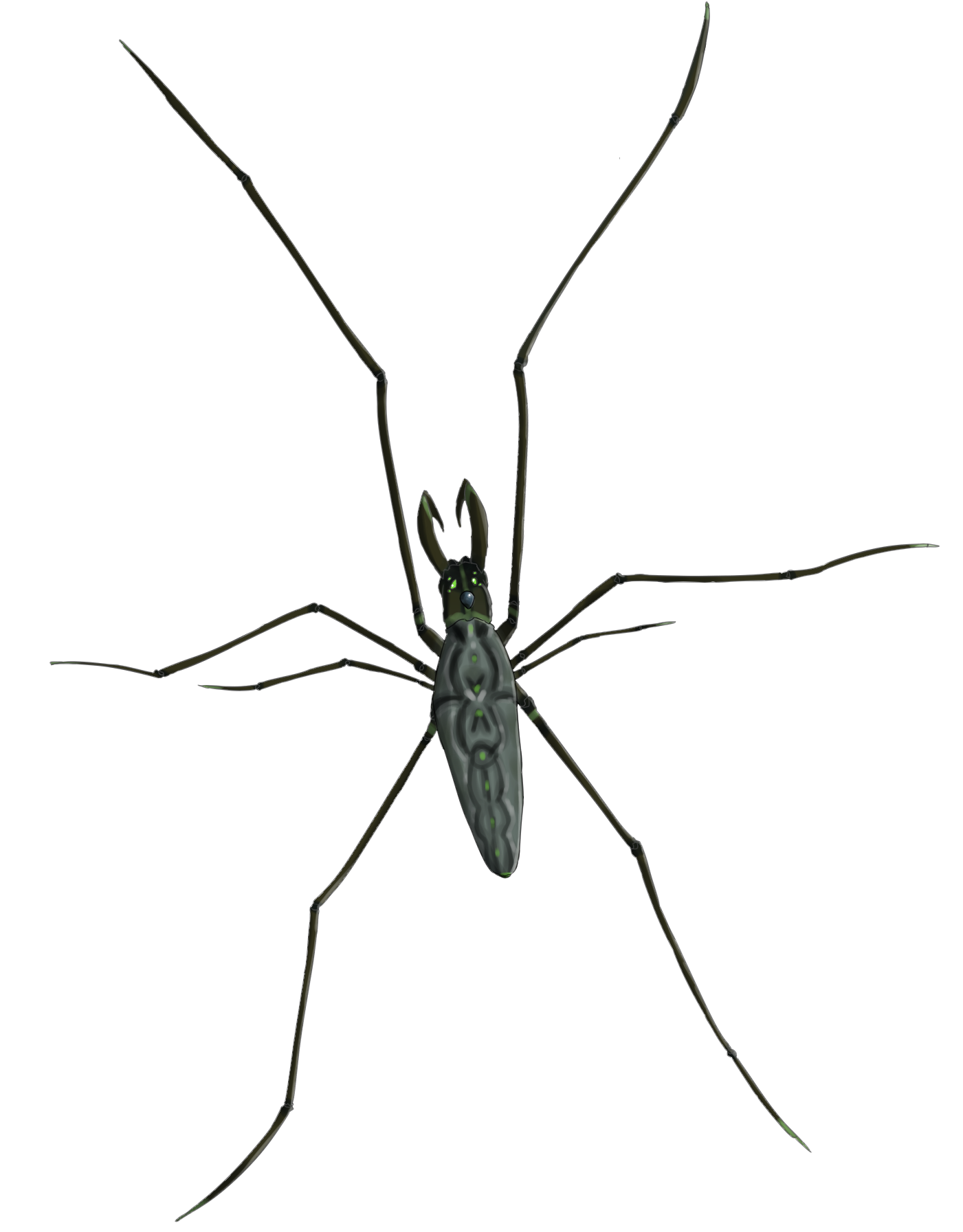 | Water Walker Location(s): Still bodies of water Danger Level:Harmless Diet: Insects, small fish Length: 8-15 inches Quirk(s): Walks on water, can breathe beneath water These are medium-to-large spiders that can be found walking across the top of lakes, pools and marshes. They are harmless to larger Gembound, avoiding anything bigger than themselves, and bearing no venom with which to defend themselves. Though strong, their bodies are very thin, making eating them offer little nutrition--and their furry bristles, when swallowed, can be an irritant. Water Walkers prefer to be left alone, living quietly solitary lives where they stalk small fish from the water’s surface and then retire beneath the pools to rest. They bear small gills, allowing them to breathe underwater, and any given Walker usually has one or more small underwater nests. They blend well with their environments, with populations usually locally adapted to the surrounding color, which is usually be blue, gray or green. |
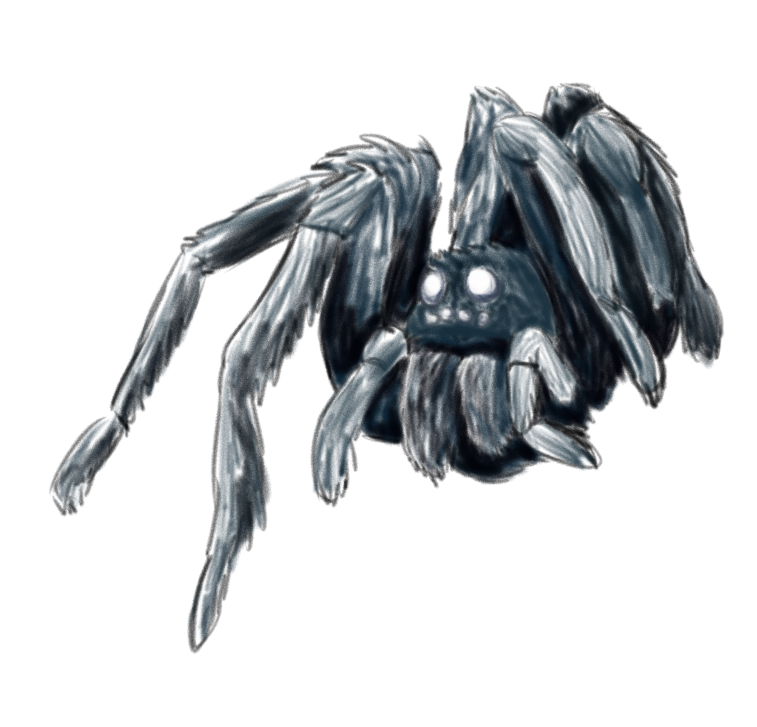 | Phantom Biter Location(s): Burrows, holes, crevices Danger Level: Bite induces hallucinations Diet: Smaller bugs Length: Miniscule Quirk(s): Very small, strong camouflage, strong and venomous bite One of the tiniest spiders in the caves, and endowed with a shifting, strong camouflage, the Phantom Biter is rarely actually seen. Given its preference for abandoned burrows, holes, dens or crevices, they are often encountered by Gembound seeking hidden shelter. The Phantom Biter will flee if possible, but when cornered (as they are when a larger creature tries to take shelter in between them and their exit) they will bite a threat. Their fangs are large, and jaws surprisingly strong, for something so tiny; they can pierce most skin or even leathery hide with ease. This bite can cause powerful hallucinations in the victim, so that it’s difficult to tell what is real and what is not. Though often terrifying, some might use this bite recreationally, if they can somehow find a spider; it’s not physiologically dangerous. |
 | Silk Spider Location(s): Eridanus, anywhere with foliage and water Danger Level: Harmless Diet: Small vertebrates Length: ~1 ft Quirk(s): Bioluminescent, large webs Large spiders, but harmless to anything bigger than themselves, the Silk Spider feeds almost exclusively on Cave Mice. They are known for making intricate, beautiful silk webs often stretched between foliage at varying heights. These webs can be harvested for their silk, but Silk Spiders will defend these webs by leaping onto the offending creature’s face. Though their bites are harmless, this can be distinctly unpleasant. The large, beautiful patterns in their webs can be quite eye-catching, as can the often-multicolored hue of their bioluminescent bodies. The spiders themselves are usually a glassy silver, with slender limbs, but markings of many colors flow and dance across their bodies, providing bright bluff-warnings to predators, communication with other Silk Spiders, and perhaps attractive designs to lure in curious prey. |
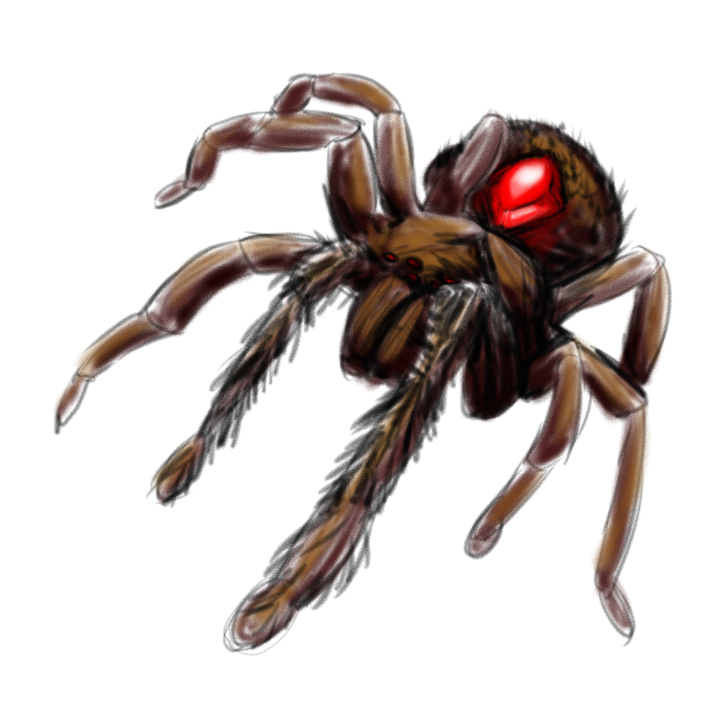 | Deer Spider Location(s): Cetus, darker caves Danger Level: Deadly Diet: Carnivorous Length: 3-4 ft (+ legs) Quirk(s): Enormous, aggressive Deer Spiders are the largest spiders found outside of Hydra, and one of the most deadly. They tend to stick to darker areas, including crevices in Orion, Polaris and darker tunnels, and can be found in large numbers in the Crags of Cetus. Here they usually congregate in groups, which in the Crags can number in the dozens. They spin enormous webs ten or more feet across, and crevices with Deer Spider inhabitants can be tangles of sticky silk. These spiders are highly-aggressive, capable of spitting venom or biting their prey, and will not hesitate to physically attack with their large fangs. More often, however, they will allow prey (which can include creatures the size of large Cave Deer) to tire itself out in their webs before spinning it into a wrapped cocoon. Larger colonies of Deer Spiders often have dozens of these hanging in plain sight, and bones scattered across the ground. Their bristles, unpleasant to touch and capable of getting stuck in skin and working deeper, are usually colored black, but can also be grey or hold iridescent blue shades. Their many eyes are usually red, but the grey spiders sometimes have green eyes and the blue spiders, blue. The venom is a paralytic neurotoxin as well as dissolving the tissues of injected victims, making them easier to consume. Even a baby Deer Spider’s bite can become badly-infected and gangrenous. Despite all of this, if a Deer Spider is slain, their thick limbs and heavy body can provide a hearty, tasty meal. |
 Sand Spider | Location(s): Hydra Danger Level: Dangerous, deadly to smaller creatures Diet: Carnivorous Length: 1-3 ft (+ legs) Quirk(s): Very fast, Hydra-only Sand Spiders are fast-moving, quick-reacting spiders that are usually active during the day. They actively hunt prey, and are aggressive when disturbed at close range, though they will flee enemies approaching from afar. They focus on smaller prey, and their venom--though very painful, and even temporarily debilitating (causing stiffness, infection, swelling, and cramping), is rarely fatal to larger Gembound. At times, the Sand Spider even covers itself in a thin layer of desert sand, ready to spring out at passing Quill Mice or occasionally, Bone Hares. The Sand Spider sometimes falls prey to any of the other predators in Hydra, though it sometimes preys in turn on the scorpions there. Sand Spiders are usually only a foot or so across, perhaps two with their legs included, but they can grow to be larger with age. |
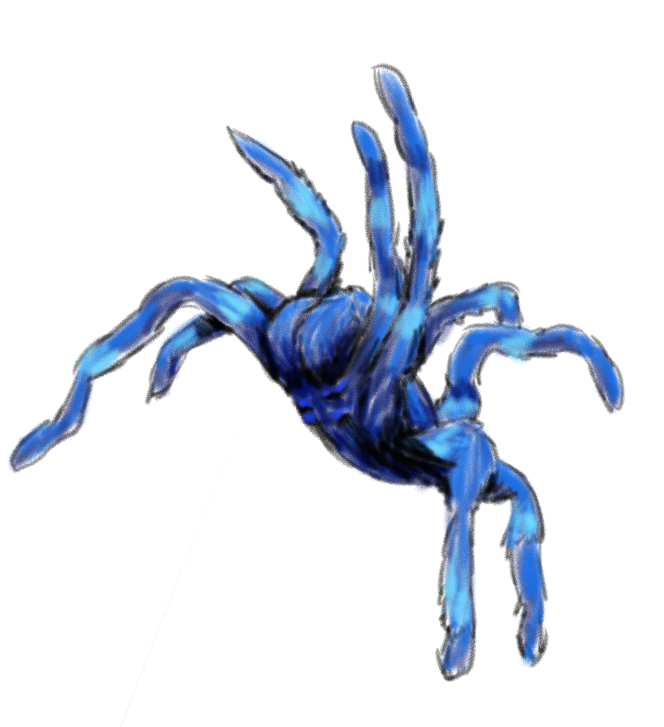 | Spire Spider Location(s): Hydra Danger Level: Deadly Diet: Carnivorous Length: Up to 3 ft (+ legs) Quirk(s): Hypnotic pattern, extremely dangerous venom, magic-siphoners Tending toward the larger side, and dark grey to black in color, the more sinister Spire Spider is named after both the iridescent blue shimmer to its bristles and its affinity to magic. The Spire Spider is mostly found in the Crucible, where it hides itself in the darkness of cracks and niches during the day. Nocturnal, it emerges at night to hunt, seeking out living prey and, whenever possible, sources of magicka. Upon finding prey, it lifts its abdomen to display the pattern there, which glows and shimmers and--reinforced by arcane suggestion--hypnotizes its target. Even large creatures fall prey to the Spire Spider; at times, the last thing a Gembound will see is the entrancing play of aqua and cobalt over the bristles, before slipping into a daze. Mercifully, the Spire Spider's bite--though generally extremely painful--is painless to its hypnotized prey, and unconsciousness usually follows within minutes. The target will then remain asleep, the Spire Spider feeding at its leisure--sometimes over days. If the spider is interrupted, and forced to leave its prey, the prey can sometimes awaken--though in pain and greatly weakened. Strangely, even a slight bite from a Spire Spider can drain its target almost entirely of its magicka--seemingly empowering the spider in the process. Even small Spire Spiders can feed on the largest Greater Gembound prey through their feeding habits, and some of the spiders can grow to truly enormous size. |
Cave Bugs
Many insects and related creatures make their home in the caves. They share exoskeletons and many legs, but beyond this they are extremely variable. Many sizes, leg-counts, colors, habits and habitats distinguish the numerous species. Some are poisonous, but others are commonly taken as prey.
Many insects and related creatures make their home in the caves. They share exoskeletons and many legs, but beyond this they are extremely variable. Many sizes, leg-counts, colors, habits and habitats distinguish the numerous species. Some are poisonous, but others are commonly taken as prey.
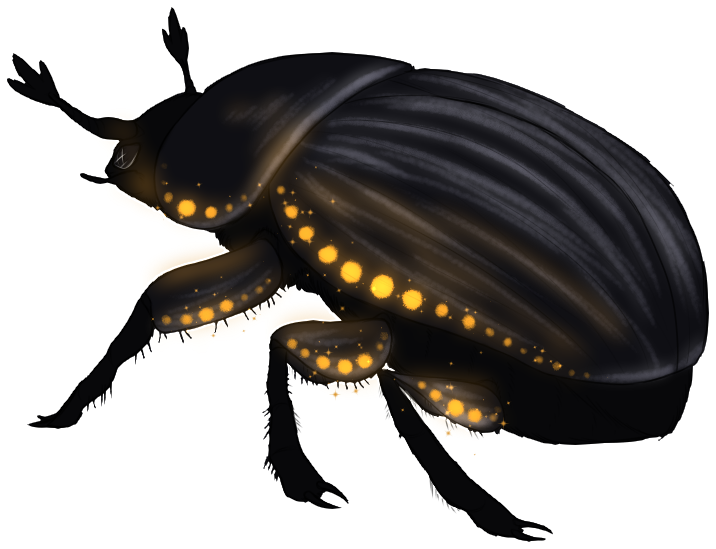 | Death Crawler Location(s): Anywhere with vegetation Danger Level: Potentially deadly Diet: Herbivorous Length: 1-3 inches Quirk(s): Deadly to eat, dangerous to the touch At first glance this beetle might seem unassuming, what with its simple black body. Its glowing orange spots provide a warning, however, of its toxicity: if ingested it will cause violent seizures, foaming at the mouth, necrosis of the organs, and eventual death in even the largest Gembound. Even just touching its slick shell is enough to cause numbness. They generally stick to dark, close spaces such as holes and gaps beneath rocks, avoiding predators where they can, and will usually flee from contact. Otherwise they wander, feeding on foliage or dead vegetation. Their larvae are small, black, hairless worms with likewise glowing orange spots. |
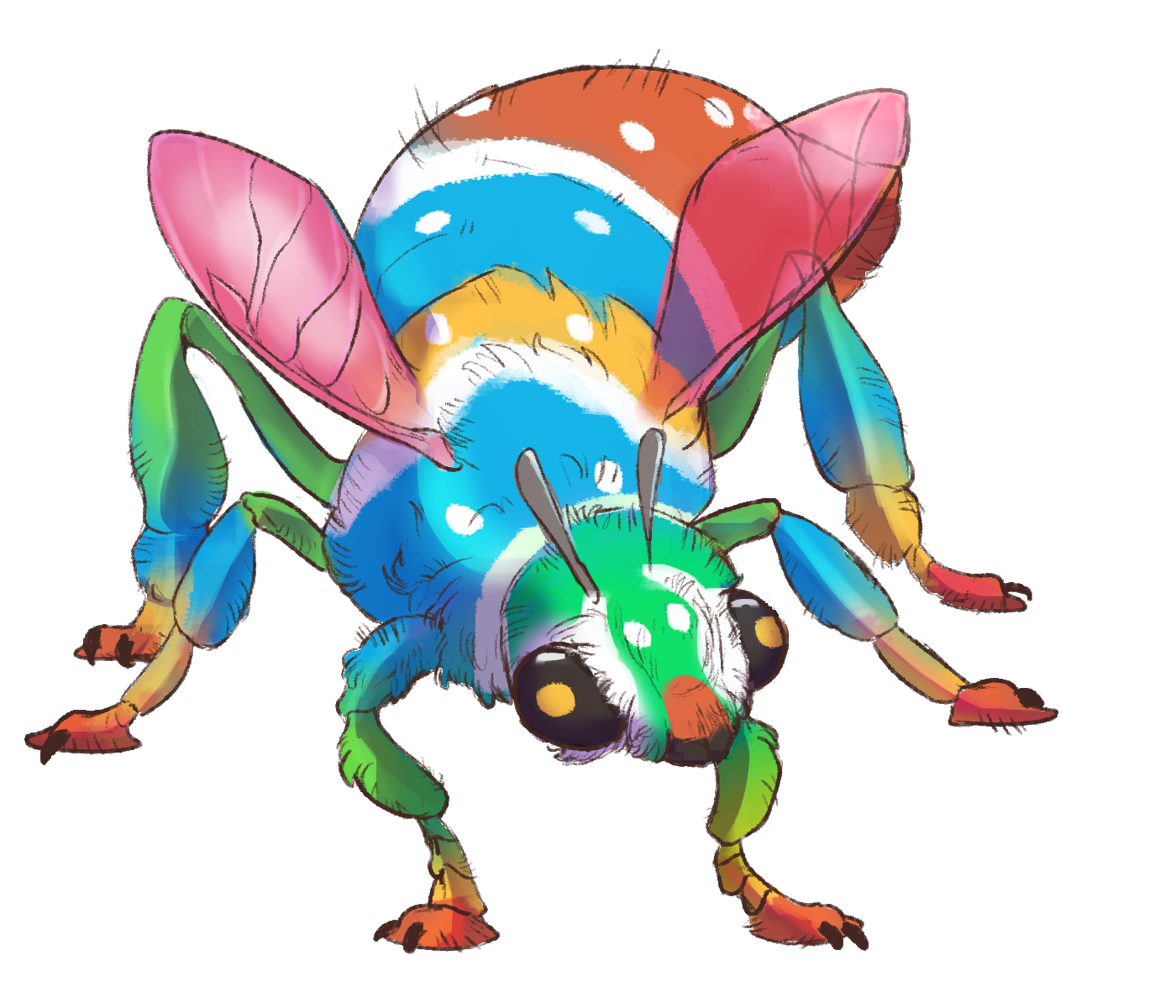 | Rainbow Bumblebug Location(s): Everywhere Danger Level: Mostly Harmless Diet: Nectar Length: 1-2 inches Quirk(s): Very, very silly These are fat little bumblebees that canvass the caves in search of flowers. They nest in hives in any cave with native flowers, and create edible, sweet honey that they store within. This honey can be retrieved and eaten, though the rainbow-hued Bumblebugs will swarm those who attack their hives. Their stings are rather painful and can raise nasty bumps and with enough of them stinging can cause anaphylaxis, though generally they are very docile bugs. Their bodies are very soft and fuzzy, and their many bright colors and seemingly-idiotic flight patterns (bouncing off plants or pausing for a few moments in a confused circle) make them amusing to watch. Bumblebug larvae are fat, seemingly-happy black-spotted white worms with orange-yellow heads, found only in the honeycombs of the hives. |
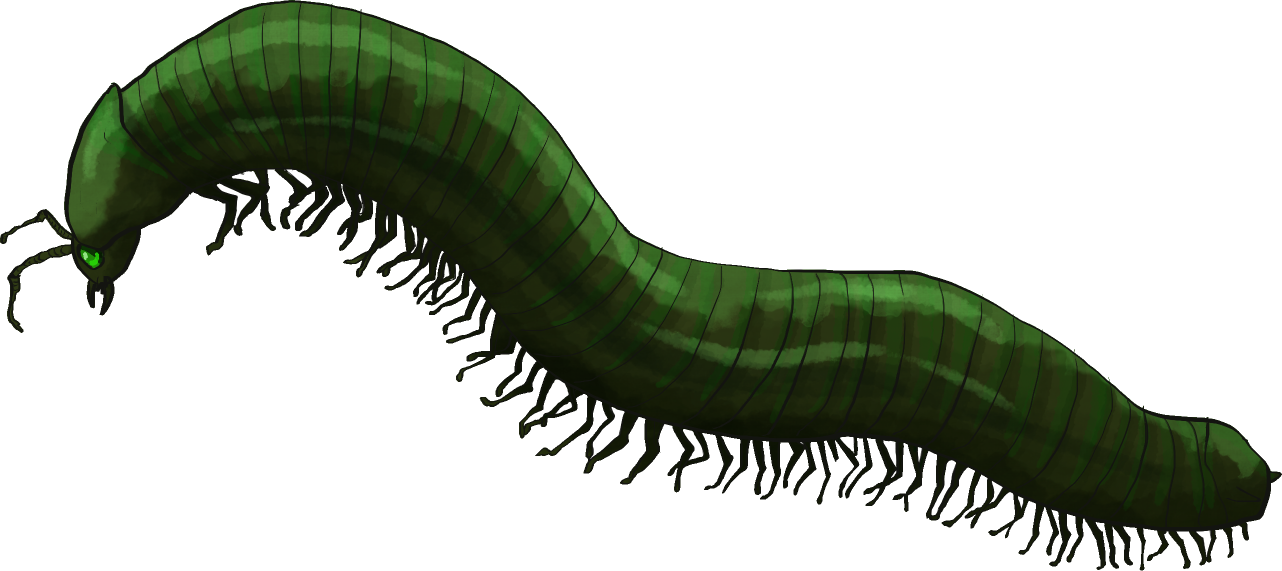 | Green Wallcrawler Location(s): Everywhere Danger Level: Harmless Diet: Minerals Length: 3-4 inches Quirk(s): Mineral-based diet Green Wallcrawlers are millipedes, with thin, tubular, slick bodies made up of hundreds of smooth segments, and dozens of legs beneath. They are usually green in coloration, ranging from the dull yellow-green of spring leaves to bright and shining emerald. They are often found crawling along cave walls, using specialized secretions and jaws to erode tiny amounts of rock to consume. They will also eat any fungus that they find growing along the stone. Sometimes, a Green Wallcrawler can fall off of a wall after it’s eaten its fill and become too heavy, and occasionally they will land on a passing Gembound’s head quite by accident. They are generally very harmless, and quite edible (providing mineral nutrition), but in extremely rare cases they may try and eat an unaware Gembound’s exposed gemstone. |
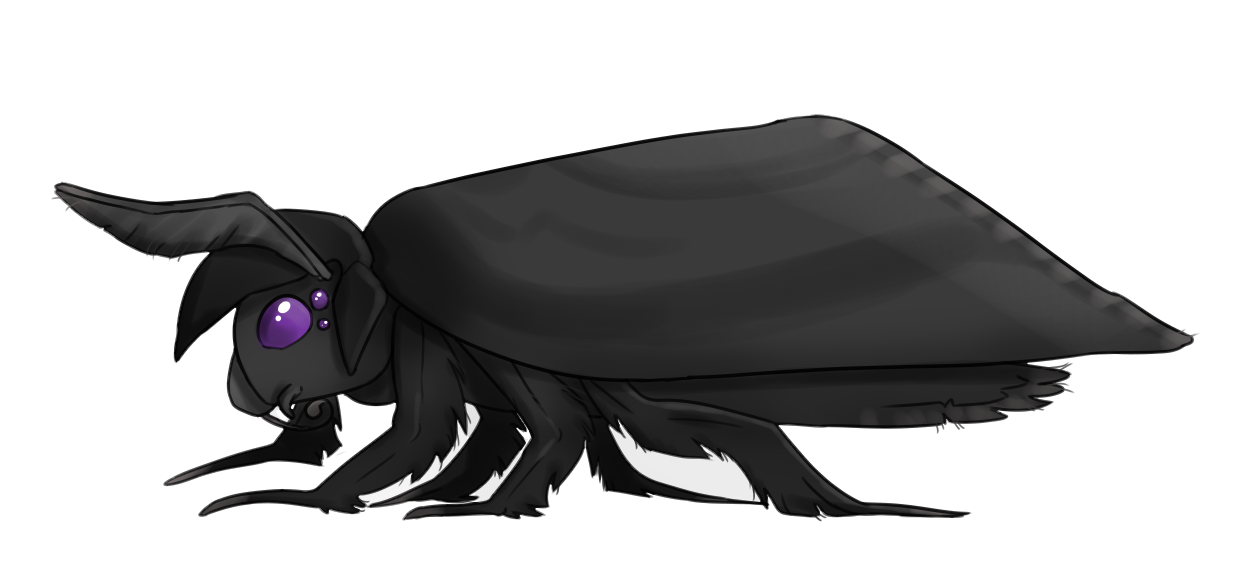 | Deathcloak Moth Location(s): Darker caves and sub-locations Danger Level: Harmless (usually) Diet: Carrion Length: 2-3 inches Quirk(s): Hooded appearance, drawn to carrion, can become Oily The Deathcloak Moth is a simple, fuzzy black moth with a shroud-like protrusion over its head. Unlike other moths they are drawn to carrion, their presence often an ominous sign if they arrive a little early (for example, drawn by the odor of advanced illness). Being a carrion feeder, the Deathcloak sometimes arrives when its food source is already dissolving into black goop. They will readily consume this, too, but Deathcloaks whose diets contain more goop than others tend to become oily themselves, with time, behaving more erratically and becoming far more dangerous to eat. These oily moths (usually either much older, or having fed on a great deal of the goop) can cause oil-corruption in their predators, though it is usually not significant unless the predator consumes a large number. Their caterpillars are a hairless black, small and slender, sometimes with paler, thin vertical stripes. |
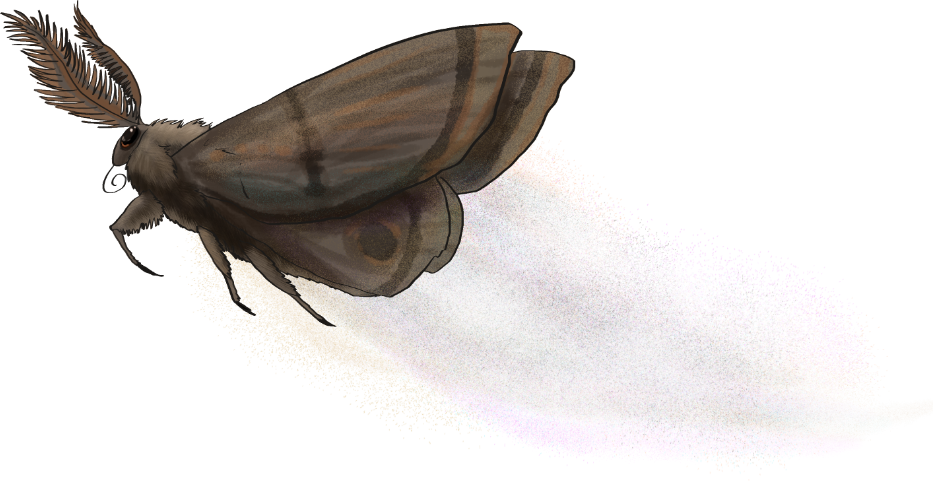 | Dust Moth Location(s): Everywhere Danger Level: Hallucinogenic if consumed Diet: Nectar Length: 1-2 inches Quirk(s): Hallucinogenic A plain brown moth, unassuming to look at, but with iridescent dust that shimmers behind it as it flies. If inhaled, or if the moth is consumed, vivid hallucinations can occur. These are not dangerous on their own, though they can of course prompt dangerous behavior if the victim loses track of reality and, for example, falls or drowns. This is their only defense, though it seems to keep most predators at bay as the Dust Moth makes its way between pollinating flowers. They also have enormous, feathery brown antennae, another quarter or even third their body length in addition. Dust Moths are very very soft! Their caterpillars are likewise a soft and fuzzy brown. |
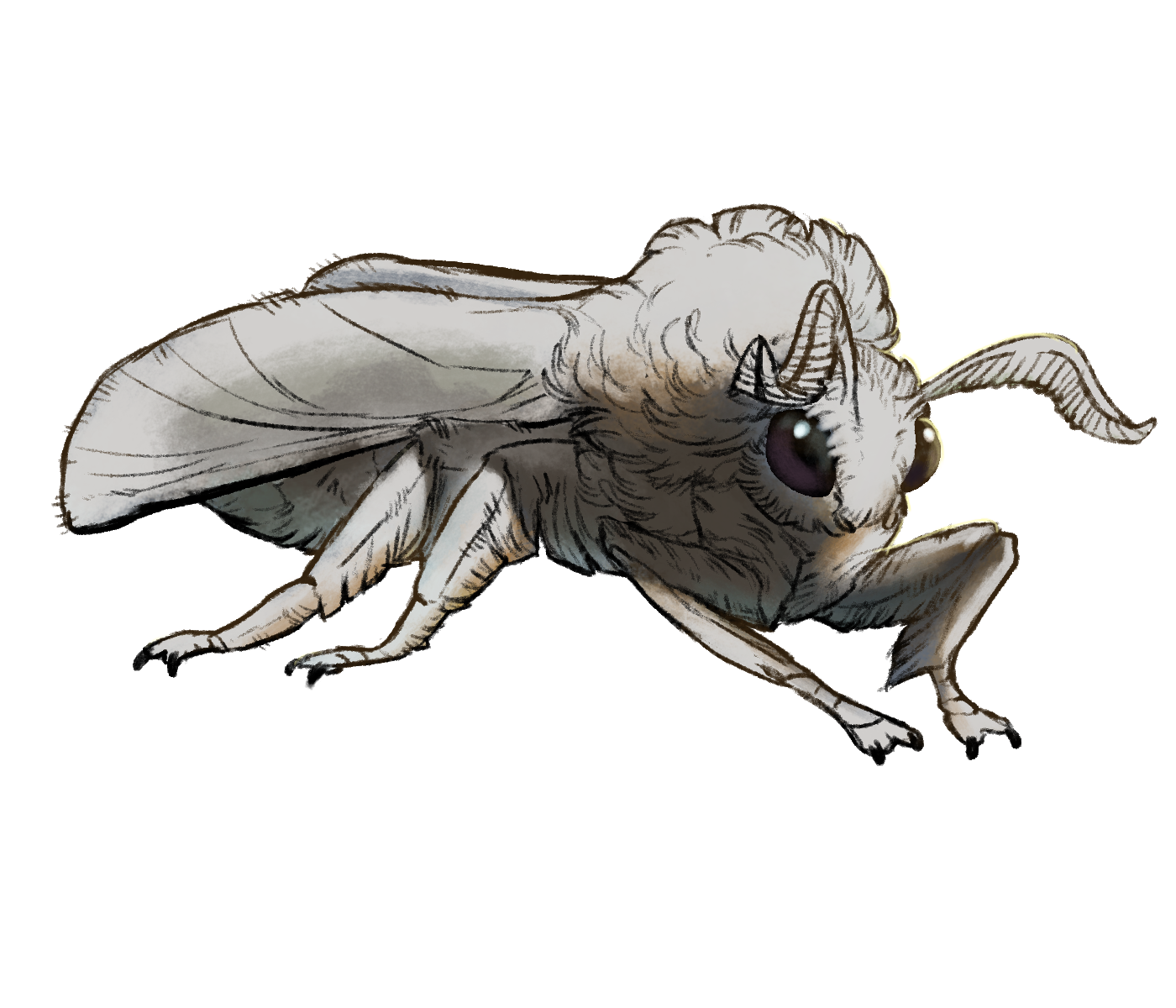 | Bone Moth Location(s): Primarily Canis, occasionally other dry, bright caves Danger Level: Harmless Diet: Omnivorous Length: 1-2 inches Quirk(s): White, unusual diet Bone Moths are white, from pristine snowy white to a creamy off-white ivory. These fuzzy little moths can be found primarily all over Canis. They are mostly herbivorous, feeding mainly on fungus and sometimes, nectar, though they can and do eat fur, fabric and even old crumbled bones. They are shy and delicate creatures, and will not attempt to consume living beings. Their caterpillars are a soft and fuzzy white. |
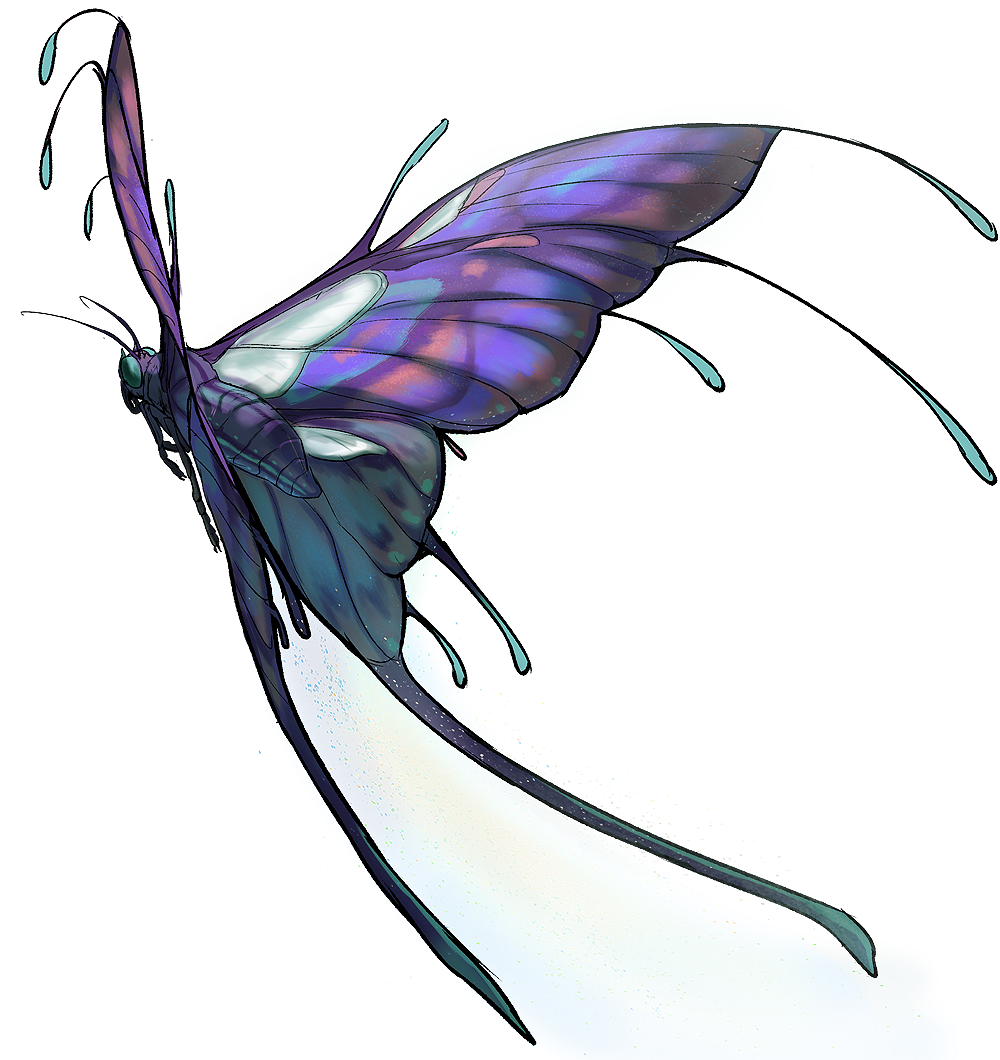 | Fairyfly Location(s): Mostly Eridanus, but lesser numbers elsewhere Danger Level: Harmless, hallucinogenic Diet: Nectar Length: 4-6 inches Quirk(s): Rainbow-hued, ornate wings Fairyflies are gossamer butterflies with long, swallowtailed wings. They are very brightly-colored, in hues of pinks, purples and blues (usually all on the same insect), sometimes with patches of translucent wing-membrane. They are large and shimmering, and they may be distantly related to the Dust Moth: their iridescent dust, though far more colorful, is likewise hallucinogenic if inhaled or consumed. Their caterpillars are fuzzy gray with a faintly lavender hue, sometimes with thin stripes of purple or blue. |
 | Greenwing Location(s): Anywhere with flowers Danger Level: Harmless Diet: Nectar Length: 2 inches Quirk(s): Many, many eyes Greenwings are brilliantly-iridescent emerald-green butterflies. They are smaller than Fairyflies, and faster, often outcompeting them to nectar sources and generally performing better at blending in against green foliage. They have no other defense other than fleeing and camouflage, and as such are harmless and a decent food source for smaller Gembound, both Lesser and Greater. They are, however, fairly good at avoiding predators: multiple eyes stare out from along their back, from head to thorax, giving their bodies the appearance of having honeycombed, reflective surfaces. Their bodies are otherwise black, and their caterpillars are a very fuzzy black as well. |
 | Kiss of Death Location(s): Anywhere with flowers Danger Level: Deadly Diet: Nectar Length: 3-4 inches Quirk(s): Neurotoxic if consumed, with warning colors These are jet-black butterflies with sparing, bright markings in red, orange or yellow. They are medium-large, as far as Origin's butterflies go, and their flight is adorably clumsy and bumbling. They often bounce off plants and flowers en route to finding food sources. Though found anywhere with flowers, they are not found anywhere in great numbers; they are one of the more uncommon Lessers in the cave. They are rarely preyed upon, despite their slow, erratic flight, as they are extremely toxic: eating a single Kiss of Death butterfly can be fatal. Their toxin results in seizures, foaming at the mouth, coma, and possibly even death; the neurotoxin can kill even the largest Gembound fairly quickly. Often, a predatory Lesser will die within a minute, with larger Gembound returning to their chrysalis or outright dying within twenty. Their caterpillars are fuzzy black, and almost as toxic as the adults--which may provide the caterpillars of the Greenwing species some parallel protection, as predators quickly learn to avoid fuzzy black caterpillars. |
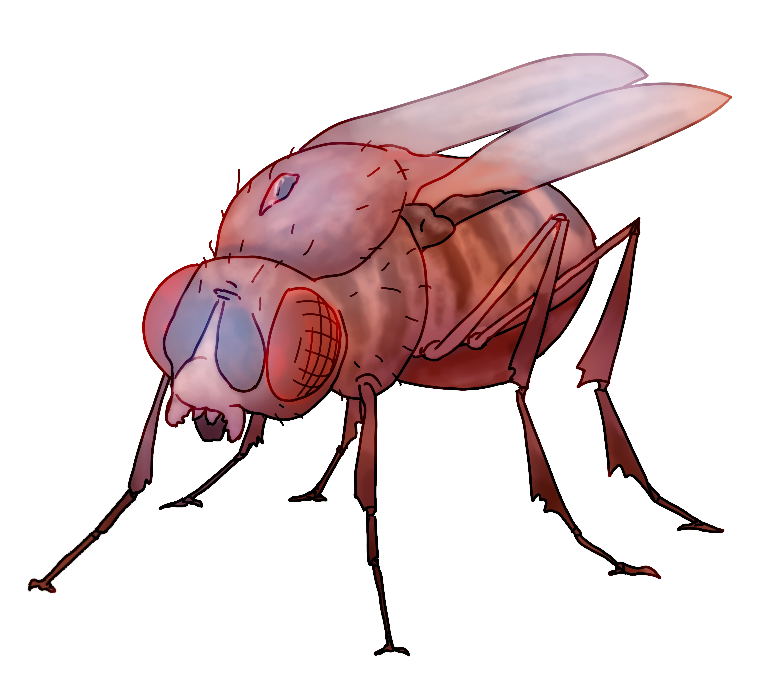 | Ruby Biter Location(s): Anywhere Danger Level: Parasitic Diet: Blood Length: Tiny, mite-sized Quirk(s): Bright-red color, blood-drinker Ruby Biters, or Bloodflies as they're sometimes known, are bright, gleaming-red little flies. They're mostly harmless, not known to carry disease and with their bites hardly itching at all. In swarms, however, they can prove irritating. Generally, these tiny flies--sometimes so small that they're hard to see with the naked eye--attach to a target and drink for perhaps two or three minutes, until full. They have small, sharp proboscises that can pierce even thick hide, though they can and will burrow into the skin of Gembound with carapaces or armored skin in order to find a vein. When they've finished feeding, they will usually then seek out an area of dead leaf litter to lay eggs or shed gemstone for reproduction. Their larvae are tiny white threads, barely-visible little worms. |
 | Blackfly Location(s): Anywhere Danger Level: Annoying Diet: Omnivorous Length: Horsefly-sized Quirk(s): Iridescent black, fly in huge swarms The Blackfly is a relatively small buzzing fly, a black color with an iridescent green, blue or violet sheen and four translucent black wings. Nobody knows how the Blackfly communicates. Perhaps they don't, and their senses are simply phenomenal: but often, minutes after the appearance of the first few flies, the area will be saturated by a cloud of them. They feed on almost anything: dead plant matter, carrion, fruit, fungus and more. They sometimes bite living Gembound, though these bites are mostly harmless, and they do not seem to have a swarming behavior for attacking targets. However, swarms covering a Gembound to ex. drink sweat or the like can be very irritating. Their larvae are maggots, matte black, about half an inch long. |
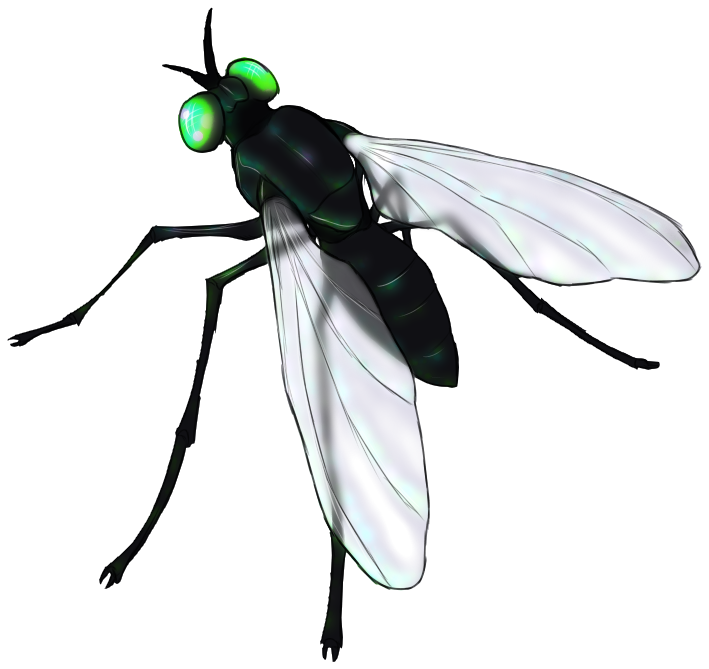 | River Fly Location(s): Water Sources Danger Level: Harmless Diet: Herbivorous Length: Very Small, 1/4-1/2 inch Quirk(s): Always found near water, beautiful viewed up close River Flies are small flies that swarm in small groups around water sources, often at dusk, and serve as prey for both fish and Water Strider spiders. Despite their names, they are found more often around still water sources, and fill Cetus in great numbers, but can be found near rivers, too. They eat plant matter, usually landing to feed on water plants that protrude from the surface. If viewed up close, these flies are actually quite beautiful: faintly iridescent, with transparent wings and slender black bodies. The larval stage of the River Fly is aquatic: small, black-grey worms that swim in slow, inching movements through the water, feeding on aquatic plants. They provide a strong, numerous food source for smaller carnivorous fish. |
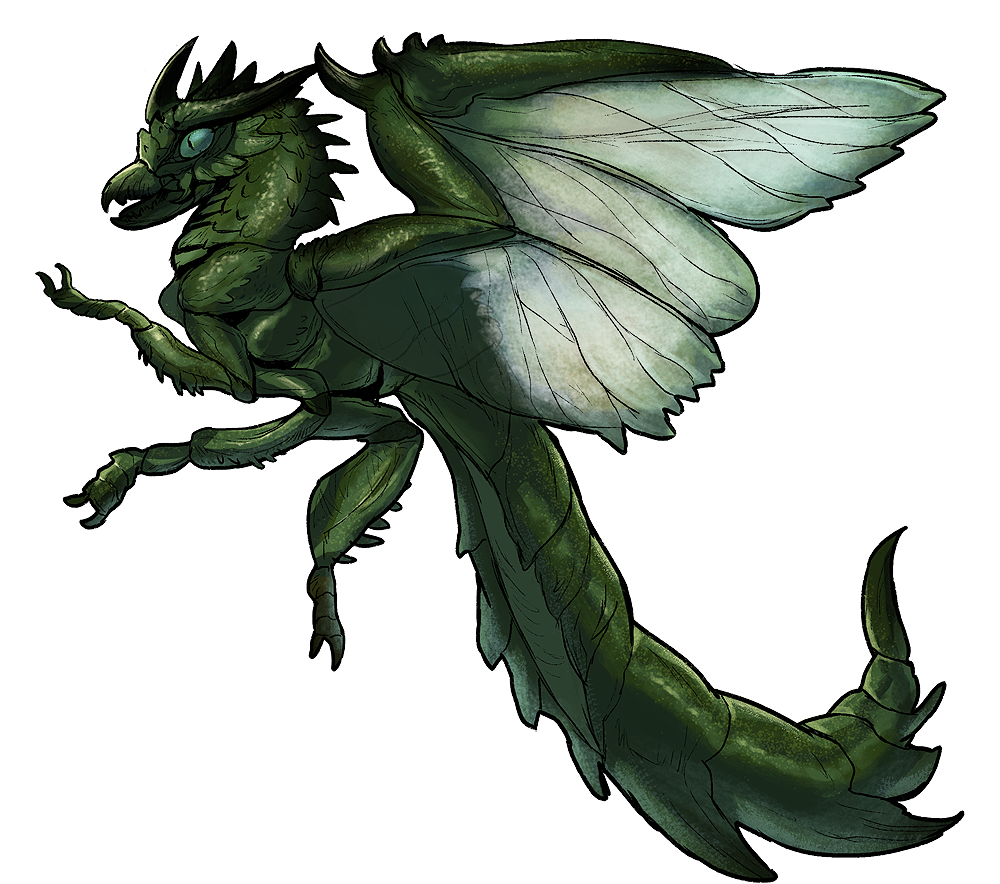 | Dragonfly Location(s): Warm locations Danger Level: Harmless Diet: Carnivorous Length: 1-4 inches long Quirk(s): Reptilian in appearance, can be predatory Emerald green, scaled and reptilian in appearance, Dragonflies a strong affinity for hot, dry locations and a great tolerance for even flame-hot heat (though they are not immune to direct fire). Their wings are more batlike than insectoid in shape, green or transparent in color, and they bear two large, green eyes with horizontal black pupils atop long heads. Their mandibles pinch up and down, rather than side-to-side. They are carrion eaters, though some are large enough to feed on sick or injured mice. Dragonflies are unusual in that they continue to grow even after emerging as adults; their adult phase is only an inch long, but they can grow to four, or rarely, even longer. Their larvae are tiny and bright green, and are usually hatched near a carrion source. |
 | Shifting Mantis Location(s): Everywhere Danger Level: Harmless Diet: Carnivorous Length: 1-7 inches long Quirk(s): Extremely variable, difficult to categorize Shifting Mantises defy categorization. They seem to belong to dozens or even hundreds of species, but in reality each individual is inexplicably entirely unique. They seem to take some features from where they are born, their color, size and shape adapting to survival there, but other features seem to be completely random. Sometimes they are passed on to their young, and sometimes they are not. As a result they come in a huge variety of colors, patterns, and shapes, often imitating Origin's plant life to some extent: many individuals appear, at first glance, to be leaves, flowers, or twigs, or even gemstones and rock. They are also highly-variable in size, some an inch long, others seven inches from head to tail. They are all long-bodied, with six legs, the front two of which are large, grasping pincers; their heads have either two large eyes, or a third in the forehead's center. They have no larval stage. |
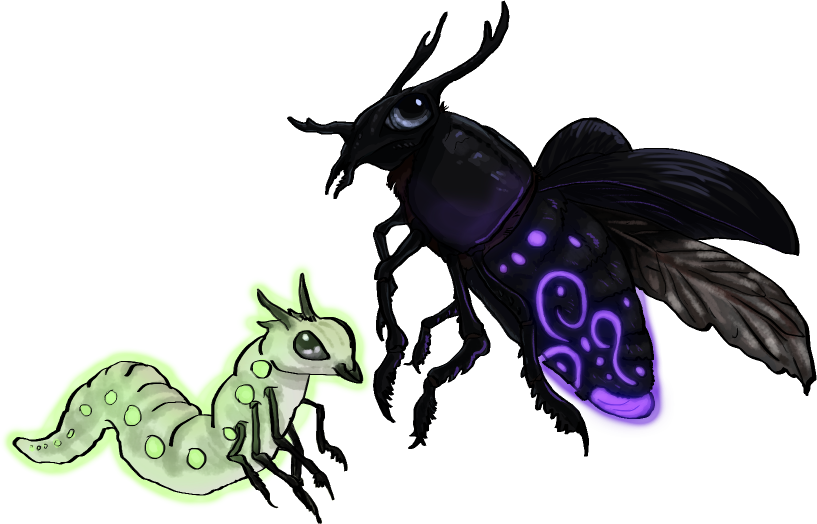 | Glowfly Location(s): Everywhere Danger Level: Harmless Diet: Herbivorous Length:1-2 Inches Long Quirk(s): Bioluminescent A black insect perhaps an inch or two long, with highly-elaborate, often patterned translucency on their abdomens that lets their bioluminescent light shine through. Some have abdomens with tips that glow, along with the detailed patterns higher up. Their glow can be any color, though swarms usually share one hue, and often it closely matches their home cave. These bugs eat leaves, primarily, and are harmless, though they do taste rather foul. Their larvae are Glowworms, which have a soft, permanent glow the same hue as their adult light; these often take shelter up along cave walls, providing a soft glow in shadowed regions. Glowworms eat decaying plant matter, and after heavy rains, the forest floors often feature a great number of their illuminating bodies as they feed on the rotten leaves. |
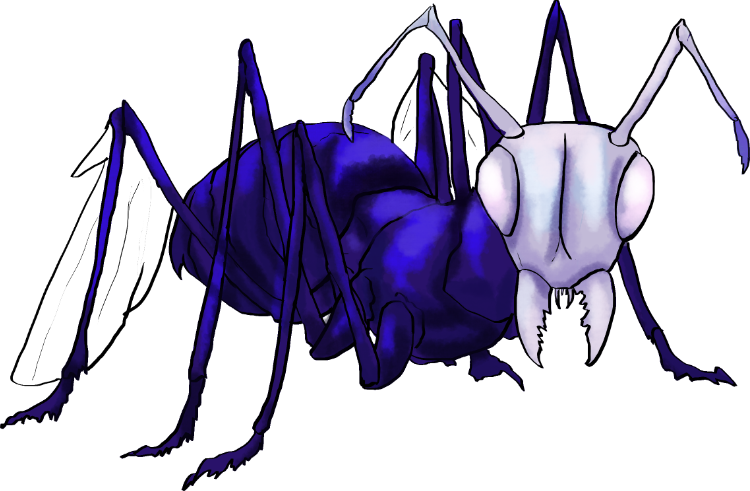 | Wind Ant Location(s): Throughout the caves Danger Level: Harmless individually, dangerous in swarms Diet: Omnivorous Height: Max 1/2 inch Quirk(s): Able to drift on the wind, attracted to sweet things The Wind Ants are typically dark blue to purple with pale heads. They often live near sweet food sources such as nectar and fruits, and after gorging themselves shift to a bright, vibrant hue. They return these sugars to the nest, producing a honey that varies in color by food source. The nests are often located within trees, and wet sugar is allowed to harden both as a candy-like food source, and a protective shell gluing leaves around the nest. Wind Ants sometimes travel from the nest by extending their second pair of limbs, with small sailing wings, and drifting down to the ground. They are tasty to eat, though their bites can be painful. |
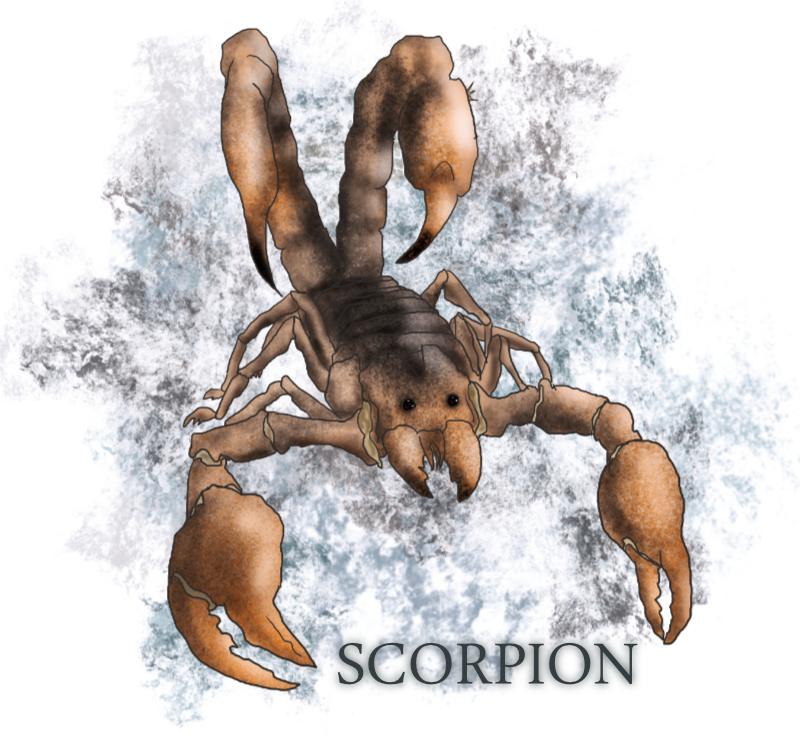 | Cave Scorpion Location(s): Hydra Danger Level: Deadly Diet: Carnivorous Length: 3 feet at maximum Quirk(s): Variable appearance, deadly venom Cave Scorpions are highly-venomous predators. They primarily hunt down and feed on Quill Mice, young Bone Hares, and Sand Spiders, taking unaware Spire Spiders where they find them. Scorpions are one of the only creatures that an Eyehook Vulture will generally avoid. Cave Scorpions have hard exoskeletons in shades of tawny, buff, grey and, rarely, black. They range in size from only a few inches long to nearly three feet long, and at this size--though rare--they can prey upon cave deer and even hold their own against smaller Sandworm attacks. The venom of the Cave Scorpion, injected by the tail tip, causes first sharp pain, then numbness, leading quickly to paralysis that spreads from the affected site. Gembound of the Scorpion’s size or smaller will be fully paralyzed, though those double or larger its size may only find the afflicted area stunned. If the victim survives, extreme pain, cramping and necrosis at the bite site can follow. Approximately one third of Hydra's scorpions have two tails; in extremely rare cases, a scorpion may have three. Scorpions are aggressive hunters and aggressive attackers, fearlessly going after anything that draws too close. If killed, however, their meat is nutritious, if a little bland--though eating the tail’s foul-tasting venom sac can prove deadly. |
 | Oily Bumblebug Location(s): Polaris, Draco, and Tunnel K Danger Level: Varies Diet: Oil, Nectar Length: 1-2 inches Quirk(s): Technically corrupted The Oily Bumblebug are of a similar size, shape, and social structure to their Rainbow cousins, but with a wildly different range and diet. Due to the Oil that they take in and process into thick, purple-black honey with nectar, they are slicked over with an iridescent sheen and constantly slippery. Those that consume their honey report a surprisingly pleasant—if acidic—flavor reminiscent of a lime before the corruption sets in. Due to workers being fissioned from a single queen, they are fiercely territorial. They will sting their aggressors relentlessly to dispense their otherwise mild toxin. They are only found near massive concentrations of magic—beneath the Spire, around the Black Spire, and the Hole in Tunnel K. |
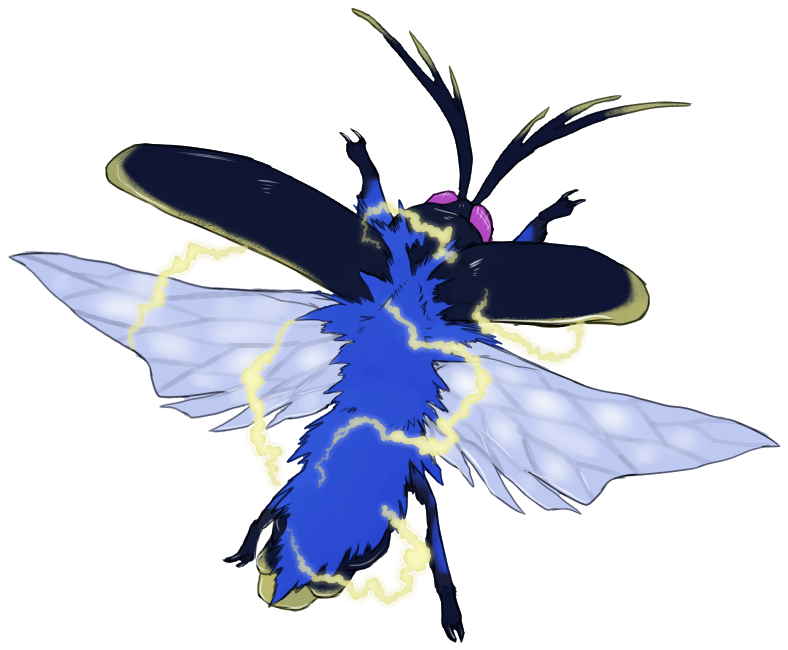 | Sparkbug Location(s): Everywhere Danger Level: Harmless Diet: Herbivorous Length: 3-4 inches Quirk(s): Fun to eat, sparks Somewhat akin to Glowflies, these beetles are covered thorax to abdomen in cobalt-blue hairs. They fly and eat like hummingbirds—with nonstop, rapid movements of the wings as they move from plant to plant to nibble on their leaves. The constant motion of their wings brushes against their hairy coverings and generates static electricity. Some gather up such an intense charge that small bolts of lightning jump across themselves or to nearby Sparkbugs. While the hardness of their carapaces might dissuade some Gembound, many find it fun to catch Sparkbugs in their mouths and get zapped by their built-up static and strangely rubbery insides. |
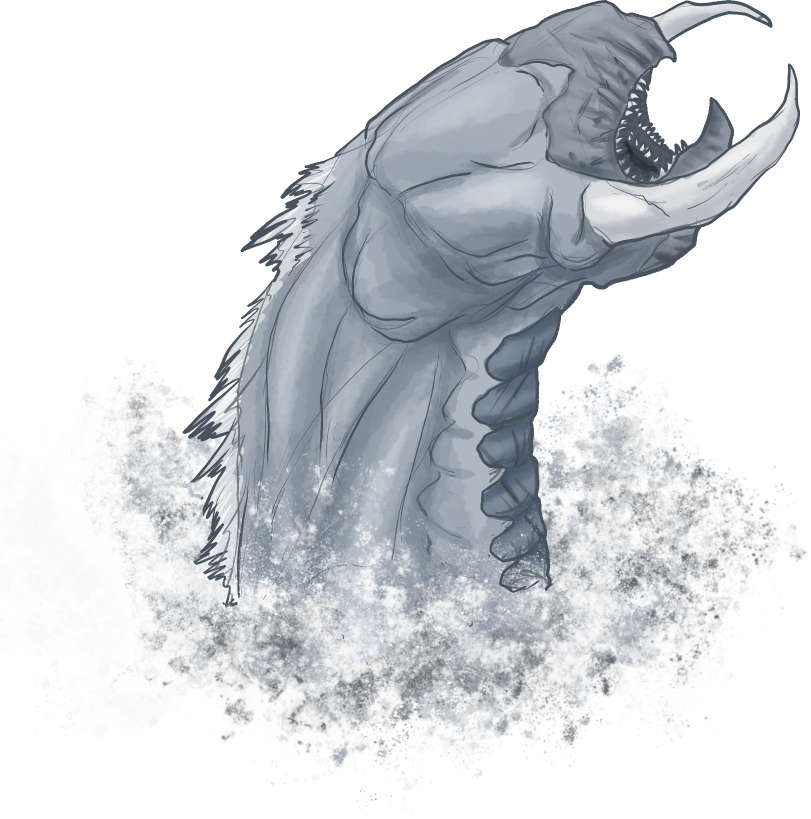 | Ice Worm Location(s): Ursa Danger Level: Deadly Diet: Carnivorous Length: Up to 15 ft, usually 6-12 Quirk(s): Lurks beneath the snow, blind, hunts via vibrations, rare The Ursa equivalent to Hydra's Sand Worms, the Ice Worm is a very rare creature. As with Icebeasts, only a few live at full-size (some fifteen feet long) at any given time; most kill one another off or starve before they grow so large. Like Sand Worms, they're carnivorous, exoskeletoned worm-like creatures living beneath the snow, tunneling and lying in wait there; generally they remain totally still, sometimes for many cycles, awaiting the vibration of passing prey. Then their bodies shove upward, toppling prey or snagging it in their lamprey-like maw or with powerful pincers to drag them down. Ice Worms are pale, usually whites, grays and light icy blues, and their calcified carapaces are more thickly-covered in bristles than their hot-weather relatives. Given their burrowing habits, Ice Worms are restricted to the deepest snow around the mountains' base and around the lake; an occasional stray can also be found utilizing the glacier tunnels as a burrow. |
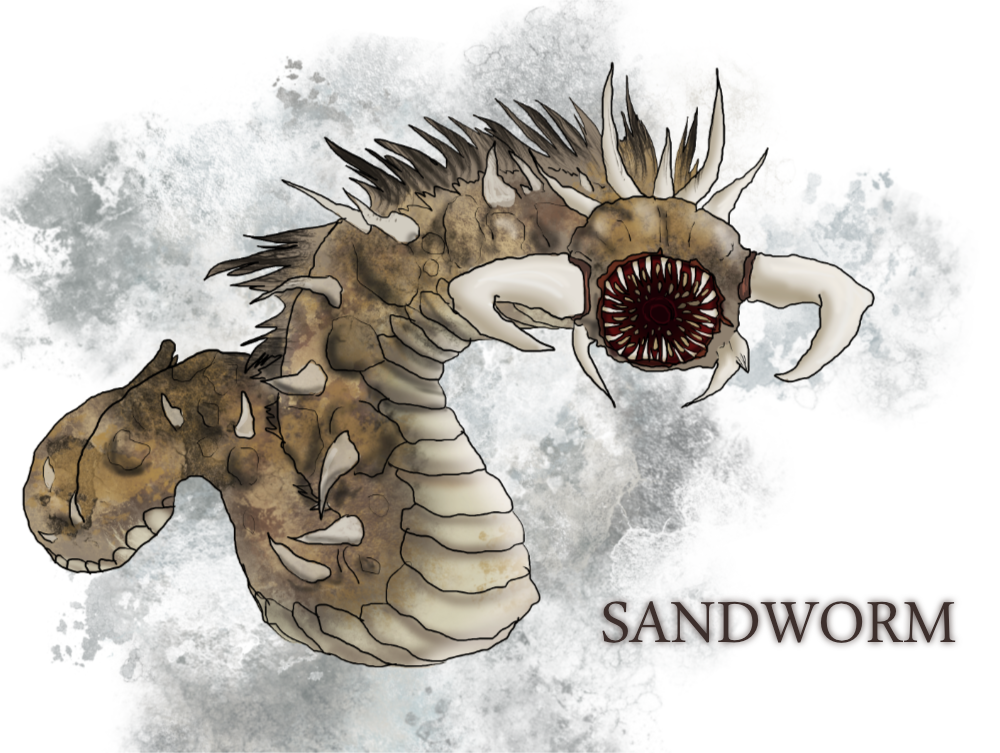 | Sand Worm Location(s): Hydra Danger Level: Deadly Diet: Carnivorous Length: Enormous, variable Quirk(s): Lurks beneath the sand, blind, hunts via vibrations Sand Worms, or or Sandworms, are massive, carnivorous Lesser Gembound that live beneath Hydra's Dunes region. They burrow there beneath the soft substrate, and lie in wait, sometimes quite deep and still. Though blind, they can easily sense the slightest vibration from the surface above: even a Quill Mouse gently pattering over the grains will have them lunging up from beneath and sucking the prey down into their maw. Even the displacement of sand as they move is enough to topple deer down into their grasp. The Sand Worm is slow-growing, but can theoretically become infinitely large. In reality, most of them prey upon one another--a very large worm is slow, and is often devoured by those smaller. Smaller Sandworms, too, who venture to the surface sometimes fall prey to the other carnivores of the cave. The largest Sandworms tend to be ten to twenty feet long, though it's always possible that a truly massive behemoth lurks in hiding somewhere within the cave. Sand Worms are covered in hard, sandy-colored plates and scales, and with stiff bristles running down their spine. Bony protrusions erupt haphazardly from their thick hide: these are calcifications, as the Sand Worm turns the calcium from the bones and carapaces of its prey into spikes. Therefore, the more spikes an individual Sand Worm has, the more prey it has killed and consumed. Rows of lamprey-like teeth point inward down the throat. Two massive mandibles grip larger prey, like pincers, pressing in and often breaking bone as the creature drags this prey down into the sand to suffocate. The mandibles and mouth double as a burrowing device: the Sand Worm spends most of its life entirely beneath the surface, passing massive swathes of dirt and sand through its body as it tunnels. A Sand Worm can lie dormant for years, only coming active to eat--and can survive without food for decades. |
 | Cleaner Location(s): Ursa Danger Level: Dangerous Diet: Omnivorous Length: 7 feet Quirk(s): Compulsively order anything messy The workers of the Ursa Hive, these massive ant-like creatures are uniformly pale, with soft, bristly thoraxes and glassy abdomens webbed with white. Though elusive, they can occasionally be found outside the nest's ice tunnel warrens, foraging for food; the rest of the time they spend maintaining the tunnels, caring for their Queen Mother, and raising larvae. Six legs, six eyes and four antennae are situated in a perfectly symmetrical fashion, and any irregular larvae are quickly culled in the nest. Cleaners will attempt to reshape any non-symmetrical living things they aren't actively hunting, using jaws and pincers; this can be fatal to the target. Cleaners secrete a clear substance, which hardens into ice-like amber, to aid in repairing and shaping the ice tunnels. These workers are four feet tall when fully upright, and seven long. |
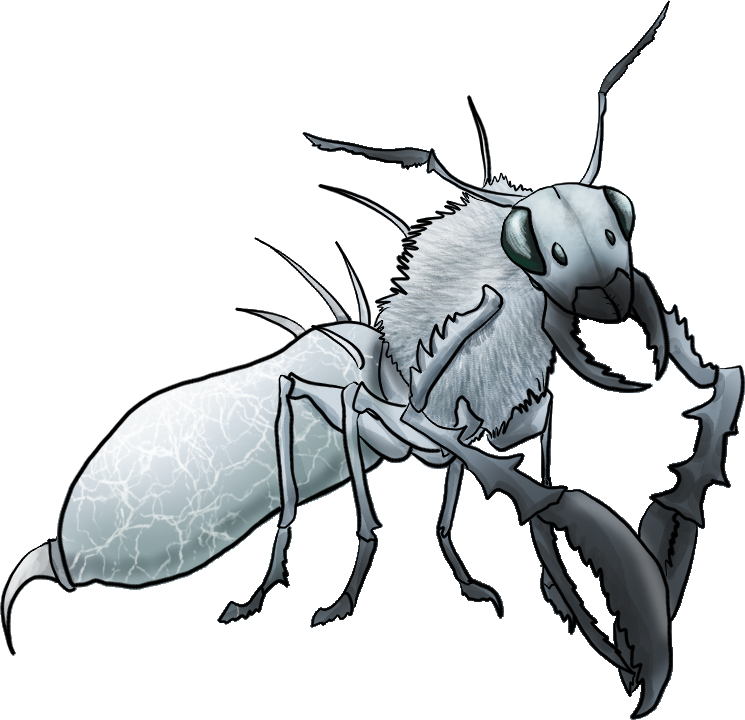 | Praetor Location(s): Ursa Danger Level: Lethal Diet: Omnivorous Length: 12 feet Quirk(s): Venom crystallizes targets, preventing a return to chrysalis The soldiers of the Ursa Hive, these creatures are even more scarce than Workers--making up only a quarter of the Hive--but incredibly dangerous. Found in matched pairs guarding the inner tunnels, they have larger, mantis-like forelimbs and immense and crushing jaws. The Praetor gives off an acrid stench that invokes a feeling of possibly irrational fear in those who smell it; those who ignore it and move forward to encounter the Praetor will generally be attacked and pursued. The Praetor is programmed to not allow witnesses to escape. A venom found in both jaws and hooked stinger rapidly crystallizes the target, preventing its victim from returning to the chrysalis while simultaneously turning their body into an ice-like crystal. Ominous 'statues' found throughout Ursa's ice tunnels are actually the past victims of Praetor defenses. |
Lacerta Lessers
Lacerta is a large volcanic island in Fornax shrouded in thick fog. Designed to be a working ecosystem in macro form, many of these Lessers are absolute behemoths in comparison with those in the rest of the caves. While there are smaller, speedier exceptions, many of Lacerta's Lesser Gembound are a challenge to tackle and a triumph to overcome. Various forms of toxins are often found among them, along with loud calls and bioluminescence for communication in thick jungle. Lacerta's creatures are mostly adapted for hot, humid temperatures, and may not do well if taken to cooler, drier caves.
Lacerta is a large volcanic island in Fornax shrouded in thick fog. Designed to be a working ecosystem in macro form, many of these Lessers are absolute behemoths in comparison with those in the rest of the caves. While there are smaller, speedier exceptions, many of Lacerta's Lesser Gembound are a challenge to tackle and a triumph to overcome. Various forms of toxins are often found among them, along with loud calls and bioluminescence for communication in thick jungle. Lacerta's creatures are mostly adapted for hot, humid temperatures, and may not do well if taken to cooler, drier caves.
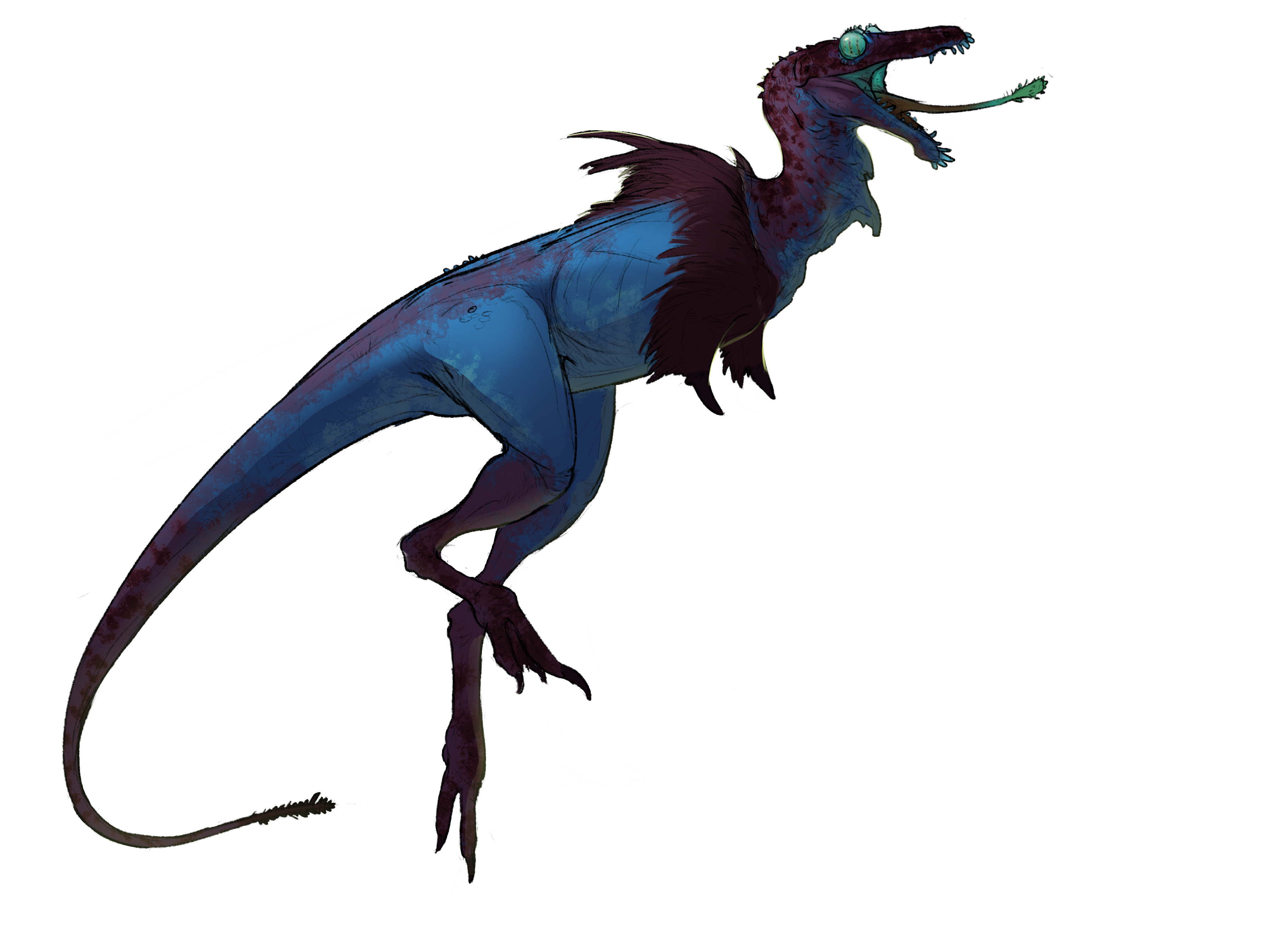 | Skrungler Location(s): Lacerta (Fornax) Danger Level: Dangerous in groups and to weakened Gembound Diet: Carnivorous: Carrion, Weakened Prey Height: ~ 2-3 ft Quirk(s): Bioluminescent, venomous Skrunglers are the cave rats of Lacerta. Quick, cowardly and cautious, they're generally more of an irritation than anything, usually found prowling for (and snacking on) carrion before it dissolves to Oil, along with mice, insects, and other tiny prey. However, they do have a mildly venomous bite that can instill hallucinations in the unwary, and when confronting a sickened or weakened Gembound, their cowardice can be overcome by savage predatory behavior. In these scenarios they will overwhelm a target with darting bites of their venom. They're far more dangerous at night, when their glowing eyes can be seen dashing through the underbrush in large groups: their night vision is excellent, and although healthy prey is still generally avoided, they pose a very real threat to a wounded Gembound caught on Lacerta at night. A rare few Skrunglers come in a deep brown-red, rather than the typical blue. Discovered by Kaimana! |
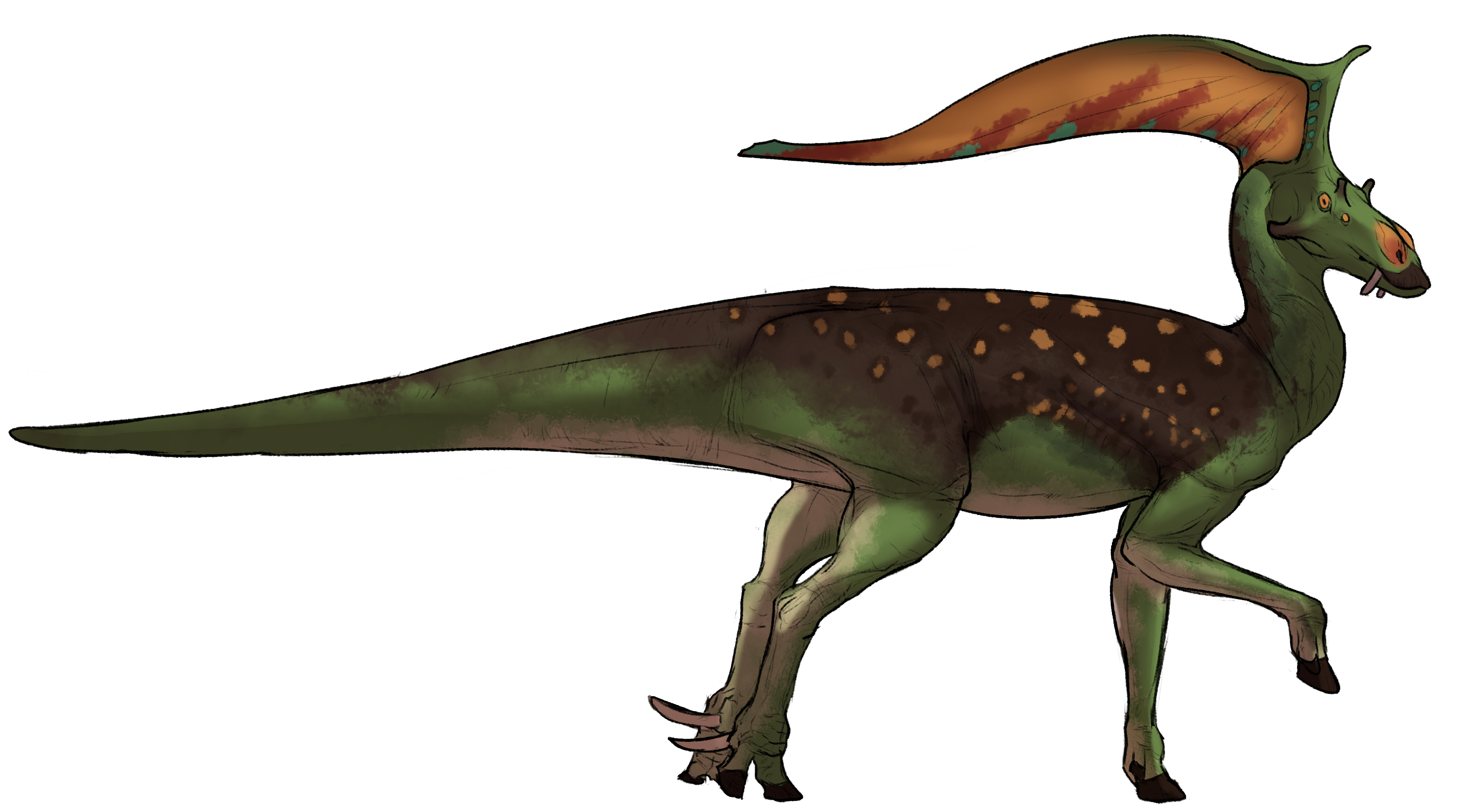 | Sailfin Singer Location(s): Lacerta (Fornax) Danger Level: Harmless, flighty Diet: Herbivorous, prefers fruits Height: ~ 6 ft Quirk(s): Haunting calls Singers--aka Sailfins--are a vague equivalent to Origin's cave deer, but much larger and heavier. They move in small herds, sticking to dense underbrush, and are capable of moving very quietly; their camouflage is excellent, even taking into account the sail atop their heads. But when a group needs to keep contact in the thick brush, their calls can carry quite a distance. These calls are haunting, loud and echoing, and sound like they're made by a far larger animal. Sailfin Singers are very fast, and rely on nimble agility and speed to carry them out of harm's way; they're capable of turning very sharply and accelerating quickly through even the thickest brush to escape predators. Six feet at the shoulder, Singers are about half the size of Pugnas, and during the day, small herds of Singers can converge out on the plains in the company of the far larger Pugnas--grazing alongside them, and using their larger size for protection. Discovered by Relic! |
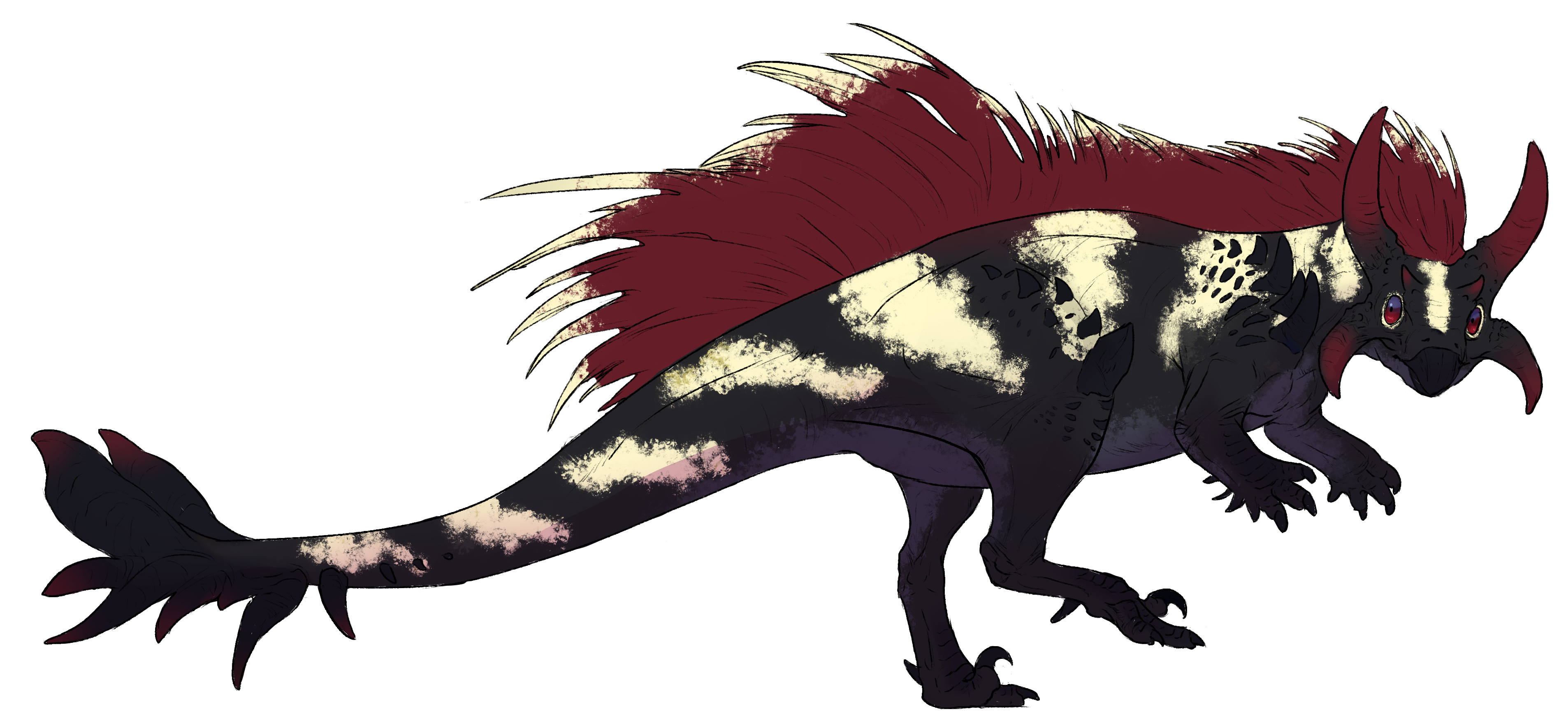 | Devilbeak Location(s): Lacerta (Fornax) Danger Level: Capable Of Self-Defense Diet: Omnivorous Height: ~ 4 ft Quirk(s): Horrible Screams Devilbeaks are smaller Lessers on Lacerta, only around four feet tall, though long-bodied. Despite their size they're not without self-defense: their hide is thick and pebbled, spined in places; a muscular tail bears a heavy, spined club at the tip, and a thick pelt of sharp, irritating, toxic quills covers their backs. The tail can easily break bones, and the quills can dislodge, quickly causing serious damage to the body's blood cells if not removed. That being said, their first instinct is always flight; they are prey creatures, and they know it, and will attempt to flee until cornered. The Devilbeak is quick, somewhat intelligent, and omnivorous; it often is found feeding on fruit, insects or even smaller prey, using claws to tear apart rotten logs or bones in the process. Devilbeaks are social but fairly aggressive, engaging in head-butting competitions for rank where they lock horns and wrestle. Their territorial calls are a horrific, harsh, discordant screech--an absolutely hellish sound that, along with their color and their horns, gives the Devilbeaks their name. Discovered by Madhukar! |
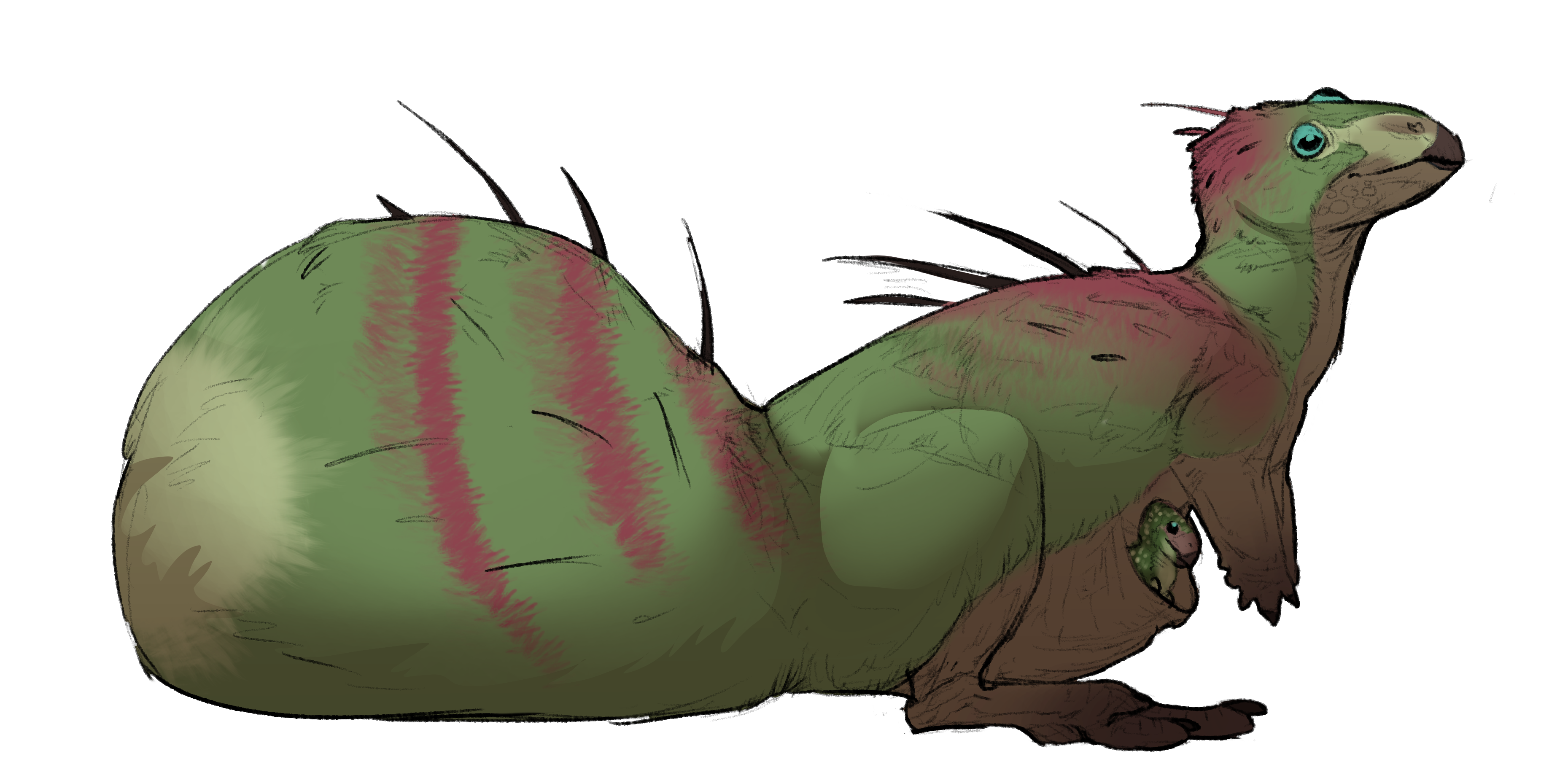 | Prickleback Location(s): Lacerta (Fornax) Danger Level: Mostly Harmless Diet: Omnivorous - plants and insects Height: ~ 3 ft Quirk(s): Squishy, with toxic fur Pricklebacks are one of the more harmless beasts of Lacerta, and probably the only one that could be considered easy prey. Even so, they're incredibly fast, capable of launching themselves almost ten feet straight up with powerful hind legs. They're also somewhat social, living in small groups that tend to linger around the herds of larger animals; they keep wary watch with their three eyes, giving advance warning of danger and in return, gain protection from larger herbivores. Pricklebacks carry their young in pouches, and are coated in warm, thick feathers that camouflage them in Lacerta's underbrush. They tend to be found pecking along the jungle floor to forage on seeds and insects, and their calls consist of soothing chirps and trills. While they're generally flighty, a large number of spines are found along their bodies to deter potential predators, and the fur, if licked or breathed against, is quite toxic, capable of inducing paralysis. Experienced predators know to get rid of the spikes and fur before trying to eat a Prickleback. Discovered by Nidhogg! |
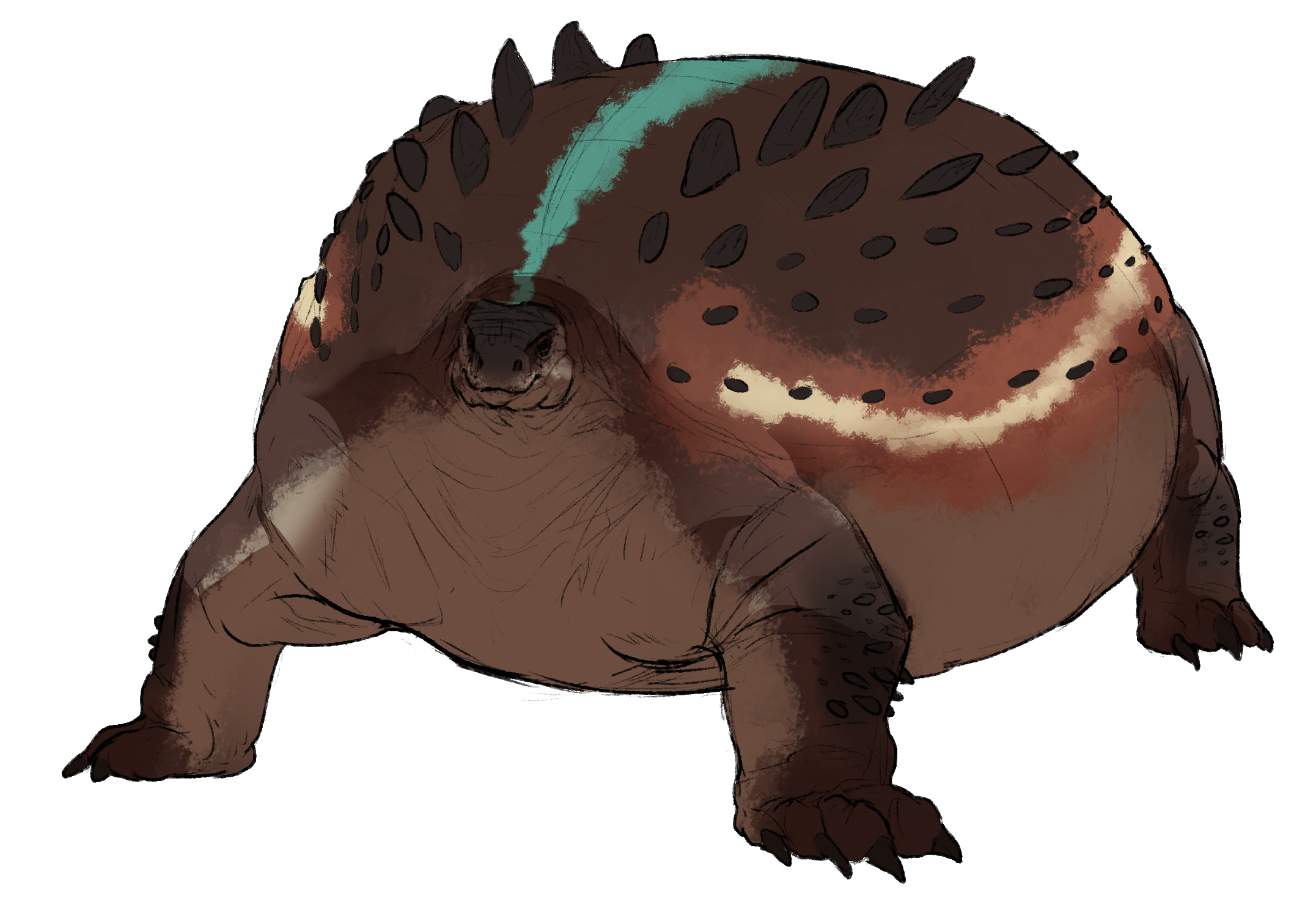 | Benjamin Location(s): Lacerta (Fornax) Danger Level: Dangerous Diet: Omnivorous, prefers plants Height: ~ 6 ft Quirk(s): Can Inflate Size No one knows how Benjamins got their name, but they are each and every one a force to be reckoned with. While generally solitary, placid and slow-moving, they brook absolutely no threat in their presence. Benjamins are already very broad, heavily-muscled beasts with a thickly armored hide, and are capable of inflating themselves somewhat with a layer of inhaled, compressed air between the layers of muscle and skin. Once inflated they will not hesitate to charge down any threat, trampling it beneath their weight or, more often, pinning it against a wall until it suffocates or is crushed. They are, despite being faster than perhaps expected, not all that speedy, and are--when not threatened--relatively docile. Benjamins generally extend their necks to feed on higher plants (or to pick up a few insects here and there to eat), but are capable of almost fully retracting them. Discovered by V-Labradorite-One! |
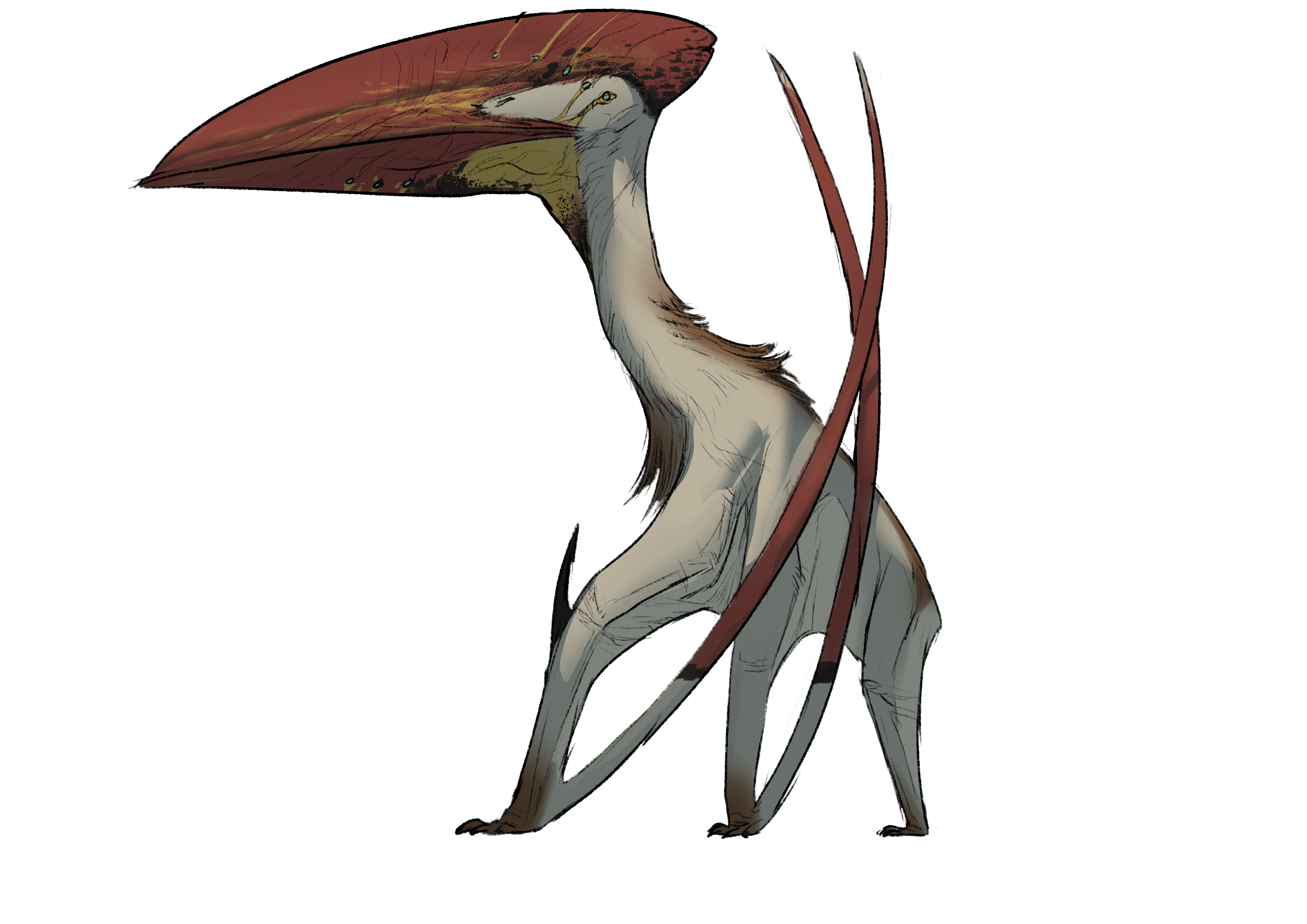 | Azhdar Location(s): Lacerta (Fornax) Danger Level: Deadly Diet: Carnivorous Wingspan: ~ 40 ft Quirk(s): Shockingly Vicious Azhdars are, thankfully, somewhat rare. Thankfully, because they are deadly, opportunistic and incredibly fierce. They are also very efficient predators, utilizing their ability to soar silently for hours--and their many eyes along both the top of their heads and beneath their jaws--in order to spot potential prey before folding all four wings and plunging into a deadly dive. Their heads alone are nearly ten feet long, their massive beak capable of gaping wide to swallow smaller Gembounds--Lesser or Greater--whole. They will not hesitate to attack even larger creatures, particularly if they're already injured, with hit-and-run strikes from the sky. Azhdars stand about twelve feet tall from feet to crown, with the head is nearly as long as the body. Azhdars are also territorial, and accidentally straying too close to a nest will result in vicious, relentless attacks. They are resilient, resourceful and somewhat intelligent, able to figure out how to crack open shellfish and willing to eat almost any form of fish or meat. Discovered by Arquia. |
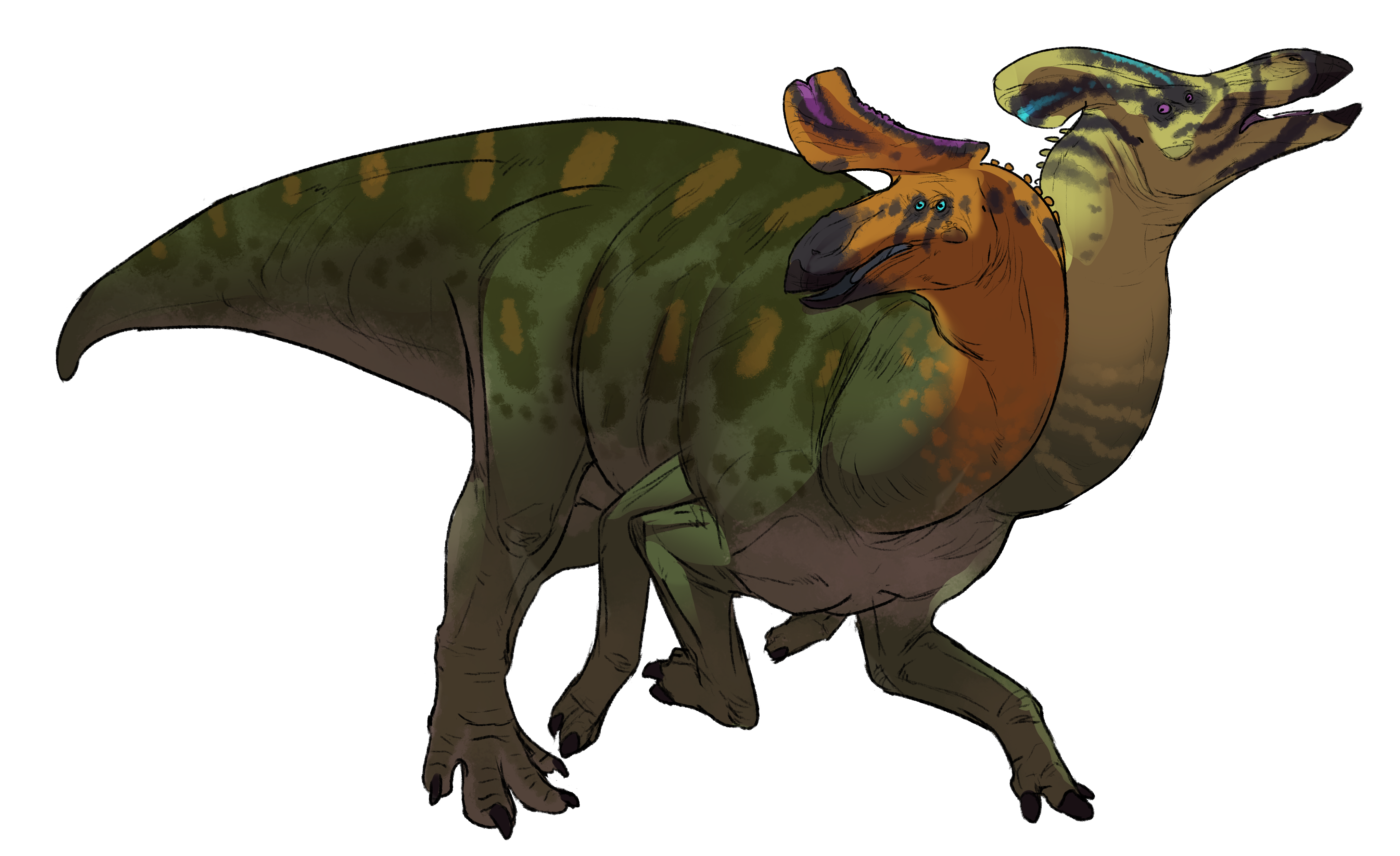 | Pugna Location(s): Lacerta (Fornax) Danger Level: Dangerous When Threatened Diet: Herbivorous Height: ~ 12 ft Quirk(s): Varying Double Heads Pugnas are strange beasts. They are herd-oriented herbivores, tending to move in large groups through the few open areas of Lacerta to graze during the day before retreating to the jungles and browsing thicker foliage at dawn and dusk. They are Lacerta's larger prey species, some forty-five feet long and twelve feet tall at the shoulder, and are large, heavy and strong, but relatively fast runners when using all six legs. Each Pugna has two heads, which can come in a variety of colors and patterns, and which each have their own distinct mind; generally, one head will eat while the other keeps watch, but at times the heads may 'argue'--sometimes loudly--when one wants to eat, despite the fact that they share a stomach. Discovered by Obieth! |
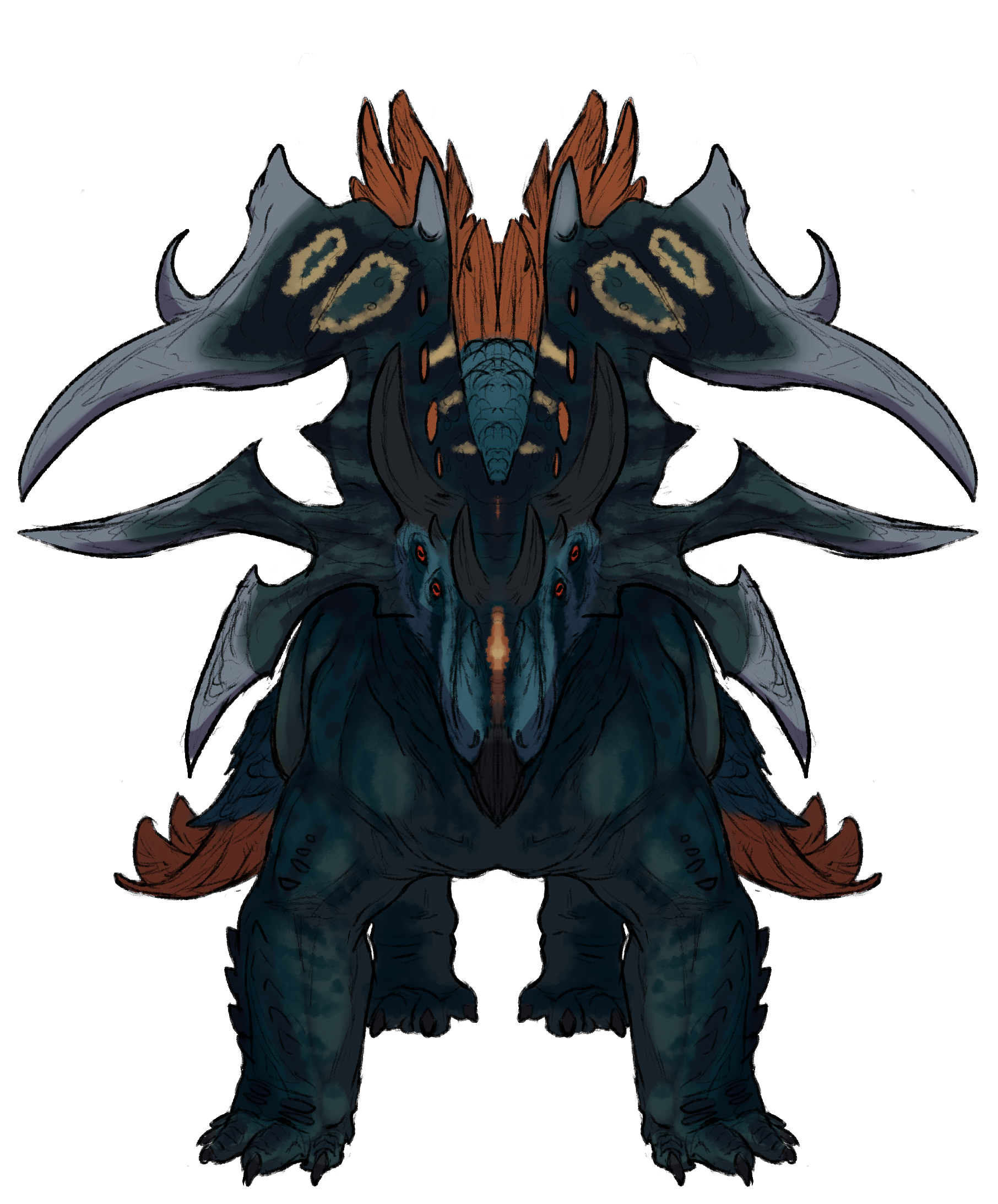 | Scythorn Location(s): Lacerta (Fornax) Danger Level: Dangerous When Threatened Diet: Herbivorous Height: ~ 9 ft Quirk(s): Extravagant Display Behavior Scythorn--pronounced "scythe-horn"--are immensely bulky, very strong herbivores that, like Benjamins, tolerate absolutely no threat. Despite being herbivorous--preferring to graze, browse and dig up roots to eat--they're highly aggressive, readily banding together to drive off any carnivore that dares draw close. Though they'll mingle with other herbivores at times, they tend to graze and browse just a little apart. Social beasts, they constantly jostle for hierarchy, and their magnificent displays include the ruffling and raising of feathers, the display of their frills, digging at the ground, and bellowing. Actual clashes are unusual but intensely violent. If actually attacked, the entire herd is likely to defend, unless the threat is immense; they attempt to trample smaller targets, or gore and impale larger with tosses of the bladed frill lining their faces. Discovered by Nidhogg! |
 | Deinocornus Location(s): Lacerta (Fornax) Danger Level: Deadly Diet: Carnivorous Height: ~ 5 ft Quirk(s): Bioluminescent Mouth Deinocornus are solitary ambush predators, taking the role of tigers or jaguars on Lacerta. They stalk the underbrush, moving in near-silence until they find prey, which they attempt to single out and take with a crushing bite. They tend to go for quick, silent kills to avoid angering the large herd animals that they prey upon. Long claws can disembowel enemies or prey in protracted fights. That said, prey that doesn't immediately succumb, and puts up a strong fight, can deter a Deinocornus's attempts; they tend to disengage and flee if their own lives are in danger. Their large horns are used both for display and fighting amongst themselves and, rarely, other creatures. Deinocornus are capable of emitting bright, usually blue, light from the mucus membranes of the mouth, for purposes of communication (usually threat or mating displays) with others of their kind. They mark territory with large slashes on logs and trees, and tend to avoid one another except when wanting to contest territory or seek a partner. Deinocornus is quite large--though only five feet tall, they are very long and muscular, and will attempt to prey on almost any of Lacerta's herbivores. Only fully adult Pugnas and Scythorns are left alone, though a Deinocornus will take their calves, when they can. Discovered by Madhukar! |
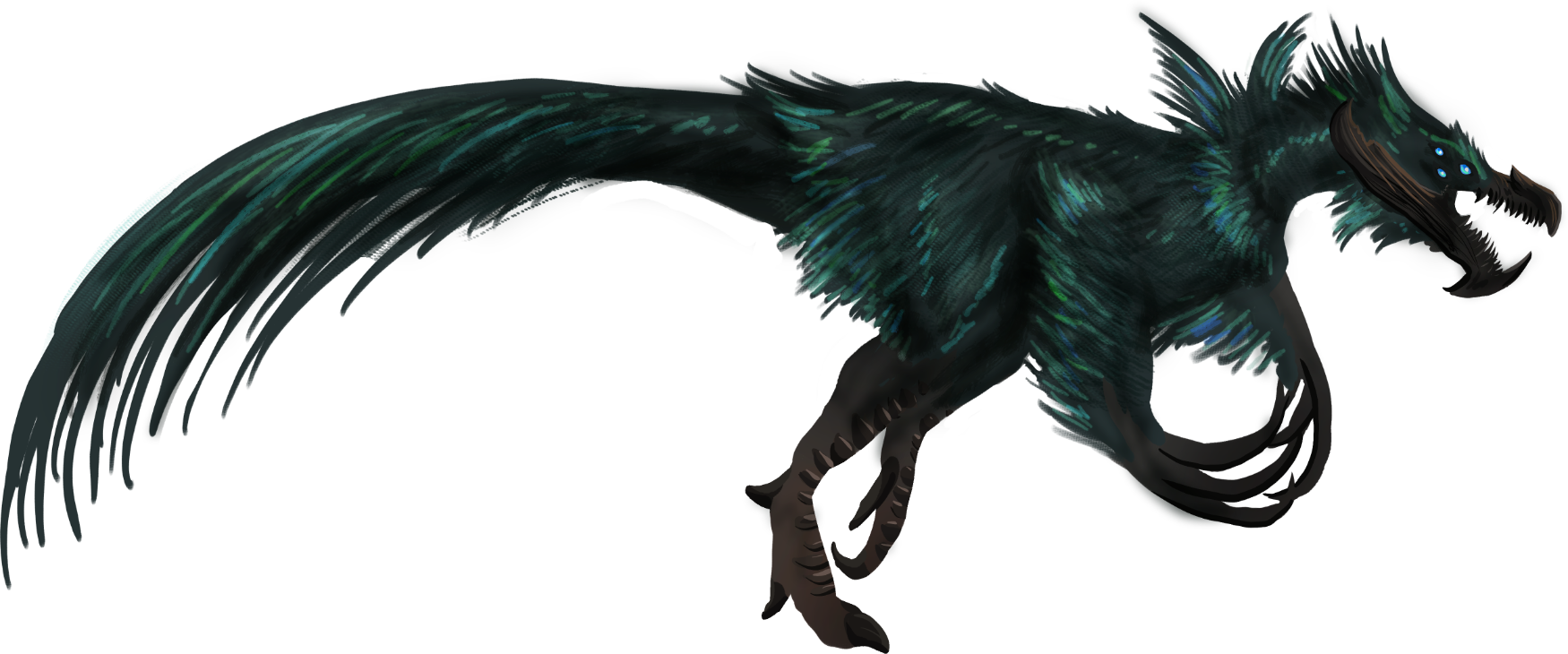 | Ripclaw Location(s): Lacerta (Fornax) Danger Level: Deadly Diet: Omnivorous Height: ~ 8 ft Quirk(s): Bioluminescent Feathers Ripclaws are large, athletic and highly aggressive creatures that can be found alone or in pairs, often along the edges of herbivore herds, where they're tolerated. Though omnivorous, they do not actively hunt large prey, instead only eating carrion or creatures the size of rats or mice--or Skrungers. Like Scythorns, they're incredibly intolerant of actual predators, and will actively pursue and attack any potential threat that they see. In combat they are deadly, utilizing slashes of enormous, razor-sharp claws on their forelimbs to tear at and disembowel targets. Their crushing jaws are capable of splitting smaller bones, though they're generally used for breaking heavy shells and nuts to eat. Ripclaws can induce a bright, rippling glow along their feathers, like iridescence but actually luminescent, usually in threat or communication with others of their kind. Discovered by Khavur! |
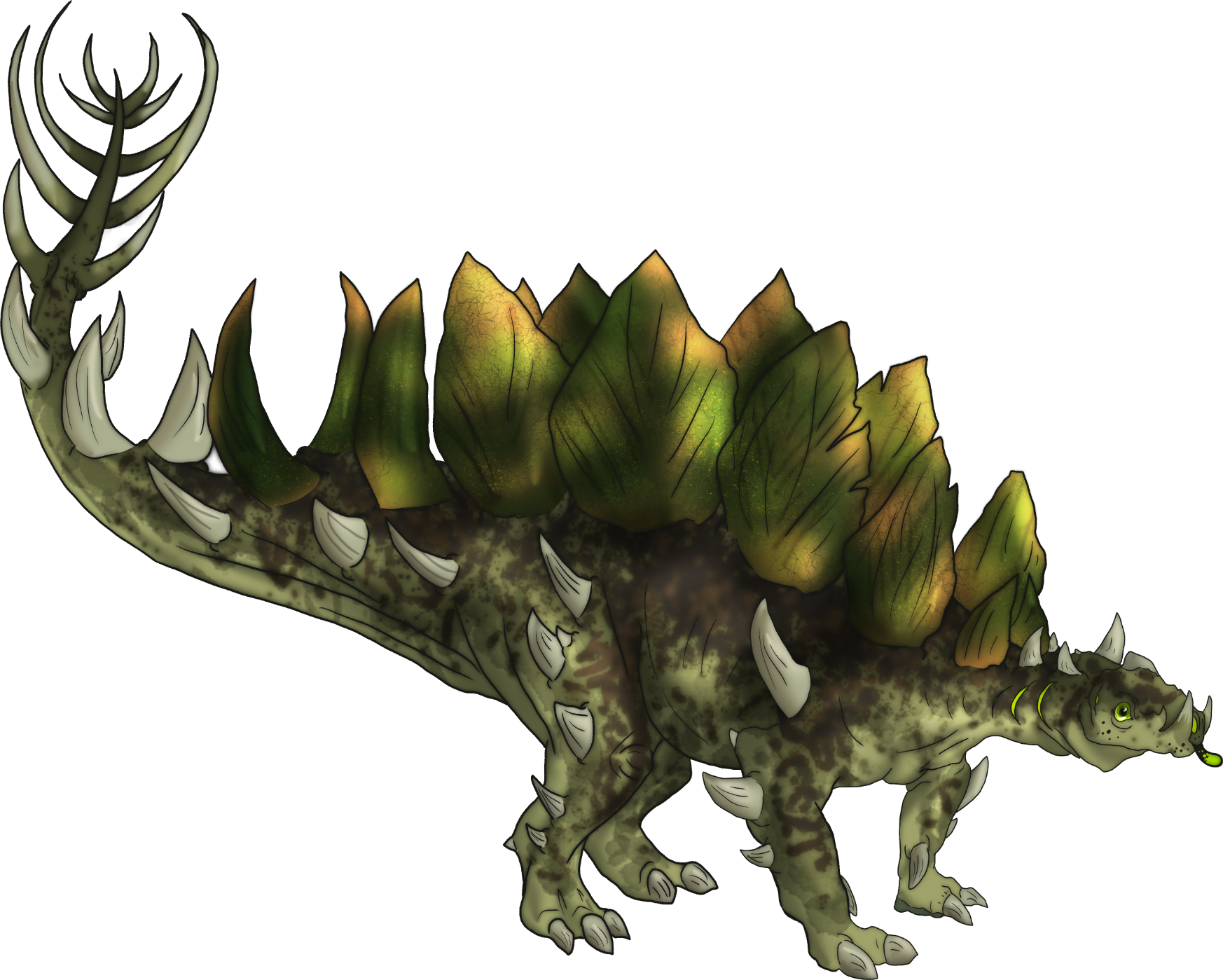 | Ogler Location(s): Lacerta (Fornax) Danger Level: Dangerous If Attacked Diet: Herbivorous Height: ~ 12 ft Quirk(s): Bioluminescent, Toxic Blood; Camouflaging Plates Some nine feet tall at the spine, twelve tall at the tips of their plates, and a little over thirty feet long, Oglers are another of Lacerta's larger, more dangerous herbivores. They're generally surprisingly well-hidden, staying in thick brush where their plates shift colors to match the foliage. They browse among bushes, eating any plants they come across, seeking out fruit where they can with long, sticky, glowing tongues and then crushing their food in strong, tusked jaws. They're generally very docile, ignoring (or perhaps not recognizing) most potential threats, until actually attacked. When attacked, an Ogler's plates provide defense, as do the keratinous spikes along their bodies; the spined tail is quite capable of swinging with powerful speed to impale or heavily lacerate a threat. Even when slain, their blood is toxic; eating their flesh can provide nutrition, but the more blood is consumed, the worse symptoms (dizziness, confusion and eventual unconsciousness) become. That said, Oglers are incredibly stupid animals, having gained their name from a peculiar habit: upon finding something foreign to them, they will tend to stop and simply stare at it for a very long time, as if trying to make sense of it. When moving out into the fields, they move in small herds, calling out others of their kind with long, fluting calls, though they lack any real form of organization. Discovered by Relic! |
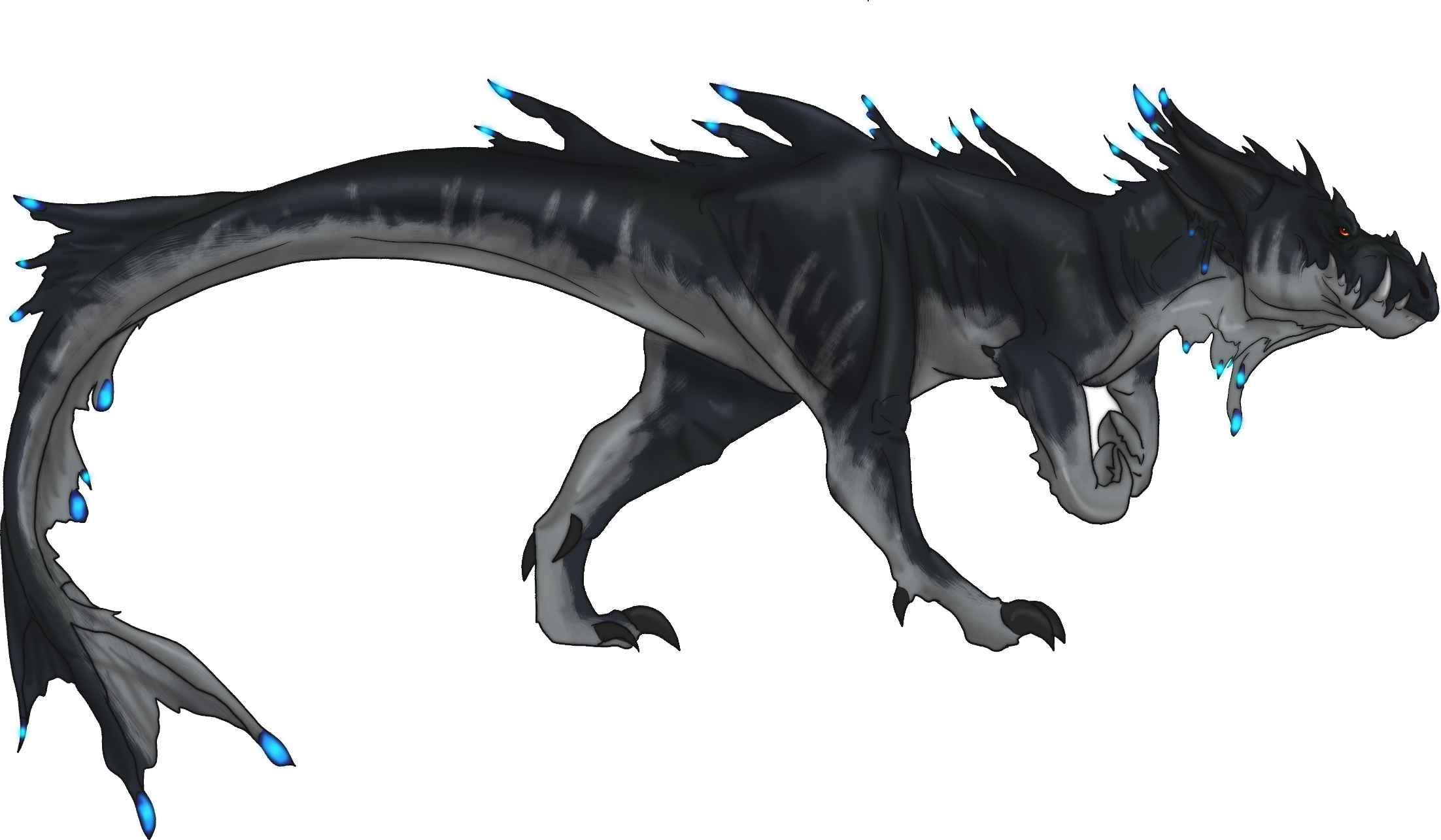 | Squallfang Location(s): Lacerta (Fornax) Danger Level: Deadly Diet: Carnivorous Height: ~ 12 ft Quirk(s): Bioluminescent, Amphibious Squallfangs are Lacerta's apex predator, though they tend to avoid conflict with other carnivores, preferring a life of slow, steady, solitary hunting. With both long, muscular legs and a powerful, finned tail, Squallfangs are adept at prowling both land and sea, often circling the shoreline around Lacerta for larger fish or unwary herbivores drinking at the water's edge. Larger Squallfangs will stalk the thick jungle, or even harass herds on the plains, unafraid of tackling larger prey. They are not mindlessly violent, however, and seek out prey that won't pose too much of a threat: weak or sick, or younger creatures, or those small enough for them to quickly kill. Given their size, however, this includes most of Lacerta's creatures. When hunting, powerful forearms with shearing pincers can shred victims in close quarters; immensely powerful jaws are capable of crushing and tearing bone. Colored spots along their various fins can blink and pulse with light, usually used when underwater to communicate to others of their kind or to lure in fish as prey. While Squallfangs have lungs and must surface to breathe, they are capable for holding their breath for nearly an hour, provided their activity is relatively sedate; exertion requires more frequent breaths. Discovered by Esther! |
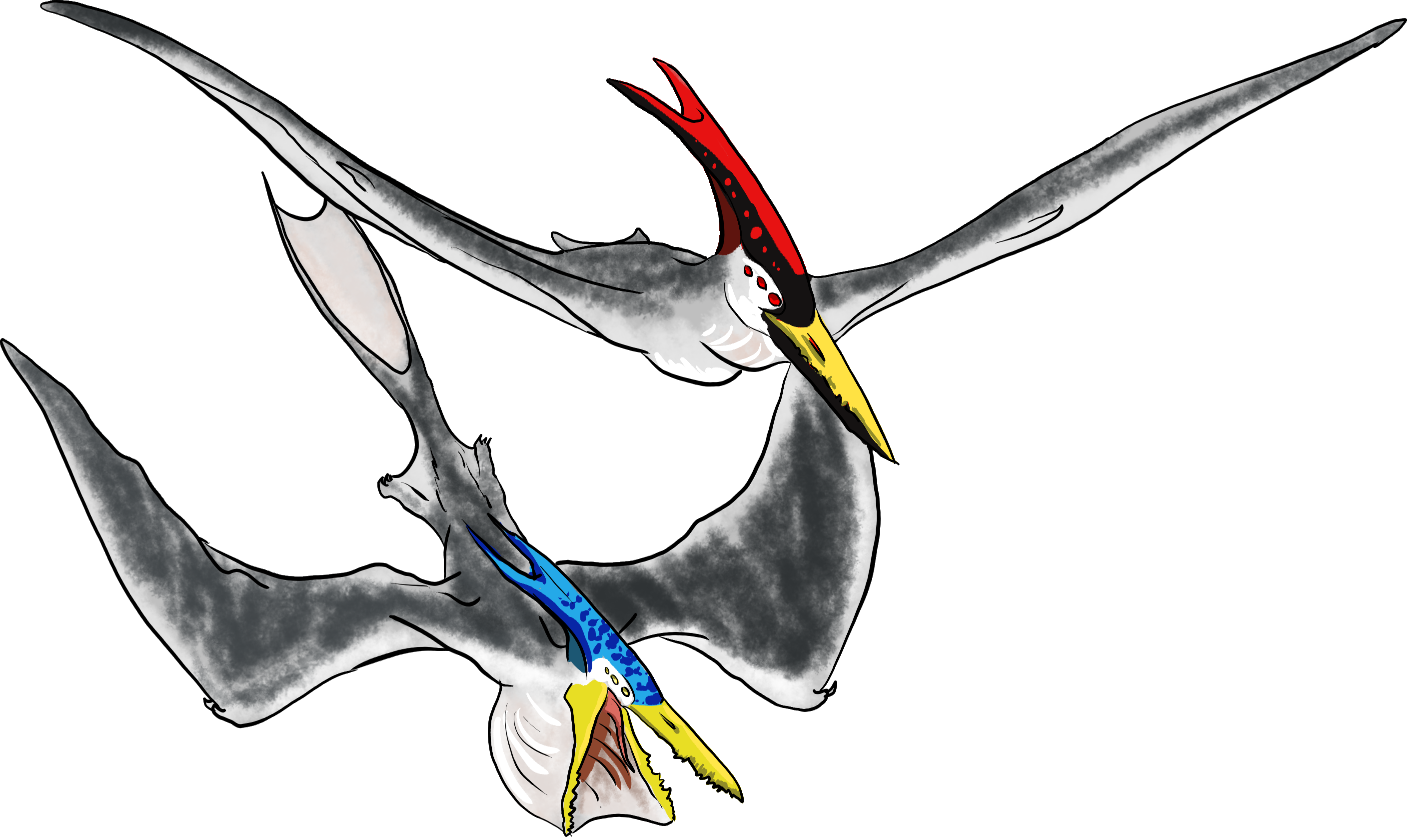 | Skimmer Location(s): Lacerta (Fornax) Danger Level: Harmless Diet: Piscivore Wingspan: ~ 8 ft Quirk(s): Split Mandibles, Unique Crests Skimmers fill the niche of Lacerta's airborne, less deadly fauna. Rather than apex predator role that the Azhdar fills, Skimmers are social flock Lessers that fill the skies with their bright, lingering calls. They nest and roost on higher cliffs to avoid Lacerta's larger threats, while sweeping down to the river and shores to skim for their main dietary preference: fish, preferably Starscales, Silverlings and the young Redfangs that spawn there, though they'll eat just about anything they can swallow from the 'sea.' Skimmers have several unique traits: first is their forked head crest, which has a color and pattern unique to each individual and allows them to identify one another at a distance; their eye pigment tends to match their crests. Another is the split mandible, which can open wide to allow a large pouch to help them in scooping up large amounts of tiny fish or Water Crawlers. Lastly, Skimmers are fairly intelligent creatures, and while flighty and shy, are capable of basic problem-solving in pursuit of meals. Skimmers become lonely when isolated, and do not thrive without company; a lost Skimmer will tend to become depressed and lethargic until it finds its flock again. Skimmers will scatter at the sight of an Azhdar above them; Azhdars will pick slow Skimmers off and eat them. But when Azhdars begin to soar in search of prey, Skimmers will sometimes fly above and behind one in the hopes of scavenging a meal of their own. On occasion, larger Lacerta beasts such as Ripsqualls will lie out on shore so that the Skimmers can pick sea-leech Drinkers from their hide. Discovered by Obieth! |
Andromeda Lessers
These Lesser Gembound are unique to Andromeda, though they run the gamut of types from bird to deer and beyond. They are still a work in progress!

Image by X! Mirrorbeast
Location(s): Andromeda
Danger Level: Harmless until provoked
Diet: Omnivorous
Height: 5 feet
Quirk(s): Refuses to interact with Gembound-made tools, objects, or technology
The Mirrorbeast is a creature of the approximate size and shape of a gorilla. From a distance it appears to be almost a flat surface; up close, it looks like a cut gemstone, with many angled crystalline planes that provide a smooth, black and reflective mirror which absorbs rather than reflects most ambient light. Its outlines and edges give off faint blue or violet glimmers. While it has no visible facial features (or even face), it does appear to deliver its food to its head with its 'hands'--food that appears to fall right through the dark surfaces and vanish into its body. This food is generally plant material, though the Mirrorbeast will occasionally consume very small creatures which it can swallow whole, such as insects, lizards and mice. Though it has no voice, the Mirrorbeast gives off a constant and indirect whispering from its planes; when truly angered, a it emanates a roar reminiscent of a waterfall and a thousand voices speaking jumbled words.
The Mirrorbeast is solitary, and ignores approaches and even touch, but it is sensitive to strong emotions (ex. intense anger or fear) or strong, disruptive magic (like high-intensity or Corrupt spells) and will react violently to either until they are eliminated. It avoids loud noise and bright lights, but never runs; at most, it appears to walk, shifting away at a speedy but dignified pace. If truly attempting to flee, it will appear to simply phase from existence, vanishing entirely from this plane. After some time (seconds to minutes) it will appear elsewhere. This is not true teleportation, and tracking magic (such as Spore or Familiar Forge) can still pursue the creature, vaguely sensing its location though it cannot be otherwise interacted with until it reappears.
created by Cicada!

Image by X! Nebula Newt
Location(s): Andromeda
Danger Level: Harmless
Diet: Mostly Herbivorous; prefers sweet food
Length: 1-1.5 Feet
Quirk(s): Preference for colorful foods, even whole flowers; will eat pastries and candy etc. if fed
A large, newt-like creature with clouds of swirling colors on a pale pink, purple, or (rarely) blue skin. The patterns vary in size and color based on what the Newt has recently eaten, and how much; a runty, hungry newt unable to compete for colorful foods might have only a few specks of color, whereas a well-fed newt may have a swirling galaxy of beautiful hues patterning its skin. Very well-fed newts use excess dietary energy to grow extra folds of tissue on fat tails, allowing them to spread the tail out like a fan while resting. The most colorful newts with the biggest fans tend to be the most successful in finding mates. As such, Nebula Newts tend to seek out the most colorful foods and eat them. Anything from entire flowers to mosses, fruits and insects, leaves and stems, and even processed foods if available, will be eaten.
Nebula Newts tend to congregate in groups up to twenty, but there may be fierce competition over the prettiest foods. Weaker groups may form loose alliances to acquire and defend pretty foods, then share them; these alliances are sometimes honored, sometimes betrayed. Newts are extremely skittish when active and feeding, but when resting, can be found clustered on cave walls, rock outcroppings or in patches of plants and flowers, where they will not flee unless directly threatened. One can observe them at leisure in this state. They are generally not aggressive, except to defend food against very small Gembounds, and even then only to acquire the food. Their only defense, other than flight, is to intensify the faint whispering that can often be heard around them--a louder (yet still faint) jumbled chorus among groups of Newts. If threatened, this intensifies into a sort of psychic shriek that fills the mind of their attacker with brief, paralytic, nightmarish terror, while the Newt attempts to flee to safety. Multiple screams from a group of newts can be incapacitating for several minutes as the Gembound recovers.
created by Cicada!

Image by X! Souls-in-a-Jar
Location(s): Andromeda
Danger Level: Dangerous to anything smaller than them
Diet: Omnivorous, Magically Vampiric
Length: Three inches to six feet, very long growth time (several years)
Quirk(s): Teleports when threatened
A Soul-in-a-Jar most resembles a magic hermit crab in the eerie shape of a humanoid limb. Their nucleus (including a small brain and any gemstone) is a biological, gel-like material of dark violet or blue; this is surrounded by a larger, gaseous body which glows a soft pink, violet or blue and can be made gel-like as needed, with some energy expenditure. Named for its love of hiding in enclosed spaces, the Soul-in-a-Jar can be found in rock crevices, abandoned belongings, half-open geodes, old buildings, ribcages and skulls--pretty much anything vaguely resembling a "container" can house a Soul. Sticky little tendrils from the nucleus keep it adhered to its chosen "jar;" as the Soul grows, some will tend to wander and find ever-larger containers to inhabit, abandoning the old (often in strange places). Alternatively, and especially if one finds a container it really likes, the Soul's nucleus can instead split over time, allowing a new Soul to crawl away and find a container of its own. They can, however, occasionally contain a gemstone piece; these Souls can also reproduce through granting life to stone.
The Soul-in-a-Jar senses food through vibrations, heat, moving shadows, or by reaching out and feeling blindly for something to consume. When it finds food, it manifests slender, often humanoid-like arms and hands; these limbs are larger and more numerous the larger the nucleus the Soul has to work with. Larger, more mature Souls can manifest multiple, larger limbs. These reach out, pull food inside its container, and envelop it, first sapping magical energy and then digesting physical matter. Any indigestible matter is thrown from the container by a limb as far as it can, to avoid leaving suspicious piles around... though the success of this strategy depends on the strength of the Soul-in-a-Jar. They do not appear to socialize or communicate, instead simply existing to acquire more food and grow. As such, they can be dangerous to Gembounds that are small enough to grab and consume. When threatened, a Soul-in-a-Jar will withdraw, pulling limbs back into its container. In truly desperate times, it can simply teleport away, reappearing elsewhere; if the container is moveable (ex. a shell or a skull) and the Soul strong enough, the container will go with it. If the container is stationary (ex. a small room or crack in the stone) or the Soul is weakened or injured, it will need to find itself a new container--or return to its old after danger has passed.
created by Cicada!

Image by Dark! Scryer
Location(s): Andromeda
Danger Level: Harmless
Diet: Omnivorous
Length: 1-2 Feet
Quirk(s): Passively Arcane; can sense nearby minds
These harmless, koi-like fish with long fins appear to have once been introduced as beautiful decoration. Their pearlescent scales shimmer in any light, splashed with hues of alabaster white, dark slate gray, black, and rich purples. Long whiskers and six (usually purple, sometimes blue, teal or pink) eyes help them to navigate the waters of Andromeda. A strange adaptation has taken form as a defense: if the school senses danger, for example a predator above, they turn to flash their flanks toward the threat, and illuminate a bioluminescent marking that looks like a purple eye to stare toward the potential danger. This tends to ward off predatory Lesser Gembound (and the occasional naive Greater). It can be eerie to see a cascade of glowing eyes abruptly illuminate darker waters. Aside from that, the Scryers' flesh is nutritious and tasty, and their diet--surface-going insects, tiny aquatic life and even plants--leaves them easy prey to any who can 'see' past their staring defenses.
Another strange facet of the Scryer is their innate Arcane magic. While very minor, it does allow them to passively sense nearby minds, so it is difficult to hide when hunting them. The feedback from this power produces two effects: first, nearby sounds can echo strangely in the presence of a Scryer or, more likely, a whole school. Second, a Gembound's very thoughts may also be echoed, so that they hear their own mind very quietly reflected back in distorted whispers across (or beneath) the water.
Created by Dark!

Image by Dark! Witness
Location(s): Andromeda
Danger Level: Harmless
Diet: Scavengers
Height: ~1.5 feet, 4 foot wingspan
Quirk(s): Magical echoes of itself periodically appear around it, distorting a flock's true numbers
Social, shy owl-like Lessers, the Witnesses are reclusive and hard to find. They avoid any conflict, and do not usually prey on anything larger than a mouse--and even then, only when very hungry. The preferred food of the Witness is carrion: they seem to be industrious cleaners, of a sort, their small and mostly silent flocks moving between the higher points of Andromeda in search of food. Physically, their soft and slightly iridescent feathers provide soundless flight and tend toward dark gray-purple and -blue, while glowing, toxic blood comes in hues of phosphorescent blue-green through various violets, indigo and pink. That blood informs the color of both their eyes and the tips of their quills: pointed and sharp as a defense mechanism, strewn throughout the feathers of their chests, neck and back. These quills light up when the Witness feels threatened, infusing with the toxic blood in case of attack. Four long-taloned claws on two legs grip the branches or rocks upon which they roost (two forward, two backward). Two stiff, cartilaginous ridges draw up and back in a hammerhead shape above the eyes; between them is a feathery crest that raises in times of stress or lowers when relaxed.
The Witness has two strange quirks that make it notable. First, their flocks--upon locating a creature that seems to be sick or dying--will cluster overhead, following and watching with glowing eyes against the shadows, waiting for it to die. They never attack still-living prey, but they are skilled at arriving at the precise moment of chrysalization or death to pluck a visible gemstone away, ensuring that they have a meal and not an inedible rock. Any resistance, however, sends them flying off in a glowing panic. Second, they are mimics, with soft-spoken voices. While generally quiet, they call to one another with random words and phrases they have heard, although they're not intelligent enough to attach the correct tone to their calls. Given their prediliction for being present at the point of death, the Witness's calls are often soft mimicries of the last words of Greater Gembounds. It isn't uncommon to hear a gentle, toneless "help" or "please" drifting through the shadowed corners of Andromeda.
Created by Dark!

Image by JaytheBird! Crystalback Rats
Location(s): Andromeda
Danger Level: Mostly Harmless
Diet: Omnivorous
Length: 1 foot
Quirk(s): Psychic Communication
Among the rats of Origin Cave, Crystalbacks are the odd ones out. Though omnivorous scavengers, they are smaller and can be fairly docile. Perhaps they did not have to evolve to be as dangerous as others, because of their elusive appearance that blends in among their preferred habitat in Andromeda. They tend to have colonies near gemstone deposits, and blend in quite well when lounging lazily about due to the symbiotic crystal formations that grow along their backs which give them their name. Appearance-wise, they can be very diverse, but the most common coloration is dim mauve with pink tips and crystals. However, they come in all colors of the rainbow for their crystal symbiotes and their fur tends towards more subdued colorations with a variety of markings.
While they seem to open their mouth to make noises, their squeaks and chitters are only broadcast via arcane magic to other Crystalback Rats of their own colony or--with work--to stranger rats. With patience and a careful search to find them in the first place, it is possible these rats could even be tamed and trained. Perhaps one could collect the shed of their crystal symbiotes for material, or simply keep them as entertaining companions; a mental link such as Familiar Forge or Mind Reader may even allow listening in to their admittedly meaningless chittering. When threatened, Crystalback Rats do not tend to fight back: instead, they shimmer into near-invisibility, attempting to flee from danger. A keen eye or senses can still pick out the shimmer of the invisibility's magic, or their odor or the scratching of their claws, as they flee.
Created by JayTheBird!

Image by JayTheBird! Storm Whisperer
Location(s): Andromeda
Danger Level: Harmless
Diet: Scavenger
Height: ~1 foot from head to tail
Quirk(s): Can sense incoming storms
Storm Whisperers are very quiet birds. They rarely make any noise at all, with the one of two exceptions being when a storm is forming in Andromeda; they seem to be able to sense these storms well before they break. Old superstition sometimes claims they summoned the storm themselves. When the Whisperers do make noise, it is a hissed whisper that grows louder and louder as more of the flock takes on their call. Storm Whisperers also make noise to 'help' more dangerous beings hunt by alerting them to prey with their whispers and then scavenging off the body alongside the predator in a symbiotic relationship. In either case, the lessers of Andromeda know that to hear a Storm Whisperer is to hear danger.
Eerie lights, like ignis fatuus or ball lightning, tend to rarely flash and drift around a Whisperer--more often when they are gathered in a flock. When they are calling their storm warnings, these lights can become a frequent, eerie blinking, like distant lightning. From a distance, the brief light of a single bird--especially in flight--can look like a wisp in the darkness, and have been known to lead travelling Gembound astray.
Created by JayTheBird!

Image by Gortys! Chandledeer
Location(s): Andromeda
Danger Level: Extremely Low
Diet: Herbivorous
Height: 3-4 feet (shoulder)
Quirk(s): Perodically followed by drifting shadows
Chandledeer are a enigmatic deer species. They are silent, usually roaming in small groups of three to four, seeming to appear and disappear when one looks away; shadows (either nebulous or with vague shape) appear to follow them, and hide them now and then. These deer are most notable for their massive antler racks, in the vague shape of a Chandelier made of deer antlers. On their necks as well they have three sets of short, tubular antlers. All of the Chandledeer's antlers are hollow and end in holes. Their bodies have long, silky straight hair that covers their legs and bodies, partially concealing them and making the chandledeer difficult to grab. The tail of Chandledeer are long as well, ending in a donkey-like tail with the same flowing hair. Chandledeer are unusually passive, even for cave deer. They dont seem to run away from most creatures. They remain aware of them, watching silently, but do not bolt. That is, until a creature comes within seven or so feet of them. Once that line has been crossed, their defense mechanism comes into play. The Chandledeer's hollow antlers exude a deluge of pale, opaque smoke and the Chandledeer bolt away with stunning speed, a shroud of unnatural shadow cloaking their bodies in retreat. The Chandledeer also use their smoke for communication between individuals, letting out small puffs from their nose or neck antlers. They can control the color of the smoke, and have different colors and puff frequencies for different things. Male Chandledeer rarely fight between each other, but those that do become an easy snack for predators as their antlers readily entangle.
Chandledeer antlers shed and regrow larger every twelve to thirteen cycles; while the antlers are regrowing, their ability to produce smoke to defend themselves is limited. Shed antlers are often carved and adapted to be makeshift musical instruments or other tools.
Created by Gortys!

Image by Gortys! Duplicator
Location(s): Andromeda
Danger Level: High
Diet: Carnivore
Length: 6-8 feet
Quirk(s): Powerful jaws, shifting colors
The Duplicator is a bizarre newt-like amphibian covered in soft spines, with the ability to change colors. It has a spade-shaped face with seven eyes, and its tail is very similar in shape to this head, with markings resembling its eyes. The Duplicator's real eyes are small and beady, a pearly opalescent, save for the large eye in the center of its head. It is normally grey, but when spotting prey or something interesting it will swirl with changing colors. Its tail eye, predictably, matches these color changes.
Duplicator bodies are chunky, flat, soft, and slimy, potentially leading one to believe they are harmless. However, the jaws of the duplicator are strong enough to punch through most hides. The Duplicators most often lie in areas of low foilage, slowly raising their tail when they spot prey. Once their tail is raised enough to be used it splits down the middle, revealing a pearlescent orb in the center. The orb projects a harmless but lifelike mirage of the duplicator. The duplicated duplicator stalks towards their prey, rapidly flashing colors and patterns and baring silent jaws in an attempt to terrify their prey into walking straight into the real Duplicator.
When something sees through the Duplicator's ambush, though, they immediately give up. The disgruntled duplicator lugs its body away, searching for another ambush spot. Young duplicators may throw a tantrum when spotted, rolling around, growling in frustration, and biting at random things around them. Like Scryers, the Duplicator is passively touched by Arcane magic, and can sense approaching minds (Lesser or Greater). A Gembound may become aware of the presence of a Duplicator when echoes of their own memories seem to flash or fade around them; when threatened, the Duplicator will flee, attempting to lock their attacker in place momentarily with a flood of the attacker's own memories.
Created by Gortys!

Image by Gortys! Maresnake
Location(s): Andromeda
Danger Level: Harmless
Diet: Hematophage (blood)
Length: 1-4 feet
Quirk(s): A rare variety grants nightmares
The Maresnake is a winged, hooded snake. Its head is long and thin, and not as flexible as most snakes, though they can open them horizontally to near 180 degrees. Inside the mouth of the Maresnake are strangely small and numerous fangs, all of which are hollow, and a tongue with many flanges. Its eyes are large with wide horizontal pupils. The Maresnake's hood is strangely shaped and droopy, with long specialized scales with star shaped projections at the end. Most Maresnakes lack any display inside the hood. Its wings have four padded fingers, as well as gripping spikes. The Maresnake is mostly nocturnal, coming out when the cave lights dim, as most of its prey is sleeping then. Its heatpits, belly scales, and ears are highly sensitive, which it uses to locate the sounds of snoring or sleeping creatures.
When it finds one, the Maresnake finds a soft spot to bite, uses its hood and wings to clamp itself to the area, and digs in its tiny, straight fangs. The maresnake's tiny fangs make the incision mostly painless, which it uses to inject its potent venom. Maresnake venom numbs the area and sends their victims into an even deeper slumber. Despite their names, the dreams given by most maresnakes are good albeit strange dreams, as they leave victims less likely to wake up. However a small percentage of Maresnakes, notable by the eyespots on their hoods, give nightmares rather than good dreams. Their venom is no less potent than normal Maresnakes, though their victims tend to wake up quicker due to the unpleasant dreams. Regardless of type, all Maresnakes will ignore any creatures smaller than them, not even seeing them as potential prey. The only sideffect most feel once waking from a mare dream is slight fatigue.
A disembodied, eerie singing can sometimes be heard near a Maresnake, particularly one that is resting. When threatened, this singing becomes a mind-gripping siren song which attempts to lure predators away from the fleeing serpent.
Created by Gortys!

Image by Gortys! Mystfox
Location(s): Andromeda
Danger Level: Annoying, Low
Diet: Omnivorous, Magically Vampiric
Height: 1.5-2 feet (shoulder)
Quirk(s): Playful, mischievous, magical
The Mystfox is a slender, usually blue and pink or rarely other colors or even white, fox-like creature with long legs. Topside it is covered in soft, floppy, cerata that extend from its neck to its tail. At the center of its tail is a pale blue orb. Mystfoxes have tall ears and a pair of floppy antennae. The Mystfox's face is shaped in such a way that it seems to always be smiling, and its calls are echoing giggles. They are curious and playful creatures, and may trail an interesting Gembound or Lesser from afar in slowly amassing groups that end up as a gaggle of ten to fifteen Mystfoxes. Though normally shy, as more gather they begin to grow more confident, and may dart at the target to engage in bouts of play, occasionally trying to take bits of their fur, feathers, or their items, playing games of keepaway and chicken with themselves and their unfortunate target. Mystfoxes, as magic-attuned creatures, often cause vague (not necessarily unpleasant) visions in non-Mystfox creatures around them. These hallucinations persist even if a Mystfox is gained as a familiar, and superstitious sorts may find try to interpret them as visions.
Mystfoxes are opportunistic omnivores, and most often go for whatever is easier to eat, be it fruit, carrion, or insects. While they may eat very small Gembounds, they are more inclined to use them as unwilling play things and toss them between each other. Mystfoxes can sustain themselves on magicka, and a hungry Mystfox may stalk an unwitting gembound to slap with their tail orbs. They then turn near-invisible and dart off to snack on bits of the unfortunate Gembound's magic. When the magic orb on a of a mystfox is at capacity, the mystfox will sprout another orb next to its original tail, then from that a full tail begins to grow, fuelled by the filled magicka orb. The age and health of a Mystfox can usually be determined by how many tails it has. When sufficiently spooked all of them go silent and the cerata on their back shiver, turning them nearly invisible in a flash; the hallucinations briefly intensify to cover their retreat. The Mystfoxes then scatter and flee, usually dropping whatever it was they stole.
Created by Gortys!

Image by X! Glow Wisps
Location(s): Andromeda
Danger Level: Harmless
Diet: Carnivore/Insectivore
Height: 2 inches - 1 foot
Quirk(s): Multiple defensive abilities, bioluminescent
Glow Wisps look very much like glowing jellyfish floating through the air, or rarely dipping underwater for a time. The umbrella of the creature can in the shape of domes, pyramids, diamonds, spheres, spirals, or spheroids, and the tentacles look like wisps, so that when these lessers float about or "swim" in the air they seem to leave a trail of light behind them. Though translucent, the Glow Wisps's light pulse with color, which is individual to each Wisp. The most common come in shades of pink, purple, blue, grey, and yellow, though it has not been unheard of to see them in red, green, or white as well. The light is the most intense in the center of their bodies. Glow Wisps may float in groups, though they can also be seen drifting off by themselves. They feed as they drift, usually consuming very small insects or other quite tiny creatures by snagging them in their trailing tentacles. Glow Wisps can enter a magically camouflaged state at will; this can result in them seeming to blink in and out of glowing existence, like orbs of light appearing and reappearing apparently at random.
Glow Wisps are passive creatures, always choosing to flee a threat. When they are being chased by a predator, they propel themselves in similar fashion to jellyfish and employ one of a number of defensive abilities. They may choose to increase their glow in an attempt to blind the predator or make it hard to see them; they may also camouflage themselves magically, seeming to shimmer into near-invisibility. They can also release glitter behind them which may induce drowsiness or cause sneezing to deter predators. The tentacles can sting, but it is harmless to anything that's not insects. It may be fun to touch them for a strange tingling feeling.
Created by Comet!

Image by ShadowLugia711! Weeping Cloak
Location(s): Andromeda
Danger Level: Dangerous to smaller Gembounds
Diet: Omnivore, Magical Vampire
Height: 4-6 feet tall
Quirk(s): Adult size varies widely
The Weeping Cloak is named for its loud, haunting cries; these vocalizations can sound like weeping, sobbing, and wailing. Physically, Cloaks are bipedal creatures with winged arms and long legs tipped with three taloned toes, standing upright and hunched. Its body is covered in scaled plates and smooth skin, usually colored grey to black. The wings are smooth, and the 'hands' have only one 'finger' separate from the membranes. The wings' upper surface shares the body color, but typically the undersides are a bright and vibrant hue, often red, pink, purple, or blue. A third membrane hngs down the back from the base of the neck, giving the illusion that their wings are a long cape held around them. A smoothly scaled head holds a jaw that splits into two mandibles connected by skin, featuring needle-like teeth for gripping. Glowing eyes match the undersides of their wings, and when well-fed, excrete excess magical energy in the form of trailing wisps, flames, or lightning; these fade when the eyes are closed.
The Cloak is generally an ambush hunter--tucking its head down and wrapping its wings around it to appear as a large, dull-colored rock, then springing to wrap wings and jaws around suitable prey items that wander too close. The innate magic is used to pummel this prey with shocks or burns. However, the Cloak is not a picky eater, and will also consume fruits, honey and other calorie-dense foods. To power their attacks, they will also consume sources of magic as they find them--often in the form of draining the gemstones of dead prey.
A Weeping Cloak in motion is generally not hunting, but instead haunting Andromeda in search of a resting place, mate, or something else entirely. When threatened, the Cloak's typical wailing cries become a mentally piercing, terrifying psychic shriek, deafening and capable of temporarily stunning all thought and action from its target as it flees.
Created by ShadowLugia71!
Other Lessers
Many Lesser Gembound are so alien and unique as to defy classification. Some might resemble an existing category, but be sufficiently different that it would be strange to group them together. A few of these are listed here.
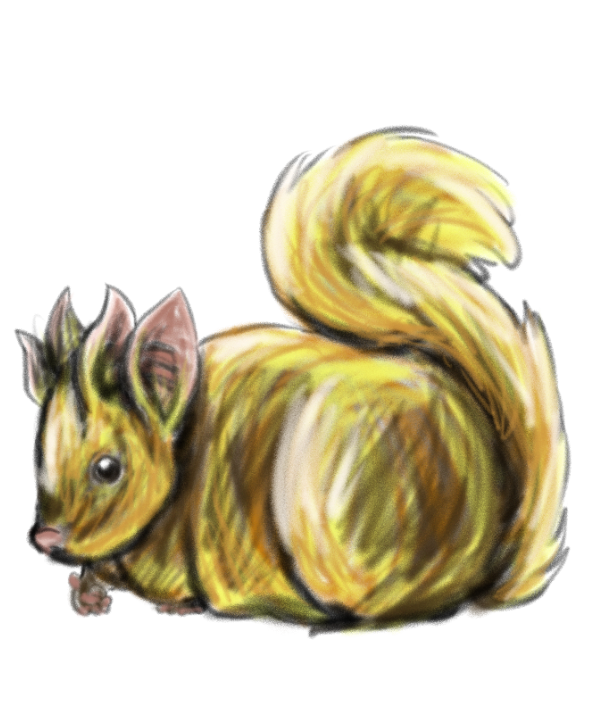
Image by Schafaer! Gilded Catsquirrel
Location(s): Treetops
Danger Level: Harmless
Diet: Omnivorous
Length: ~2 feet (+ tail)
Quirk(s): Highly-social, climbing-adapted
With strange characteristics of rats, squirrels and even primates, the Gilded Catsquirrel rather defies categorization. It is about the size of a Cave Rat, though it lacks their ragged appearance. They tend toward dark greys or browns, with gold tips to each hair which lends them an overall shining effect, as if they’ve been coated in gold. Their tails are very long, and are prehensile, allowing them both balance and climbing aid while traversing the branches among which they make their home. They are exceptional climbers and when under attack will bolt up a tree if they can. They are omnivorous, consuming edible plants, fruits, fungi, insects, and vertebrates smaller than themselves. They have four toes on the front of each foot and two to either side, allowing them to grip and hold objects. They each have four long ears with highly-sensitive hearing which they use to listen for both danger and for one another’s calls: a Gilded Catsquirrel’s yowl is not unlike an upset cat’s. This is used to signal other Catsquirrels of danger.
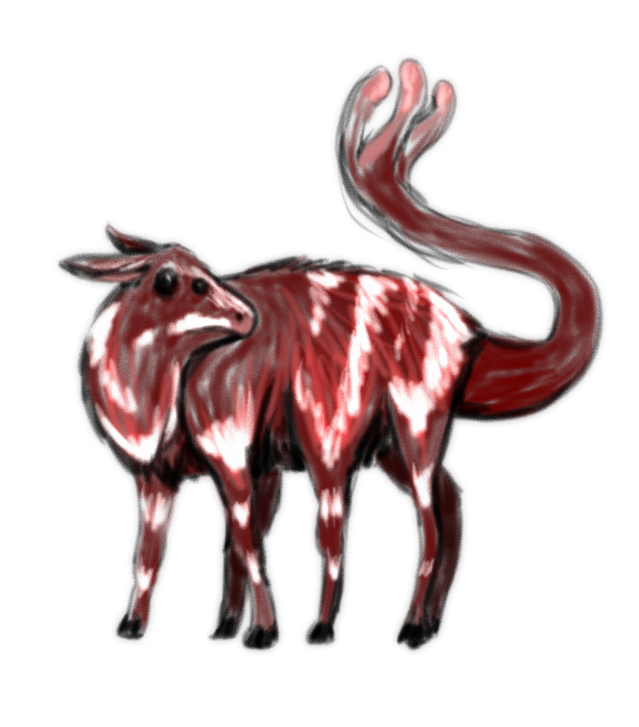
Image by Schafaer! Kooru
Location(s): Anywhere with plants
Danger Level: Harmless
Diet: Herbivorous
Length: ~2 feet at shoulders
Quirk(s): Vocal, prehensile tails
Named for their distinctive call, which sounds as if they are calling out ‘Kooru,’ the Kooru is a strange creature. It sports six long legs ending in cloven hooves, and yet bears a long, prehensile tail double the length of their bodies. These tails end in three feelers, and are often used to pick up and throw rocks at threats, or to pick berries, leaves and nuts from plants. They sometimes carry this food with them and consume it at a later time. Generally green, blue, or red in color, they bear glowing white stripes which vary in pattern and orientation for each individual. Their blunt teeth are made for grinding foliage, and they have four large, dark eyes which can keep watch for predators even while they sleep (one set remains open, the other closes in rest). Male Kooru are solitary creatures that claim a small territory and defend it, while females wander in search of a mate. It is not uncommon to hear the males bellowing through the trees in an attempt to impress the females.
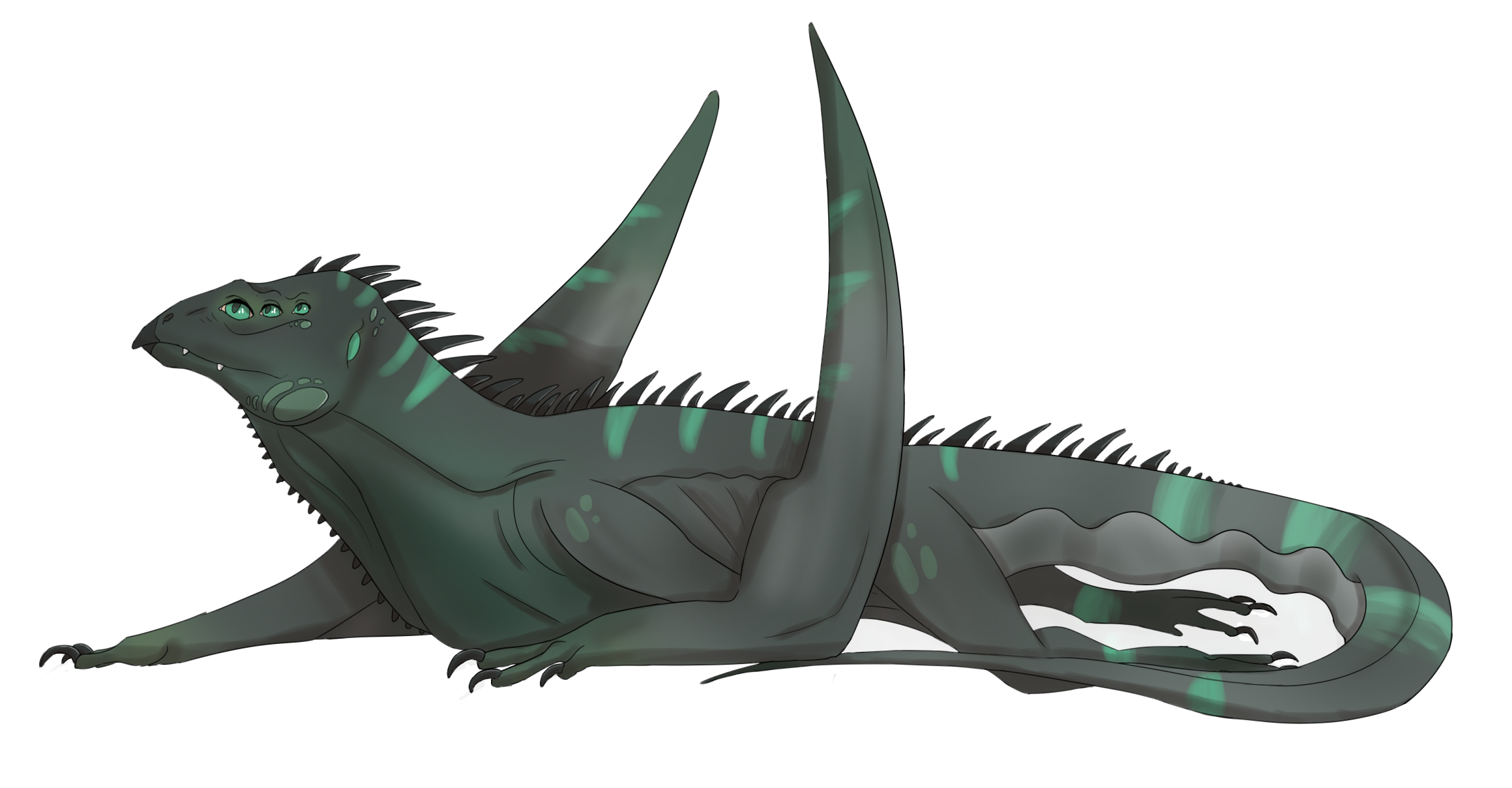
Image by Charlie! Kyte
Location(s): Everywhere
Danger Level: Harmless to large Gembound
Diet: Carnivorous
Length: 3.5 feet long
Quirk(s): Reptilian, but flight-oriented
Kytes are large, flying reptilian creatures up to three and a half feet in length, with a wingspan of about seven feet. They are furless, instead covered with smooth, cool skin. They have no forelegs, with the wings taking their place; these wings have claws to aid in gripping and climbing cave walls. Their rear legs can bend forward and backward, and bear strong hooked claws, for the same purpose. Their tails are as long again as their bodies and have flaps of skin running lengthwise to help them balance and glide in the air. They have three pairs of eyes that provide a full range of vision while flying, and their vision is so sharp that they can see a bug from a mile away in clear conditions. They primarily hunt insects and smaller vertebrates, using long, beak-like mouths with serrated teeth to pick prey from the ground or from the trunks of trees. Kytes are generally black or grey, with vividly-colored markings. These markings can take the form of stripes, spots, spirals, or a mixture of the above, and make them fairly easy to spot when skimming the treetops or nesting in their rocky crags. If killed, their flesh is surprisingly flavorful.
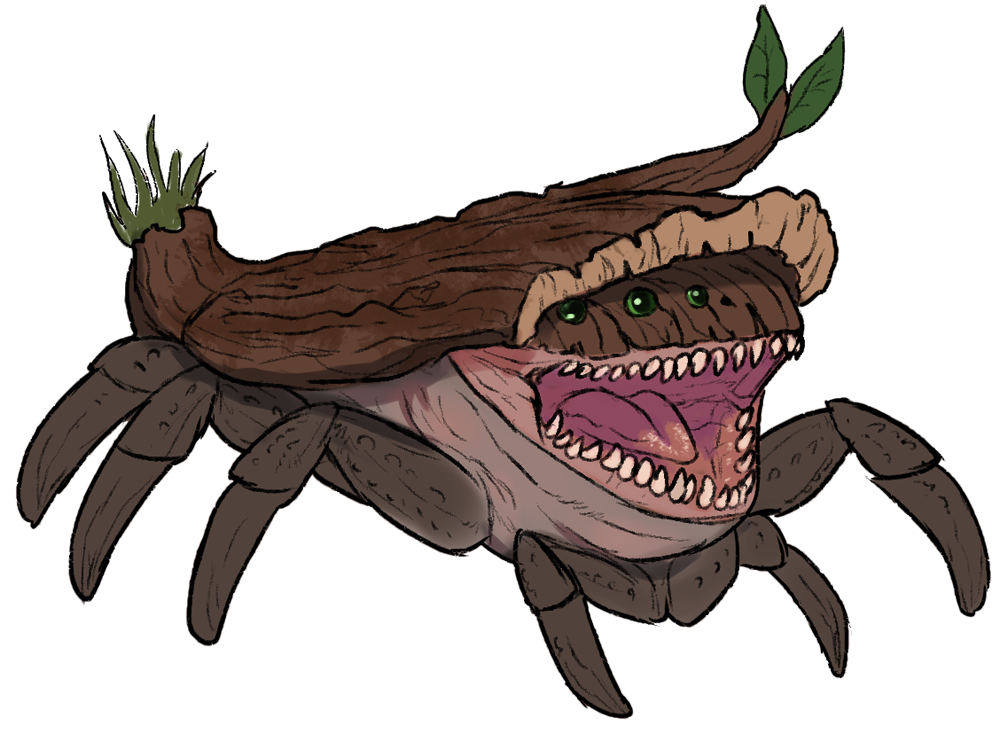
Image by Gortys! Trapdoor Ray
Location(s): All Tunnels
Danger Level: Aggressive
Diet: Carnivorous
Length: 1-2 ft
Quirk(s): Camouflaged, can change textures
Trapdoor Rays are broad creatures with the distinctive shape of a teardrop. They walk low to the floor, scuttling along on eight segmented legs. Their undersides are fleshy and faintly translucent, whereas their dorsal is well-armored and sturdy. A large, frog-like mouth full of teeth takes up about a third of their body's total length. The top coating of carapace is advantageous to their hunting: they tend to settle down in highly trafficked tunnels and wait for something small enough to step on them. Like the Shifting Mantis, Trapdoors develop their camouflage based on their surroundings. There is a subspecies for every Tunnel.
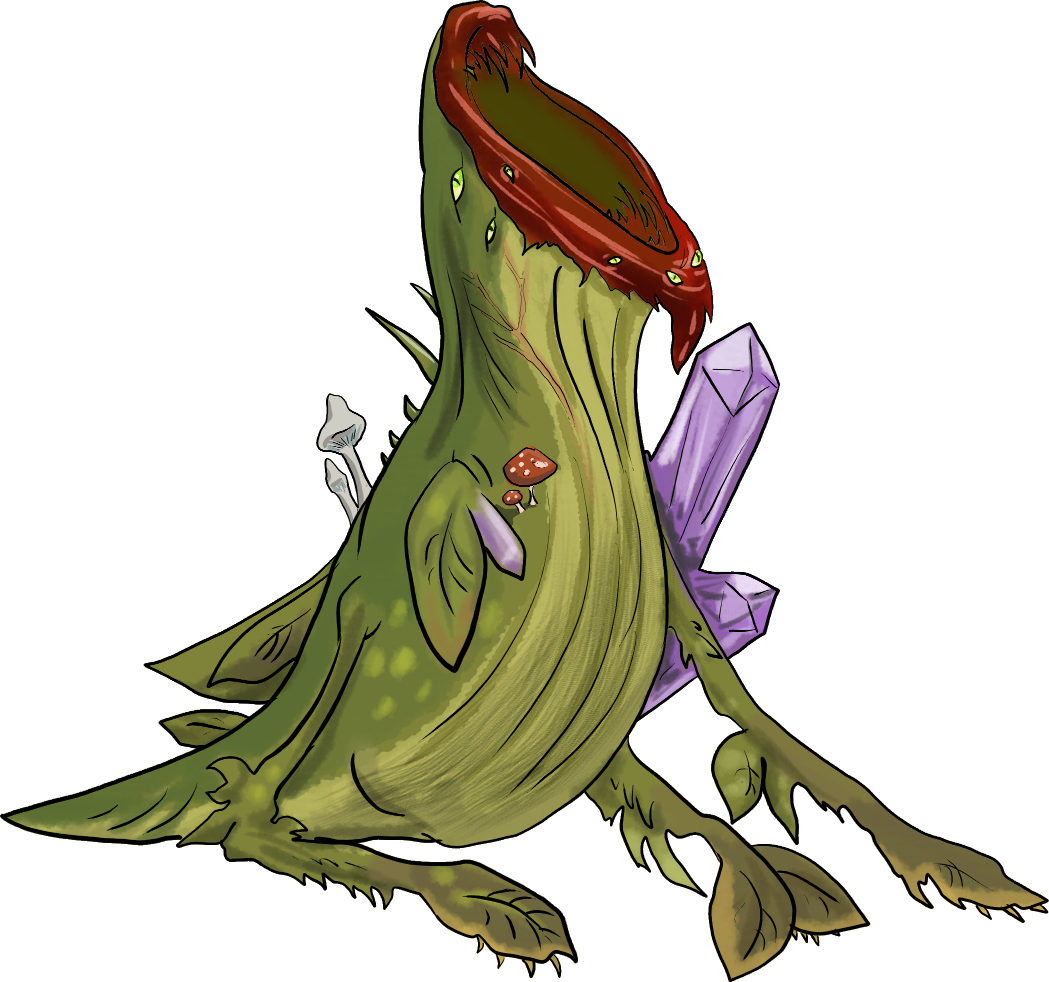
Image by Dark! Crystal Pitcher Plant
Location(s): Gemini, anywhere with plants
Danger Level: Neutral unless hunting
Diet: Carnivorous
Height: Up to six feet tall
Quirk(s): Appearance adapts to blend in with cave location
This creature mimics, in appearance and behavior, carnivorous plants commonly known as "Pitcher Plants." It resides and grows in the walls of Gemini, or anywhere it can blend in with plant life. Many crystals and glowing mushroom species coat its outer form and lid, its skin and limbs adapted to mimic plant leaves and roots. It is not very mobile: its most notable feature is its stomach, taking up three quarters of its long pitcher-like torso. Its other organs and functions are located in random places beneath the surface layer of skin. Its mouth leads directly to this stomach, which is lined with rows upon rows of sharp, rotating teeth capable of shredding bone and gemstone. At the bottom of its open stomach is a pool of highly corrosive acid that aids in the digestive process, in which the plant takes several hours to absorb the rapidly-liquefied remains of prey. Random numbers of front-facing eyes rim the top of its lid, which it uses to locate prey. It can lunge several feet forward in an attempt to catch prey. It is rarely aggressive unless hungry, however, and is surprisingly intelligent and capable of being social; while generally solitary they are also sometimes found growing in large groups called 'clusters,' and in private, use limbs to communicate via quiet squeaking noises.
Much of the information here has been taken from the original, player-made Lesser Gembound Species thread, visible here.
These Lesser Gembound are unique to Andromeda, though they run the gamut of types from bird to deer and beyond. They are still a work in progress!
| Mirrorbeast Location(s): Andromeda Danger Level: Harmless until provoked Diet: Omnivorous Height: 5 feet Quirk(s): Refuses to interact with Gembound-made tools, objects, or technology The Mirrorbeast is a creature of the approximate size and shape of a gorilla. From a distance it appears to be almost a flat surface; up close, it looks like a cut gemstone, with many angled crystalline planes that provide a smooth, black and reflective mirror which absorbs rather than reflects most ambient light. Its outlines and edges give off faint blue or violet glimmers. While it has no visible facial features (or even face), it does appear to deliver its food to its head with its 'hands'--food that appears to fall right through the dark surfaces and vanish into its body. This food is generally plant material, though the Mirrorbeast will occasionally consume very small creatures which it can swallow whole, such as insects, lizards and mice. Though it has no voice, the Mirrorbeast gives off a constant and indirect whispering from its planes; when truly angered, a it emanates a roar reminiscent of a waterfall and a thousand voices speaking jumbled words. The Mirrorbeast is solitary, and ignores approaches and even touch, but it is sensitive to strong emotions (ex. intense anger or fear) or strong, disruptive magic (like high-intensity or Corrupt spells) and will react violently to either until they are eliminated. It avoids loud noise and bright lights, but never runs; at most, it appears to walk, shifting away at a speedy but dignified pace. If truly attempting to flee, it will appear to simply phase from existence, vanishing entirely from this plane. After some time (seconds to minutes) it will appear elsewhere. This is not true teleportation, and tracking magic (such as Spore or Familiar Forge) can still pursue the creature, vaguely sensing its location though it cannot be otherwise interacted with until it reappears. created by Cicada! |
| Nebula Newt Location(s): Andromeda Danger Level: Harmless Diet: Mostly Herbivorous; prefers sweet food Length: 1-1.5 Feet Quirk(s): Preference for colorful foods, even whole flowers; will eat pastries and candy etc. if fed A large, newt-like creature with clouds of swirling colors on a pale pink, purple, or (rarely) blue skin. The patterns vary in size and color based on what the Newt has recently eaten, and how much; a runty, hungry newt unable to compete for colorful foods might have only a few specks of color, whereas a well-fed newt may have a swirling galaxy of beautiful hues patterning its skin. Very well-fed newts use excess dietary energy to grow extra folds of tissue on fat tails, allowing them to spread the tail out like a fan while resting. The most colorful newts with the biggest fans tend to be the most successful in finding mates. As such, Nebula Newts tend to seek out the most colorful foods and eat them. Anything from entire flowers to mosses, fruits and insects, leaves and stems, and even processed foods if available, will be eaten. Nebula Newts tend to congregate in groups up to twenty, but there may be fierce competition over the prettiest foods. Weaker groups may form loose alliances to acquire and defend pretty foods, then share them; these alliances are sometimes honored, sometimes betrayed. Newts are extremely skittish when active and feeding, but when resting, can be found clustered on cave walls, rock outcroppings or in patches of plants and flowers, where they will not flee unless directly threatened. One can observe them at leisure in this state. They are generally not aggressive, except to defend food against very small Gembounds, and even then only to acquire the food. Their only defense, other than flight, is to intensify the faint whispering that can often be heard around them--a louder (yet still faint) jumbled chorus among groups of Newts. If threatened, this intensifies into a sort of psychic shriek that fills the mind of their attacker with brief, paralytic, nightmarish terror, while the Newt attempts to flee to safety. Multiple screams from a group of newts can be incapacitating for several minutes as the Gembound recovers. created by Cicada! |
| Souls-in-a-Jar Location(s): Andromeda Danger Level: Dangerous to anything smaller than them Diet: Omnivorous, Magically Vampiric Length: Three inches to six feet, very long growth time (several years) Quirk(s): Teleports when threatened A Soul-in-a-Jar most resembles a magic hermit crab in the eerie shape of a humanoid limb. Their nucleus (including a small brain and any gemstone) is a biological, gel-like material of dark violet or blue; this is surrounded by a larger, gaseous body which glows a soft pink, violet or blue and can be made gel-like as needed, with some energy expenditure. Named for its love of hiding in enclosed spaces, the Soul-in-a-Jar can be found in rock crevices, abandoned belongings, half-open geodes, old buildings, ribcages and skulls--pretty much anything vaguely resembling a "container" can house a Soul. Sticky little tendrils from the nucleus keep it adhered to its chosen "jar;" as the Soul grows, some will tend to wander and find ever-larger containers to inhabit, abandoning the old (often in strange places). Alternatively, and especially if one finds a container it really likes, the Soul's nucleus can instead split over time, allowing a new Soul to crawl away and find a container of its own. They can, however, occasionally contain a gemstone piece; these Souls can also reproduce through granting life to stone. The Soul-in-a-Jar senses food through vibrations, heat, moving shadows, or by reaching out and feeling blindly for something to consume. When it finds food, it manifests slender, often humanoid-like arms and hands; these limbs are larger and more numerous the larger the nucleus the Soul has to work with. Larger, more mature Souls can manifest multiple, larger limbs. These reach out, pull food inside its container, and envelop it, first sapping magical energy and then digesting physical matter. Any indigestible matter is thrown from the container by a limb as far as it can, to avoid leaving suspicious piles around... though the success of this strategy depends on the strength of the Soul-in-a-Jar. They do not appear to socialize or communicate, instead simply existing to acquire more food and grow. As such, they can be dangerous to Gembounds that are small enough to grab and consume. When threatened, a Soul-in-a-Jar will withdraw, pulling limbs back into its container. In truly desperate times, it can simply teleport away, reappearing elsewhere; if the container is moveable (ex. a shell or a skull) and the Soul strong enough, the container will go with it. If the container is stationary (ex. a small room or crack in the stone) or the Soul is weakened or injured, it will need to find itself a new container--or return to its old after danger has passed. created by Cicada! |
 | Scryer Location(s): Andromeda Danger Level: Harmless Diet: Omnivorous Length: 1-2 Feet Quirk(s): Passively Arcane; can sense nearby minds These harmless, koi-like fish with long fins appear to have once been introduced as beautiful decoration. Their pearlescent scales shimmer in any light, splashed with hues of alabaster white, dark slate gray, black, and rich purples. Long whiskers and six (usually purple, sometimes blue, teal or pink) eyes help them to navigate the waters of Andromeda. A strange adaptation has taken form as a defense: if the school senses danger, for example a predator above, they turn to flash their flanks toward the threat, and illuminate a bioluminescent marking that looks like a purple eye to stare toward the potential danger. This tends to ward off predatory Lesser Gembound (and the occasional naive Greater). It can be eerie to see a cascade of glowing eyes abruptly illuminate darker waters. Aside from that, the Scryers' flesh is nutritious and tasty, and their diet--surface-going insects, tiny aquatic life and even plants--leaves them easy prey to any who can 'see' past their staring defenses. Another strange facet of the Scryer is their innate Arcane magic. While very minor, it does allow them to passively sense nearby minds, so it is difficult to hide when hunting them. The feedback from this power produces two effects: first, nearby sounds can echo strangely in the presence of a Scryer or, more likely, a whole school. Second, a Gembound's very thoughts may also be echoed, so that they hear their own mind very quietly reflected back in distorted whispers across (or beneath) the water. Created by Dark! |
 | Witness Location(s): Andromeda Danger Level: Harmless Diet: Scavengers Height: ~1.5 feet, 4 foot wingspan Quirk(s): Magical echoes of itself periodically appear around it, distorting a flock's true numbers Social, shy owl-like Lessers, the Witnesses are reclusive and hard to find. They avoid any conflict, and do not usually prey on anything larger than a mouse--and even then, only when very hungry. The preferred food of the Witness is carrion: they seem to be industrious cleaners, of a sort, their small and mostly silent flocks moving between the higher points of Andromeda in search of food. Physically, their soft and slightly iridescent feathers provide soundless flight and tend toward dark gray-purple and -blue, while glowing, toxic blood comes in hues of phosphorescent blue-green through various violets, indigo and pink. That blood informs the color of both their eyes and the tips of their quills: pointed and sharp as a defense mechanism, strewn throughout the feathers of their chests, neck and back. These quills light up when the Witness feels threatened, infusing with the toxic blood in case of attack. Four long-taloned claws on two legs grip the branches or rocks upon which they roost (two forward, two backward). Two stiff, cartilaginous ridges draw up and back in a hammerhead shape above the eyes; between them is a feathery crest that raises in times of stress or lowers when relaxed. The Witness has two strange quirks that make it notable. First, their flocks--upon locating a creature that seems to be sick or dying--will cluster overhead, following and watching with glowing eyes against the shadows, waiting for it to die. They never attack still-living prey, but they are skilled at arriving at the precise moment of chrysalization or death to pluck a visible gemstone away, ensuring that they have a meal and not an inedible rock. Any resistance, however, sends them flying off in a glowing panic. Second, they are mimics, with soft-spoken voices. While generally quiet, they call to one another with random words and phrases they have heard, although they're not intelligent enough to attach the correct tone to their calls. Given their prediliction for being present at the point of death, the Witness's calls are often soft mimicries of the last words of Greater Gembounds. It isn't uncommon to hear a gentle, toneless "help" or "please" drifting through the shadowed corners of Andromeda. Created by Dark! |
 | Crystalback Rats Location(s): Andromeda Danger Level: Mostly Harmless Diet: Omnivorous Length: 1 foot Quirk(s): Psychic Communication Among the rats of Origin Cave, Crystalbacks are the odd ones out. Though omnivorous scavengers, they are smaller and can be fairly docile. Perhaps they did not have to evolve to be as dangerous as others, because of their elusive appearance that blends in among their preferred habitat in Andromeda. They tend to have colonies near gemstone deposits, and blend in quite well when lounging lazily about due to the symbiotic crystal formations that grow along their backs which give them their name. Appearance-wise, they can be very diverse, but the most common coloration is dim mauve with pink tips and crystals. However, they come in all colors of the rainbow for their crystal symbiotes and their fur tends towards more subdued colorations with a variety of markings. While they seem to open their mouth to make noises, their squeaks and chitters are only broadcast via arcane magic to other Crystalback Rats of their own colony or--with work--to stranger rats. With patience and a careful search to find them in the first place, it is possible these rats could even be tamed and trained. Perhaps one could collect the shed of their crystal symbiotes for material, or simply keep them as entertaining companions; a mental link such as Familiar Forge or Mind Reader may even allow listening in to their admittedly meaningless chittering. When threatened, Crystalback Rats do not tend to fight back: instead, they shimmer into near-invisibility, attempting to flee from danger. A keen eye or senses can still pick out the shimmer of the invisibility's magic, or their odor or the scratching of their claws, as they flee. Created by JayTheBird! |
 | Storm Whisperer Location(s): Andromeda Danger Level: Harmless Diet: Scavenger Height: ~1 foot from head to tail Quirk(s): Can sense incoming storms Storm Whisperers are very quiet birds. They rarely make any noise at all, with the one of two exceptions being when a storm is forming in Andromeda; they seem to be able to sense these storms well before they break. Old superstition sometimes claims they summoned the storm themselves. When the Whisperers do make noise, it is a hissed whisper that grows louder and louder as more of the flock takes on their call. Storm Whisperers also make noise to 'help' more dangerous beings hunt by alerting them to prey with their whispers and then scavenging off the body alongside the predator in a symbiotic relationship. In either case, the lessers of Andromeda know that to hear a Storm Whisperer is to hear danger. Eerie lights, like ignis fatuus or ball lightning, tend to rarely flash and drift around a Whisperer--more often when they are gathered in a flock. When they are calling their storm warnings, these lights can become a frequent, eerie blinking, like distant lightning. From a distance, the brief light of a single bird--especially in flight--can look like a wisp in the darkness, and have been known to lead travelling Gembound astray. Created by JayTheBird! |
 | Chandledeer Location(s): Andromeda Danger Level: Extremely Low Diet: Herbivorous Height: 3-4 feet (shoulder) Quirk(s): Perodically followed by drifting shadows Chandledeer are a enigmatic deer species. They are silent, usually roaming in small groups of three to four, seeming to appear and disappear when one looks away; shadows (either nebulous or with vague shape) appear to follow them, and hide them now and then. These deer are most notable for their massive antler racks, in the vague shape of a Chandelier made of deer antlers. On their necks as well they have three sets of short, tubular antlers. All of the Chandledeer's antlers are hollow and end in holes. Their bodies have long, silky straight hair that covers their legs and bodies, partially concealing them and making the chandledeer difficult to grab. The tail of Chandledeer are long as well, ending in a donkey-like tail with the same flowing hair. Chandledeer are unusually passive, even for cave deer. They dont seem to run away from most creatures. They remain aware of them, watching silently, but do not bolt. That is, until a creature comes within seven or so feet of them. Once that line has been crossed, their defense mechanism comes into play. The Chandledeer's hollow antlers exude a deluge of pale, opaque smoke and the Chandledeer bolt away with stunning speed, a shroud of unnatural shadow cloaking their bodies in retreat. The Chandledeer also use their smoke for communication between individuals, letting out small puffs from their nose or neck antlers. They can control the color of the smoke, and have different colors and puff frequencies for different things. Male Chandledeer rarely fight between each other, but those that do become an easy snack for predators as their antlers readily entangle. Chandledeer antlers shed and regrow larger every twelve to thirteen cycles; while the antlers are regrowing, their ability to produce smoke to defend themselves is limited. Shed antlers are often carved and adapted to be makeshift musical instruments or other tools. Created by Gortys! |
 | Duplicator Location(s): Andromeda Danger Level: High Diet: Carnivore Length: 6-8 feet Quirk(s): Powerful jaws, shifting colors The Duplicator is a bizarre newt-like amphibian covered in soft spines, with the ability to change colors. It has a spade-shaped face with seven eyes, and its tail is very similar in shape to this head, with markings resembling its eyes. The Duplicator's real eyes are small and beady, a pearly opalescent, save for the large eye in the center of its head. It is normally grey, but when spotting prey or something interesting it will swirl with changing colors. Its tail eye, predictably, matches these color changes. Duplicator bodies are chunky, flat, soft, and slimy, potentially leading one to believe they are harmless. However, the jaws of the duplicator are strong enough to punch through most hides. The Duplicators most often lie in areas of low foilage, slowly raising their tail when they spot prey. Once their tail is raised enough to be used it splits down the middle, revealing a pearlescent orb in the center. The orb projects a harmless but lifelike mirage of the duplicator. The duplicated duplicator stalks towards their prey, rapidly flashing colors and patterns and baring silent jaws in an attempt to terrify their prey into walking straight into the real Duplicator. When something sees through the Duplicator's ambush, though, they immediately give up. The disgruntled duplicator lugs its body away, searching for another ambush spot. Young duplicators may throw a tantrum when spotted, rolling around, growling in frustration, and biting at random things around them. Like Scryers, the Duplicator is passively touched by Arcane magic, and can sense approaching minds (Lesser or Greater). A Gembound may become aware of the presence of a Duplicator when echoes of their own memories seem to flash or fade around them; when threatened, the Duplicator will flee, attempting to lock their attacker in place momentarily with a flood of the attacker's own memories. Created by Gortys! |
 | Maresnake Location(s): Andromeda Danger Level: Harmless Diet: Hematophage (blood) Length: 1-4 feet Quirk(s): A rare variety grants nightmares The Maresnake is a winged, hooded snake. Its head is long and thin, and not as flexible as most snakes, though they can open them horizontally to near 180 degrees. Inside the mouth of the Maresnake are strangely small and numerous fangs, all of which are hollow, and a tongue with many flanges. Its eyes are large with wide horizontal pupils. The Maresnake's hood is strangely shaped and droopy, with long specialized scales with star shaped projections at the end. Most Maresnakes lack any display inside the hood. Its wings have four padded fingers, as well as gripping spikes. The Maresnake is mostly nocturnal, coming out when the cave lights dim, as most of its prey is sleeping then. Its heatpits, belly scales, and ears are highly sensitive, which it uses to locate the sounds of snoring or sleeping creatures. When it finds one, the Maresnake finds a soft spot to bite, uses its hood and wings to clamp itself to the area, and digs in its tiny, straight fangs. The maresnake's tiny fangs make the incision mostly painless, which it uses to inject its potent venom. Maresnake venom numbs the area and sends their victims into an even deeper slumber. Despite their names, the dreams given by most maresnakes are good albeit strange dreams, as they leave victims less likely to wake up. However a small percentage of Maresnakes, notable by the eyespots on their hoods, give nightmares rather than good dreams. Their venom is no less potent than normal Maresnakes, though their victims tend to wake up quicker due to the unpleasant dreams. Regardless of type, all Maresnakes will ignore any creatures smaller than them, not even seeing them as potential prey. The only sideffect most feel once waking from a mare dream is slight fatigue. A disembodied, eerie singing can sometimes be heard near a Maresnake, particularly one that is resting. When threatened, this singing becomes a mind-gripping siren song which attempts to lure predators away from the fleeing serpent. Created by Gortys! |
 | Mystfox Location(s): Andromeda Danger Level: Annoying, Low Diet: Omnivorous, Magically Vampiric Height: 1.5-2 feet (shoulder) Quirk(s): Playful, mischievous, magical The Mystfox is a slender, usually blue and pink or rarely other colors or even white, fox-like creature with long legs. Topside it is covered in soft, floppy, cerata that extend from its neck to its tail. At the center of its tail is a pale blue orb. Mystfoxes have tall ears and a pair of floppy antennae. The Mystfox's face is shaped in such a way that it seems to always be smiling, and its calls are echoing giggles. They are curious and playful creatures, and may trail an interesting Gembound or Lesser from afar in slowly amassing groups that end up as a gaggle of ten to fifteen Mystfoxes. Though normally shy, as more gather they begin to grow more confident, and may dart at the target to engage in bouts of play, occasionally trying to take bits of their fur, feathers, or their items, playing games of keepaway and chicken with themselves and their unfortunate target. Mystfoxes, as magic-attuned creatures, often cause vague (not necessarily unpleasant) visions in non-Mystfox creatures around them. These hallucinations persist even if a Mystfox is gained as a familiar, and superstitious sorts may find try to interpret them as visions. Mystfoxes are opportunistic omnivores, and most often go for whatever is easier to eat, be it fruit, carrion, or insects. While they may eat very small Gembounds, they are more inclined to use them as unwilling play things and toss them between each other. Mystfoxes can sustain themselves on magicka, and a hungry Mystfox may stalk an unwitting gembound to slap with their tail orbs. They then turn near-invisible and dart off to snack on bits of the unfortunate Gembound's magic. When the magic orb on a of a mystfox is at capacity, the mystfox will sprout another orb next to its original tail, then from that a full tail begins to grow, fuelled by the filled magicka orb. The age and health of a Mystfox can usually be determined by how many tails it has. When sufficiently spooked all of them go silent and the cerata on their back shiver, turning them nearly invisible in a flash; the hallucinations briefly intensify to cover their retreat. The Mystfoxes then scatter and flee, usually dropping whatever it was they stole. Created by Gortys! |
| Glow Wisps Location(s): Andromeda Danger Level: Harmless Diet: Carnivore/Insectivore Height: 2 inches - 1 foot Quirk(s): Multiple defensive abilities, bioluminescent Glow Wisps look very much like glowing jellyfish floating through the air, or rarely dipping underwater for a time. The umbrella of the creature can in the shape of domes, pyramids, diamonds, spheres, spirals, or spheroids, and the tentacles look like wisps, so that when these lessers float about or "swim" in the air they seem to leave a trail of light behind them. Though translucent, the Glow Wisps's light pulse with color, which is individual to each Wisp. The most common come in shades of pink, purple, blue, grey, and yellow, though it has not been unheard of to see them in red, green, or white as well. The light is the most intense in the center of their bodies. Glow Wisps may float in groups, though they can also be seen drifting off by themselves. They feed as they drift, usually consuming very small insects or other quite tiny creatures by snagging them in their trailing tentacles. Glow Wisps can enter a magically camouflaged state at will; this can result in them seeming to blink in and out of glowing existence, like orbs of light appearing and reappearing apparently at random. Glow Wisps are passive creatures, always choosing to flee a threat. When they are being chased by a predator, they propel themselves in similar fashion to jellyfish and employ one of a number of defensive abilities. They may choose to increase their glow in an attempt to blind the predator or make it hard to see them; they may also camouflage themselves magically, seeming to shimmer into near-invisibility. They can also release glitter behind them which may induce drowsiness or cause sneezing to deter predators. The tentacles can sting, but it is harmless to anything that's not insects. It may be fun to touch them for a strange tingling feeling. Created by Comet! |
 | Weeping Cloak Location(s): Andromeda Danger Level: Dangerous to smaller Gembounds Diet: Omnivore, Magical Vampire Height: 4-6 feet tall Quirk(s): Adult size varies widely The Weeping Cloak is named for its loud, haunting cries; these vocalizations can sound like weeping, sobbing, and wailing. Physically, Cloaks are bipedal creatures with winged arms and long legs tipped with three taloned toes, standing upright and hunched. Its body is covered in scaled plates and smooth skin, usually colored grey to black. The wings are smooth, and the 'hands' have only one 'finger' separate from the membranes. The wings' upper surface shares the body color, but typically the undersides are a bright and vibrant hue, often red, pink, purple, or blue. A third membrane hngs down the back from the base of the neck, giving the illusion that their wings are a long cape held around them. A smoothly scaled head holds a jaw that splits into two mandibles connected by skin, featuring needle-like teeth for gripping. Glowing eyes match the undersides of their wings, and when well-fed, excrete excess magical energy in the form of trailing wisps, flames, or lightning; these fade when the eyes are closed. The Cloak is generally an ambush hunter--tucking its head down and wrapping its wings around it to appear as a large, dull-colored rock, then springing to wrap wings and jaws around suitable prey items that wander too close. The innate magic is used to pummel this prey with shocks or burns. However, the Cloak is not a picky eater, and will also consume fruits, honey and other calorie-dense foods. To power their attacks, they will also consume sources of magic as they find them--often in the form of draining the gemstones of dead prey. A Weeping Cloak in motion is generally not hunting, but instead haunting Andromeda in search of a resting place, mate, or something else entirely. When threatened, the Cloak's typical wailing cries become a mentally piercing, terrifying psychic shriek, deafening and capable of temporarily stunning all thought and action from its target as it flees. Created by ShadowLugia71! |
Other Lessers
Many Lesser Gembound are so alien and unique as to defy classification. Some might resemble an existing category, but be sufficiently different that it would be strange to group them together. A few of these are listed here.
Many Lesser Gembound are so alien and unique as to defy classification. Some might resemble an existing category, but be sufficiently different that it would be strange to group them together. A few of these are listed here.
 | Gilded Catsquirrel Location(s): Treetops Danger Level: Harmless Diet: Omnivorous Length: ~2 feet (+ tail) Quirk(s): Highly-social, climbing-adapted With strange characteristics of rats, squirrels and even primates, the Gilded Catsquirrel rather defies categorization. It is about the size of a Cave Rat, though it lacks their ragged appearance. They tend toward dark greys or browns, with gold tips to each hair which lends them an overall shining effect, as if they’ve been coated in gold. Their tails are very long, and are prehensile, allowing them both balance and climbing aid while traversing the branches among which they make their home. They are exceptional climbers and when under attack will bolt up a tree if they can. They are omnivorous, consuming edible plants, fruits, fungi, insects, and vertebrates smaller than themselves. They have four toes on the front of each foot and two to either side, allowing them to grip and hold objects. They each have four long ears with highly-sensitive hearing which they use to listen for both danger and for one another’s calls: a Gilded Catsquirrel’s yowl is not unlike an upset cat’s. This is used to signal other Catsquirrels of danger. |
 | Kooru Location(s): Anywhere with plants Danger Level: Harmless Diet: Herbivorous Length: ~2 feet at shoulders Quirk(s): Vocal, prehensile tails Named for their distinctive call, which sounds as if they are calling out ‘Kooru,’ the Kooru is a strange creature. It sports six long legs ending in cloven hooves, and yet bears a long, prehensile tail double the length of their bodies. These tails end in three feelers, and are often used to pick up and throw rocks at threats, or to pick berries, leaves and nuts from plants. They sometimes carry this food with them and consume it at a later time. Generally green, blue, or red in color, they bear glowing white stripes which vary in pattern and orientation for each individual. Their blunt teeth are made for grinding foliage, and they have four large, dark eyes which can keep watch for predators even while they sleep (one set remains open, the other closes in rest). Male Kooru are solitary creatures that claim a small territory and defend it, while females wander in search of a mate. It is not uncommon to hear the males bellowing through the trees in an attempt to impress the females. |
 | Kyte Location(s): Everywhere Danger Level: Harmless to large Gembound Diet: Carnivorous Length: 3.5 feet long Quirk(s): Reptilian, but flight-oriented Kytes are large, flying reptilian creatures up to three and a half feet in length, with a wingspan of about seven feet. They are furless, instead covered with smooth, cool skin. They have no forelegs, with the wings taking their place; these wings have claws to aid in gripping and climbing cave walls. Their rear legs can bend forward and backward, and bear strong hooked claws, for the same purpose. Their tails are as long again as their bodies and have flaps of skin running lengthwise to help them balance and glide in the air. They have three pairs of eyes that provide a full range of vision while flying, and their vision is so sharp that they can see a bug from a mile away in clear conditions. They primarily hunt insects and smaller vertebrates, using long, beak-like mouths with serrated teeth to pick prey from the ground or from the trunks of trees. Kytes are generally black or grey, with vividly-colored markings. These markings can take the form of stripes, spots, spirals, or a mixture of the above, and make them fairly easy to spot when skimming the treetops or nesting in their rocky crags. If killed, their flesh is surprisingly flavorful. |
 | Trapdoor Ray Location(s): All Tunnels Danger Level: Aggressive Diet: Carnivorous Length: 1-2 ft Quirk(s): Camouflaged, can change textures Trapdoor Rays are broad creatures with the distinctive shape of a teardrop. They walk low to the floor, scuttling along on eight segmented legs. Their undersides are fleshy and faintly translucent, whereas their dorsal is well-armored and sturdy. A large, frog-like mouth full of teeth takes up about a third of their body's total length. The top coating of carapace is advantageous to their hunting: they tend to settle down in highly trafficked tunnels and wait for something small enough to step on them. Like the Shifting Mantis, Trapdoors develop their camouflage based on their surroundings. There is a subspecies for every Tunnel. |
 | Crystal Pitcher Plant Location(s): Gemini, anywhere with plants Danger Level: Neutral unless hunting Diet: Carnivorous Height: Up to six feet tall Quirk(s): Appearance adapts to blend in with cave location This creature mimics, in appearance and behavior, carnivorous plants commonly known as "Pitcher Plants." It resides and grows in the walls of Gemini, or anywhere it can blend in with plant life. Many crystals and glowing mushroom species coat its outer form and lid, its skin and limbs adapted to mimic plant leaves and roots. It is not very mobile: its most notable feature is its stomach, taking up three quarters of its long pitcher-like torso. Its other organs and functions are located in random places beneath the surface layer of skin. Its mouth leads directly to this stomach, which is lined with rows upon rows of sharp, rotating teeth capable of shredding bone and gemstone. At the bottom of its open stomach is a pool of highly corrosive acid that aids in the digestive process, in which the plant takes several hours to absorb the rapidly-liquefied remains of prey. Random numbers of front-facing eyes rim the top of its lid, which it uses to locate prey. It can lunge several feet forward in an attempt to catch prey. It is rarely aggressive unless hungry, however, and is surprisingly intelligent and capable of being social; while generally solitary they are also sometimes found growing in large groups called 'clusters,' and in private, use limbs to communicate via quiet squeaking noises. |
Much of the information here has been taken from the original, player-made Lesser Gembound Species thread, visible here.


|
Feb 22 2021, 10:21 PM
(This post was last modified: Aug 08 2022, 10:20 AM by Game Master Dark.)
Lessers that are Rare in any particular location will be noted with an asterisk (*). Parentheses may contain notes on where specifically a Lesser is found.
Note on Rainbow Bumblebugs: the individual insects can be found in any cave warm enough to support them (above freezing temperatures). Hives can only be found in caves with foliage.
| ||||||||||||||||||||||||||||||||||||||||||||||||||||||||||||||
|
| |||||||||||||||||||||||||||||||||||||||||||||||||||||||||||||||
« Next Oldest · Next Newest »
|
Users browsing this thread:
|
FORUM OPTIONS
|

